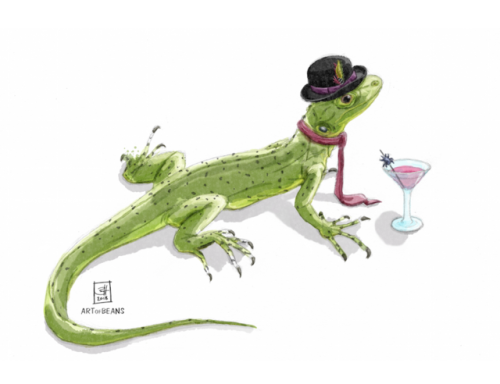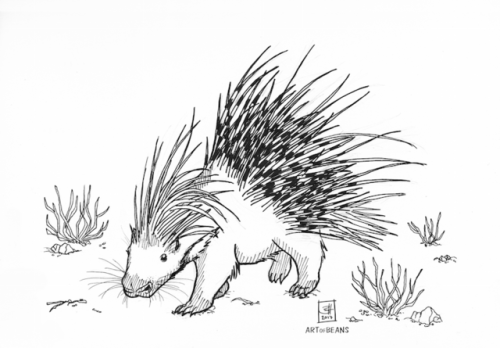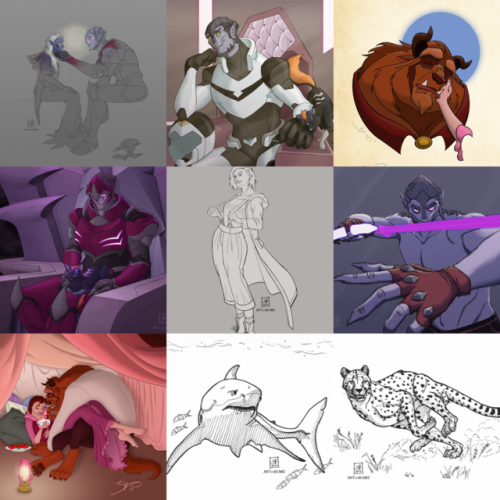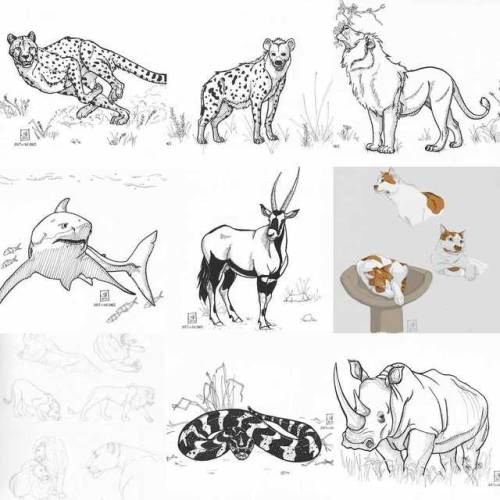#yegarts

Photo by Kayla Frioult
When you think about your favourite piece of tech, chances are it’s lightweight, high-speed, and small enough to always be wondering where you left it. That’s not the case for Daria Hirny. Her tech of choice? A three-thousand-pound, antique printing press. And it’s got three friends! In addition to her Heidelberg Windmill press, she has a Chandler & Price Platen from 1910, an Oswego paper cutter from the early 1900s, and a Challenge paper cutter from 1970. Good thing she also owns Homework Letterpress Studio, where she brings cards to life with hand-mixed inks, thick cotton paper, and a passion 500 years in the making. This week’s “I Am YEG Arts” story belongs to Daria Hirny.
Tell us about your connection to Edmonton and how it’s influenced your path.
I grew up in Edmonton as a first generation Canadian. My parents chose Edmonton out of all the other cities in Canada because of a few family connections, but generally they were on their own. To me it was all I ever knew, and I was able to build some really amazing friendships throughout grade school and University. As I age, I always find new ways to love this city and find inspiration. Edmonton is home, and it has given me the comfort and connection to share the things that make me happy.
How did you learn about printmaking, and why did it resonate with you?
When I was in my second year of my Bachelor of Fine Arts, I had an opportunity to take a printmaking class. It was all new to me. I didn’t know there were so many different styles of printmaking, I didn’t know that the University of Alberta had a world-class printmaking facility, and I didn’t know that I would be learning from some of the best people imaginable. I loved that there were so many different techniques to learn and that you could put your own spin on it once you learned how to use the machines and materials properly. It has a perfect blend of clean and messy, technical and exploratory, delicate and physical. There’s just nothing else like it.
What made you settle on letterpress?
I ended up settling on letterpress because I was interested in finding a career where I could straddle the line of art and graphic design. Throughout the history of letterpress, it has been used for all sorts of graphic design projects—posters, fliers, invitations, greeting cards, and anything that needed to be reproduced quickly with many copies before computers were invented. Because I wanted to make art that could be accessible to a wide variety of people, I realized that printing greeting cards on a printing press could be just the answer I was looking for.
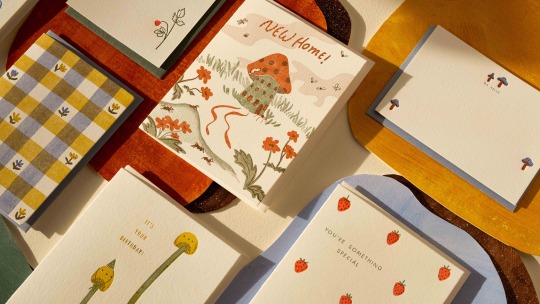

What from your everyday fuels your creativity?
I love watching the seasons change, seeing the bugs come out, and listening to the birds sing. I love having a nap in a hammock and feeling the sun on my face. Calm moments outside fuel my creativity and help me gain a fresh perspective on life.
Cards become such keepsakes in people’s lives. Do you hold onto them? Can you tell us about one?
When I was a kid, I used to keep every card I was given. Now I try to keep the ones that will bring me joy or surprise me when I reread them later in life. To be honest, I don’t remember any imagery on the cards I was gifted, but I do remember the messages inside. The ones that are the most important to me are the ones that show honesty and vulnerability. These are the messages that are usually too hard to say out loud to someone but can be written in a card and be reread over and over.
Who’s someone inspiring you right now?
Someone who is inspiring me right now is Meg Gleason, of Moglea. She uses the greeting card form to play with her own style by using letterpress and paint techniques that are truly one of a kind. She has a way of not letting the greeting card limit her in what she can do and instead uses it as a vehicle to share her art with the world. I find this incredibly inspiring.
What’s your favourite part of the creative process and your least favourite?
Seeing my designs come to life in letterpress is definitely my favourite part of the creative process. With all letterpress projects though, there is usually a lot of prep work. This is probably my least favourite part because there is a lot to do, it can be overwhelming, and it usually involves things like measuring, which can easily go wrong.
The printing press is one of the most important inventions of all time. What does it mean to you to be part of print culture?
One of the reasons I love letterpress is because of its long history and its beautifully designed machines. I feel empowered to use these machines as a woman in a city where there aren’t very many letterpress printers. Because of the culture behind letterpress, there is a strong online community of letterpress printers who I have learned a lot from.
What are you currently working on or hoping to explore next?
Currently I am working on a new catalogue of greeting cards for Summer 2022.
You visit Edmonton 20 years from now. What do you hope has changed? What do you hope has stayed the same?
Twenty years from now, I hope to see more printmakers, more people trying letterpress, and more people being bold with their creativity. I also hope that the maker community is still as friendly and supportive as it is now.
Want more YEG Arts Stories? We’ll be sharing them here all year and on social media using the hashtag #IamYegArts. Follow along! Click here to learn more about Daria Hirny, Homework Letterpress, and its catalogue of greeting cards and other printed ephemera.

About Daria Hirny
Daria Hirny runs a letterpress printing company called Homework Letterpress Studio. Daria loves to bird watch, hike, and when she can, take a good two-hour nap. Each card is inspired by Canadian nature, vintage illustrations, and antique machines. The printing process has always interested Daria since she learned printmaking back in University. She settled on the letterpress process because of its printing speed, quality, and amazing engineering.

Her bio will tell you she’s a singer-songwriter and multi-instrumentalist who creates electronic/pop music with sincere, clever lyricism. But all it really needs to say is “rising star.” As overused an expression as that often is, there’s truly no better way to describe Tatiana Zagorac. And we’re not the only ones who think so. Nominated for Electronic/Dance Artist of the Year at the 2019 & 2021 Western Canadian Music Awards, Zagorac, known professionally as Talltale, is turning heads across the globe. Her one-two punch? Well, in addition to being formally trained, she’s simply all the things that can’t be learned: compellingly relatable, effortlessly funny, and a natural storyteller with an impeccable sense of timing—just don’t ask her to play tennis! This week’s “I Am YEG Arts” story belongs to Talltale.
Tell us about your connection to Edmonton.
Born and raised here! My parents both immigrated here from Serbia, and whenever winter rolls around we (half) joke about why they chose this city of all places. But I feel like I grew up with this city in a way, it’s changed so much in the time I’ve been alive. I travel a lot for music, and coming back to Edmonton always feels like home.
Was music always a natural fit for you? What was it about the arts that made you feel like it could be your community?
It was always what I wanted to do, but by no means was it a natural fit. Most artists have a story where they talk about being gifted from a young age, and I have no problem saying that absolutely wasn’t the case for me. I think it’s important to share stories like that! One of my best friends recently reminded me that while he got “Best Band Student” in Grade 8, I got “Most Improved,” and that’s the kind of attitude that’s helped me get as far as I have, I think.
In regards to community, I think it’s possible to find it anywhere, but I feel incredibly fortunate that I found a lot of my community while attending the MacEwan music program. It felt like one big family to me, and many of those people I’m still gratefully in community with to this day.
What led you to focus on drums and composing music?
Drums was a bit of a happy accident—I was assigned to clarinet in Grade 7 band and found that it wasn’t for me. Halfway through the year they held auditions for percussion, and I saw that as my only way out of clarinet, while still getting to take a music class. I never would’ve guessed that I would’ve stuck with it and that it would be my instrument of study in university years later!
Songwriting I started doing at a very young age, though originally just writing lyrics and only hearing the melodies and production in my head until I picked up guitar later (and then production in university). As I’ve gotten older, I feel more at home with songwriting, composition, and production as opposed to live performance, probably because I’ve done it more, but also because I really enjoy being able to present something exactly the way it was intended, without anything being left to chance.
You’re both self-taught and formally educated. What would you say have been the biggest pros and cons of each?
I think a big con of formal education is discouragement that is fostered through feeling a sense of “right and wrong” while creating your art, and also through your “ears” (in the case of music) getting better faster than your ability. A pro, at least for me, is that, as someone with ADHD, having deadlines and a formal learning environment was incredibly conducive to the quality and speed of my development. I also have a hard time learning concepts when there’s no one for me to ask questions of, so having instructors and peers to draw upon was crucial for me.

Tell us about someone who’s been a mentor to you.
One of my biggest mentors was the choir and theatre musical director at Strathcona High School, Stephen Delano. Looking back at 16-year-old me, I was honestly insufferable—I was shoehorning myself into extracurriculars that I didn’t make the cut for, I was prideful and stubborn, and I gave artistic advice to peers with an unearned sense of authority on the subject. But Stephen found ways for me to learn and participate and grow, giving me responsibilities with running rehearsals or teaching the cast their harmonies once I had earned the opportunity. He even helped me decide between a drum or a guitar instrument major for university! He saw the potential in me, and I became a better musician and person for it.
Who’s someone inspiring you right now?
I’m endlessly inspired by the other female artists in Edmonton pursuing music, in particular, Laur Elle and Margo. I’ve been fortunate enough to work on both of their projects in a few different capacities, and watching them grow so rapidly is incredible. While their musical success is certainly noteworthy, I’m most inspired by their confidence and sense of self. And on top of that, they’re truly two of the kindest people I’ve ever met! I don’t know how they do it all.
Tell us a bit about Talltale and how that journey began.
I always knew I wanted to be a musical artist (though I think the vision of what that looks like changes as you get older, and you get a clearer picture of your options). In my last year of university, I felt ready to try and record an EP. I knew I wanted to come out the gate with something that sounded professional, and at the time, the only pop producer in Edmonton I knew was Ari Rhodes. I did my first EP with him, graduated school, won HOT107’s Hot Factor competition half a year later, signed a publishing deal right after, and have been continuing to learn the business and refine my skills as an artist since! From about 2018 onwards, I began working with local producer Robbie Townsend (professionally known as Father Bobby Townsend), and that was when I started creating music that I felt sounded like me. Since then I’ve been selected for a number of national development programs, received several grants and awards, and travelled internationally to write for artists in Japan, Korea, Taiwan, and LA. It was not at all what younger me pictured, but in many ways it’s much cooler.
What excites you most about the YEG arts scene right now?
I very recently started collaborating with local writer/musician/owner of Glass Bookshop, Jason Purcell, on some of their projects, and it’s opened my eyes to how much of the arts community here I wasn’t acquainted with, despite growing up here. The music community is quite small in a way, so I felt like I was familiar with the arts scene, but I’m really realizing how many folks are doing work in fields like the literary and visual arts that I’ve never met. I’ve seen Jason pull these communities together through collaboration, and it’s very exciting. I think the arts scene in Edmonton is uniquely supportive and uncompetitive but still incredibly high quality, so it’s exciting to think about how further collaboration between disciplines will impact that.
Tell us a bit about what you are currently working on or hoping to explore next?
I’m currently finishing up an album! I’m very excited about it. I wanted to push myself musically to incorporate more electronic and orchestral elements, and I took a much heavier role in producing this record. I’m also really looking forward to putting together a great live show for it! With all the knowledge I’ve acquired over the years, it’ll be really fun to combine aspects of DJing, drumming, singing, and programming lights/visuals.
What makes you hopeful these days?
I wish I could say this wasn’t a tough question. I spend a lot of time kind of burrito’d in blankets feeling anxious and depressed about a lot of things. I think a lot of musicians would say “music,” but I even have a tough time doing music without wondering if I should be doing something that feels like it has more utility to people’s wellbeing. But I do think the one thing that makes me feel truly hopeful is community. As an individual, it’s easy to feel hopeless when you’re looking at problems on such a massive scale. But finding community allows you to create meaningful and impactful change with a group of people that is tangible.
Want more YEG Arts Stories? We’ll be sharing them here all year and on social media using the hashtag #IamYegArts. Follow along! Click here to learn more about Talltale and to check out the video for her latest single, “Tennis Club.”
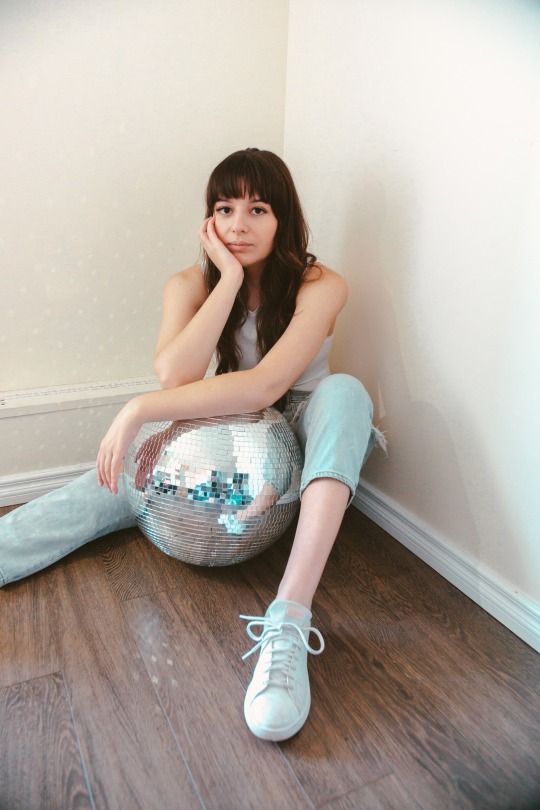
About Talltale
Amassing over 400,000 streams as an independent artist, Talltale is a singer, songwriter, producer, and multi-instrumentalist who creates electronic/pop music with sincere, clever lyricism. Her most recent single, “Tennis Club,” has received notable positive attention from outlets like Canadian Beats, Buzz Music, and VENTS Magazine, as well as a premiere for the self-directed and edited music video on Indie88. Her live show sets her apart from other artists in her genre, as she plays a standing electronic drum set while singing. Her previous work has earned accolades such as Best Electronic Song of 2018 in the Canadian Songwriting Competition, Artist to Watch at the EMAs, and two nominations as Electronic/Dance Artist of the Year at the Western Canadian Music Awards.
The lead single, “Tokyo,” off her previous album, A Japanese Fever Dream, was placed on curated playlists and played across CBC, Sirius XM, and college radio, while the music videos for “Tokyo” and “Shed My Skin” were on rotation on Stingray’s 4k. Upon the end of the album cycle, Talltale was invited to perform at the Canadian Embassy in Tokyo. She regularly writes for other artists internationally, and has participated in several CMPA international writing camps. Talltale was selected as an export-ready artist for the Canadian Passport Summit in 2022 and is currently working on her next release.
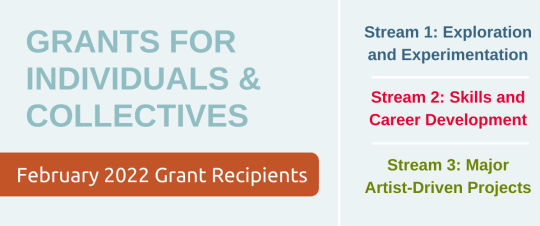
Through the Grants for Individuals & Collectives program, the Edmonton Arts Council supports a wide range of art forms and practices to foster experimentation and exploration, creative collaborations, and public presentations, as well as activities to invest in the individual skills of artists, including mentorships and professional development.
For the winter 2022 intake process (deadline of February 15, 2021), more than 341 eligible applications were assessed. Of these, 97 grants were recommended by the peer assessment committee for investment. Focusing on fostering experimentation, supporting artists from equity-seeking groups, and professional development and mentorship (addressing the Aims and Actions found in Connections & Exchanges: A Ten-Year Plan To Transform Arts & Heritage in Edmonton) a total of $1,199,490 will be invested in Edmonton’s arts community through this round of Grants for Individuals & Collectives.
Interested in applying? Our next deadline for the grants for Individuals & Collectives program is October 1, 2022. You can find more information here. Looking for other grant opportunities? The EAC is currently accepting applications for the Equity and Access in the Arts grant program, and the Arts Presentation Fund for COVID Recovery and the 2022 Connections & Exchanges Initiatives program. Click here for more information about the EAC’s suite of grant programs.
Curious about the successful applicants from the February 2022 intake? Read on…
For stream 1 of the program – Exploration and Experimentation – 36 applicants were recommended for funding ($5,000 each) for a total investment of $180,000. Congratulations to the following recipients:
- Amanda McKenzie will extensively research and spend time in the field to expand her series Enticement. Using the time and resources she plans to explore new mediums, techniques, and additional subject matter.
- Andrea Bellegarde Courchene will explore visual representation of histories of Indigenous Nations in Canada. The goal is to create a “graphic novel” with fabric and mixed media (such as beads and ribbons).
- Arsan Buffin will research and develop a Euro-style (worker placement) board game about the early days of the fur trade around the Hudson’s Bay in what was once known as Rupertsland.
- Christine Hanson plans to explore and invent fresh musical processes to create a new ‘palette of sound’ to further deepen and develop her personal creative aesthetic, and future works.
- Cynthia Fuhrer will produce paintings exploring new methods of creating patterns and surreal imagery.
- Daniel Belland will strengthen his music production skills with the intent of furthering his solo artist voice.
- Darren Lebeuf will create a series of children’s books based on various Canadian artists of different genres (musician, chef, writer, dancer, etc.), exploring both the tangible and intangible things that they do.
- Derek Jagodzinsky will research and develop a collection of wearable art that represents six tribes in the Treaty 6 area.
- Deviani Bonilla will research in-situ performances and dance in public spaces as the first step towards the creation of a dance performance in the summer of 2023.
- eryn tempest will use the funding for 6 weeks of creative research into dance in virtual space using 3D modelling and motion capture software.
- Gabe A'tugwewinu Calderon will outline and write a rough draft manuscript of his science fiction, Indigenous futurisms novel Pinàshkà.
- Gabrielle DeGouw will test materials and weather-proofing processes, for displaying lanterns at future outdoor galleries.
- Gregory Mulyk will refine modern composition skills of orchestration and virtual instrument midi programming through the creation of several new large scale ensemble recordings using virtual instruments.
- Hans Olson will develop film concepts which are grounded in the experimental boundary between narrative fiction and documentary.
- Jane Heather will gather information, facts, and stories while travelling to Fort Smith NWT to speak with residents about her mother, a teacher who was there in 1948.
- Jason Chinn will research voter opinions in the field as a volunteer election canvasser in the lead up to Alberta’s 2023 provincial election.
- Jenna Chalifoux will begin her initial research and draft writing phase to understand and describe the lives of Métis, First Nation, and Settler women of Edmonton through time.
- Karissa Barry will re-learn works she choreographed 15+years ago and investigate how physical restrictions may develop into new artistic opportunities as she navigates her dancing body at 40 years old.
- Kathleen Ochoa will undertake solo movement research, along with collaborative guidance and workshops from dramaturge/experimental theatre playwright/director Kristine Nutting.
- Leslea Kroll will adapt her play 'The Light Fishers’ as a novella.
- Lexi Pendzich will research and develop a visual narrative that reflects on women and LGBTQ+ skateboarders, in contrast to the context of a primarily male-dominated sports and cultural activity.
- Luciana Erregue will complete the first draft of her memoir in essays, As We Sit at the Table, encompassing her early life in Argentina under a military dictatorship and her current life in Canada.
- Madison Dewar will create a series of large, mixed-media tapestries to discuss caves as a source of both fear and compulsion.
- Marilyn Langevin will experiment with natural and synthetic materials to develop a pseudo-cloth with unique textures that will be used in creating a model for a third marble sculpture.
- Matthew Weigel will research and create a multimedia chapbook of poetry that prints poetry on the surface of movable, changeable wooden blocks, utilizing place-based knowledge of Edmonton’s land and history.
- Megan Dart will research and write a one-act play exploring the true story of a long-haul Canadian truck driver who has, over the span of a 40-year career, witnessed real-time ecological collapse.
- Mika Haykowsky will undertake interdisciplinary research-creation using objects designed for the body and lens-based explorations, bringing together computer engineering and the human body.
- Natahna Bargen-Lema will create a first draft of an experimental memoir of 80,000+ words centered on themes of grief, religious trauma, queerness, and the neurodivergent childhood experience.
- Oluwadamilola Oladosu will explore and create a visual EP with some existing and several new songs.
- Penelope Moon Walker will research and capture the stories of her community’s traditional language holders and traditional artists who are keeping the language and traditional arts alive, and honor them through contemporary paintings.
- Peter Midgley will conduct research towards completion of his novel, The Dendrite.
- Premee Mohamed will work on the first draft of their novel The Obscurantists, told in a series of linked essays.
- Rayanne Haines will research and write the first draft of a non-fiction collection of essays and poetry that explores the spaces we inhabit between the spaces of grief, identity, and aging.
- Riaz Mehmood will research and learn the techniques related to handmade artist books.
- Sheldon Hughes will explore the role of Indigenous cultural ceremony in lyrical composition as a healing modality for intergenerational trauma and healthy, holistic community development strategies.
For stream 2 of the program – Skills and Career Development – 13 applicants were recommended for funding for a total investment of $85,215. Congratulations to the following recipients:
- Alex Vissia will take part in an 8-week, self-directed program of training with vocal coach/vocologist, Carol-Lynne Quinn, and study in dance/movement with Larissa Kovalenko and Rhythm FX instructors in Edmonton, AB.
- Alma Visscher will expand and develop her skills in natural dyeing and silversmithing with an 8-week fabric dyeing course and a 1-month silversmithing course.
- Anna Marie Sewell will attend the London Book Fair, to build on connections made at the 2021 Frankfurt Bookfair and continue learning about international rights.
- Bryan Saunders will undertake a 4-week mentorship in the circus art of corde lisse with Emiliano Ron, one of the world’s most advanced and innovative corde lisse artists.
- Cherelle George will focus on gaining more experience within Caribbean Dance styles, specifically focusing on Trinidadian Caribbean Folk Dance.
- Donita Large will enhance her professional skills as a songwriter through a mentorship opportunity with an award-winning Producer/Musician/Singer/Songwriter.
- Jessica Sanderson-Barry will enhance her skills and knowledge while focusing on the methodical process of scraping and softening traditional hides in an urban setting.
- Jia Jia Yong will pursue deeper appreciation and understanding of Chinese traditional music and develop skills for performance through learning the konghou, a Chinese harp.
- Lora Brovold will undertake an Assistant Director Apprenticeship under Heather Inglis, Artistic Producer of Workshop West and Director of Tell Us What Happened, that premiered at Workshop West in May 2022.
- Sara Isabel Figueroa will undergo three-week self-directed research of Brazilian vernacular, social, and Afro-Brazilian dance styles, and culture.
- Scott Berry will work with a mentor to help him develop the skills needed to plan and install permanent murals.
- Sophie Healey will be participating in Ghost River’s Intensive development workshop to develop her skills as a performer and theatre creator alongside other emerging and established theatre artists.
- Taylor Fawcett will create realistic and balanced orchestrations through workshops and mockups with mentor and internationally renowned composer Ciara Proznik.
For stream 3 of the program – Major Artist-driven Projects – 48 applicants were recommended for funding for a total investment of $934,275. Congratulations to the following recipients:
- Ainsley Hillyard will be conducting a movement research project exploring the use of vibration in place of sound or music, culminating in performances at SOUND OFF.
- Boyd Whiskeyjack will organize a showcase featuring a Drag Queen performance, Indigenous Runway Fashion, and Powwow Dance style categories inspired by the Savage X Fenty Show.
- Breanna Barrington will presentDig, a durational community engaged performance situated within a back alley in Edmonton’s theatre district. Documentation for this project involves Zines and a recycled Free Library.
- Carley Okamura will use the grant for the Model Minority Project.
- Carly Neis will create a cabaret style show full of songs and stories about friendship and disability told through two different perspectives.
- Chenoa Anderson will rehearse and professionally film two collaborative improvised works for musicians and dancers in an urban permaculture garden.
- Cheyenne LeGrande’sprojectMullyanne nîmiw will explore Nehiyaw femme identity, exploring ideas of protection and movement as healing, ancestral knowledge, reclamation of traditional practice, and Nehiyaw fashion.
- Christina Battle’sthe air we breathe will expand on her experimental documentary exploring the complexities of air pollution by weaving together themes of environmental catastrophe, cultural and political strife, and conspiracy.
- Connell Stinnissen, a member of the band Good Information, will record the Good Information’s full-length album, “Hurry” - the group’s first major collection of recorded music that is slated to be released in March of 2023.
- Connie LeGrande will produceKakisimo, a full-length Cree language music album for the retention and revitalization of the Cree language.
- Connor Yuzwenko-Martin will produce an all-Deaf stage production performed in ASL using an original script written by Connor, which itself is inspired by Doctor Faustus and Connor’s own experiences of queerness and loss.
- Corine Demas will mount a production of Resting Sadface, a storytelling show with live performances of comedy and music, at the Edmonton International Fringe Festival.
- curt young will create a weekly live stream podcast that will focus on Indigenous Men’s Health and Wellness.
- Don Berner will produce a quarterly concert season for professional large jazz ensemble for the 2022-23 Season.
- Dylan Howard will complete the final edit, sound design, and colour correction of a micro-budget feature film to be submitted to film festivals around the world.
- Elena Belyea and her theatre company Tiny Bear Jaws will produce the world premiere of the new play Io through the Common Ground Arts Society + Why Not Theatre’s 2022 RISER Project.
- Emily Bachynski will record a second album with the band Bad Buddy.
- Emily Chu will create a mural celebrating Chinatown’s heritage at the Edmonton Chinatown Multi-Cultural Center, while hosting mentorship opportunities for three emerging local artists.
- Eva Colmers’ innovative shadow puppetry, lyrical story and soulful, original accordion music will swirl in a visually and acoustically lush short film about a swallow’s quest to help others.
- Huai-Yang Lim’s new art exhibition will feature artists of Asian heritage who use video and film to produce new understandings of Asian diasporic communities’ experiences and perspectives that challenge existing mainstream representations.
- Ivy Cardinal will create an illustrated book about a girl in who is protected from the atrocities of the Indian Residential School system by a kind bear spirit.
- Jacqueline Ohm will produce a debut EP for her musical project, Conjvr.
- Jessica Holtby will produce a pilot episode of the children’s series “The Seeka Show”, and pitch to broadcasters and streaming platforms.
- Jim Head will use the grant funds for the photography, design, manufacturing, and distribution for an original jazz CD recording.
- Jose Canga will produce and launch his first album, in the genre of World Music (Ethno-Jazz and Semba).
- Kate Stashko will create and produce a double bill of dance titled “basin | The Space Between Us”, to be performed in Summer 2022 at an unconventional space in Edmonton (ex. warehouse, empty retail space).
- Kathryn Ryan will collaborate and research, produce, and direct a production of the musical Sweeney Todd.
- Kerri-Lynn Reeves will complete an Artist-in-Residence program to produce and exhibit a body of artwork.
- Lianna Makuch will present the world premiere ofAlina by Lianna Makuch from May 26 - June 5, 2022.
- Lizzie Derksen will create a draft of a novel.
- Manuela Wuthrich will capture Nuela Charles’ 2022 album release with a live concert performance video. Recorded live off the floor on location, the project will be an all-immersive video experience.
- Marc Siegner will create a suite of lithographs, rendered in sepia tones, featuring images that oscillate between nostalgia and timelessness, resulting in a kind of docufiction that focuses on local backyards.
- Maya Candler will create a new body of sculptural work using medical thermo plastic and fibre arts to map bodily trauma and the process of healing.
- Mehdi Rezania will host a series of events featuring Persian classical and Western classical music and poetry in Persian and English.
- Mpoe Mogale will undertake an interdisciplinary collaboration between Black Albertan artists that will culminate in an art-film shot in Breton, Alberta – one of the five original Black settlements on the Prairies.
- Nadien Chu will present KL and the Wolf, the story of a woman who is of mixed racial Chinese heritage, born in the 1900’s, trying to navigate her place in the world.
- Naomi Jichita will record an EP of six original songs, create promotional materials, and host an album release show with their indie/folk band, Payphones, with a team primarily comprised of queer and/or disabled artists.
- Nisha Patel will write a substantial second draft of an experimental poetry manuscript focusing on the lived experience of disability and illness as a queer South Asian woman.
- Paul Cournoyer will assemble a team to produce and record an album of original songs.
- Robert Tyndale will decode the process of digital creation with darker skin tones and uncover solutions through conversations.
- Rubim de Toledo will create a three-song music performance video for promo and social media use.
- Ruth Alexander will premiere Dead in the Water by Ruth Alexander, a play with songs for a solo female and a piano.
- Salem Zurch will produce a short film, “Outlaw Love”, to be created with the support and mentorship of instructors at Solidarity Film Camp, Tamarra Lessard and Andrea Beça.
- Thomas Tunski will release EGO volume two, a weekly new media digital publication created to uplift local artists through engaging photos/graphics, interview videos and performance videos.
- Tim Brown and the band Striker will embark on a North American tour, supporting European metal band Beast in Black for 20 performances, with 5 additional routing performances as headliner.
- Tracy Carroll will undertake pre-production design development and a multiple day workshop leading up to a première production of The Space Between Stars.
- Vern Thiessen will present a musical based on the award-winning novel THE ENGLISHMAN’S BOY, where the settler artists write the first half of the piece, and the Indigenous artists write the second half.
- Yasser Abdel-Latif will produce a creative non-fiction book about an acclaimed Egyptian writer, and his ventures in the side scenes of the Canadian democratic institutions, while working as an interpreter for injured immigrant workers.
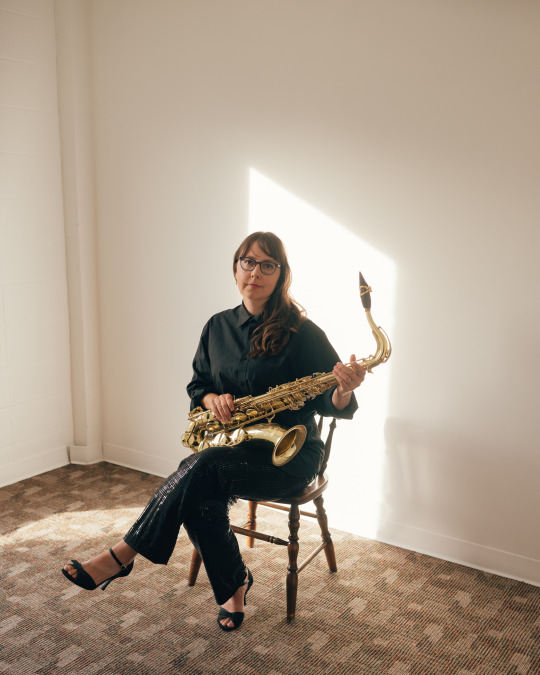
Photo by Dhakshboo Photography
There are those who lead and those who follow. Saxophonist Allison Balcetis is the best of both. As a musician, teacher, collaborator, and performer, she has a lot of roles and responsibilities, but none delight her more than receiving the handoff from the composer—a moment she calls “the relay.” A close second best? That’d be the launch—a.k.a., sending out the music to the world. It’s no surprise then that the name of her album, Relay. Launch., is a celebration of that process. Sending music out to the world is exactly what she’ll be doing June 18, when she performs with the UltraViolet ensemble, presented by New Music Edmonton. Until then, and long, long after, you’ll likely find Balcetis doing what she knows best: championing the strength of multiple points of view, appreciating the foundation of family, and finding magic in the process. This week’s “I Am Yeg Arts” story belongs to Allison Balcetis.
Tell us about your connection to Edmonton and what keeps you living and working here.
I came to Edmonton to earn my Doctorate in Music from the U of A in 2007. I knew only one person here, William Street, who was my supervisor, and that was it! Beyond the very supportive community within the department of music, around 2010 I joined the board of New Music Edmonton (NME), a contemporary music concert non-profit, and that organization’s members and employees added immeasurably to my sense of belonging. The combination of rigorous study at the University with producing concerts with NME really professionalized me. It formed the basis of my arts network and has grown to include work with dancers like Gerry Morita of Mile Zero, Jen Mesch, poets like Shima Robinson, and other amazing musicians. I currently live about 2,400 miles from my nuclear family, but I feel so lucky to be both rooted and supported here by artists who want to play and make things together.
What drew you to the saxophone? Was it a natural fit or something you grew into?
I guess I came from a lineage of saxophonists, starting with my mother who played in high school, to my older sister (4 years older), and then me. My whole family is musical: my dad plays accordion and ukulele and sings in his church choir, my mom continues to play piano and is an avid concertgoer, and my sister continues to play saxophone. They’re all professionals in other fields, but my family was always going out to concerts.
They supported me early on by providing me with private lessons to supplement my public-school band education, and then my older sister went off to get her Bachelor’s degree in music and psychology, so I had a model of what was possible beyond high school. My sister and I would play duets together and, eventually, we busked together as a duo, so I had to be up to snuff at an early age or our act would fall apart! She kicked my butt in the best way possible, and I know I wouldn’t be here without that early inspiration.
Tell us about someone who’s been a mentor to you and how the experience influenced your path.
Well, beyond my sister, I’d have to say another early mentor was a jazz vibraphonist and drummer in Omaha, Nebraska (where I grew up). His name was Luigi Waites. You should google him, he’s a legend! He ran a jazz workshop for junior high and high school kids each spring and taught us the basics of jazz improvisation. He grew really close to my family, and I considered him like one of my grandparents. He jokingly called my mother his parole officer! He taught me about performing under pressure, not dwelling on mistakes in the moment, and being a reliable professional musician. He allowed me to play sometimes with his amazing band, Luigi Inc, in a bar before I was of-age (no period after “Inc” because It means “including,” not “incorporated.” This was the core of his spirit)! He and his bandmates were so supportive and treated me as a peer. I love and miss him dearly.
What’s one piece of advice you wish you’d had starting out? And what’s something you knew instinctively?
When I was in school studying music, I wish there had been more diverse music integrated into the curriculum. The post-secondary system of music education in North America is still pretty Euro-centric (even more so a while back), and I bought into that model. As a player of a non-orchestral instrument, for years I felt like the saxophone’s repertoire (and by extension, me) was not sophisticated enough, like I was studying music that (A) was just not as relevant to me as it was for my orchestral-instrumentalist peers, and (B) that I was all the lesser for it.
What did I know instinctively? I’m not sure, except that very early on I had the support of my family to study music in university, so if not “instinctively,” then at least early on I knew the inherent value of being a musician—that it’s important and worthwhile. It’s quite upsetting to work with students who are going against their parents’ wishes to study music. I admire their tenacity because it isn’t easy even in the best circumstances.
How important has collaboration been to your career, and why are you drawn to it?
Since moving to Edmonton, collaboration has been the focus of nearly my entire career. At the core of it, I guess it’s because I believe in the strength of multiple points of view when making something. I value the humility it takes to recognize that no one is an island. Perhaps the dread associated with climate anxiety and the fate of the planet (and then the myriad local issues as one zooms in) is better served by teaming up together. I think it’s true in matters of civics and democracy—and in creating art.

Relay. Launch. cover art by Parker Thiessen
Tell us a little about what your creative process looks like.
One aspect of my practice is to work with composers who are writing for the saxophone, whether it’s solo or in small groups. In this case, I research who interests me (and perhaps I’m already friends with them), and propose they write a piece for me or one of my groups. Then, if we’re successful in securing funding, the creative process begins. Sometimes composers want to know what I, specifically, can do on the saxophone, what I prefer, and what I excel at or find cumbersome. Then they start writing, sending me sketches of ideas, or simply asking if a certain musical gesture is possible. This can be a back-and-forth that lasts several months. Next, they send me a complete draft. After I prepare it, I’ll play it for them (this is often, say, about a few weeks before a public premiere), and they might find it necessary to make some small edits if there’s a discrepancy between what they imagined and how I played it. Then, it’s time for the public performance!
I love this process. I’ve done this with students who are assigned to write for me for school, as well as with professionals. In fact, I’ve probably done this process at least 100 times, and I really love being that half of the equation—the sounding of the thing that was written on paper. There’s a whole philosophical discussion to be had about when an idea becomes music. I like being in that timeline.
Who’s someone inspiring you right now?
American flutist Claire Chase is a big career inspiration for me. She founded the incredible International Contemporary Ensemble and has since moved on to a thriving solo career with a project that entails commissioning a slew of works each year. I admire her self-starting entrepreneurism and her commitment to the music of today.
Locally, there are several people who inspire me for their creativity and captivating performances: textile and sound artist Kelly Ruth, flutist Chenoa Anderson, poet Dwennimmen, percussionist Mark Segger, and dancers Gerry Morita, Jen Mesch, and Good Women Dance. This is only the beginning of my list though!
What are you currently working on or hoping to explore next?
I’m currently in between two concerts with my quartet, UltraViolet, where we’re premiering eight new works! Our second show is June 18.
Over the past few months, I have started some initial fiddlings with pedal effects on my saxophone, primarily for improvisation. I’ve been really inspired by the noise artists and improvisors in town who take either traditional instruments or atypical instruments and play them through various pedals, loopers, etc. It’s a mesmerizing performance, and I’m just starting out with it. My friend Kelly Ruth, for example, literally plays her weaving loom this way! She’s the one who encouraged me to plug in and amp up, so to speak.
Describe your perfect day in Edmonton. How do you spend it?
If we’re talking a Saturday or Sunday, I’m fortunate to live a few blocks from the south-side Italian Centre, so a pastry and latte is a great start. Then I’ll take my Chow Chow, Thor, to Buena Vista dog park. After that, the day might have a rehearsal with one of my groups, and the evening would involve attending a live show somewhere!
What excites you most about the YEG arts scene right now?
I love the cross-pollinating performances: the young jazz musicians who play a freer set with some of the more avant-garde “classical” musicians; the dancers who produce a visually stunning show with the visual artists and set designers; the poets who trust the musicians to improvise behind their words. Though the growing lack of affordable venue rentals is quite worrying to me, this is the kind of activity that buoys me and gets me really excited to be a part of this city.
Want more YEG Arts Stories? We’ll be sharing them here all year and on social media using the hashtag #IamYegArts. Follow along! Click here to learn more about Allison Balcetis, UltraViolet’supcomingJune 18 show, and her digital album, Relay. Launch, the proceeds of which go to Hares Outreach, a local mutual-aid network focused on advocacy, street outreach, and harm reduction.

Photo by Dhakshboo Photography
About Allison Balcetis
Internationally recognized as an ambitious contemporary saxophonist, Allison Balcetis has studied and collaborated with artists from around the world. Her international performance career includes concerts throughout North America, Europe, Brazil, Thailand, and Taiwan. Recent projects include partnering with André Mestre to create Curto-Circuito, a yearly workshop for young Brazilian composers, which has seen the creation of over 30 new pieces for saxophone and piano since 2014. Other creative partnerships include Colin Labadie, Ian Crutchley, Nicolás Arnáez, Thierry Alla, Rodrigo Bussad, and André Ribeiro. Her work as a soloist and chamber musician has produced over 100 world premieres.
As a faculty member of the University of Alberta since 2009, Allison trains the next generation of thoughtful, artistic musicians, teaching saxophone, chamber music, woodwind techniques, and aural skills. Outside of the university, Allison helps develop the contemporary arts community as former President of New Music Edmonton. From 2015–2018 she was co-curator of SubArctic Improv and Experimental Arts, a monthly concert series pairing dancers, musicians, text, and visual artists in a totally improvised context that saw over 200 artists grace its stage.
Allison’s recent chamber activities include the Edmonton Saxophone Quartet, improvisation ensemble damn magpies, UltraViolet ensemble, and work with Edmontonian musicians and dance companies, such as the Jen Mesch Dance Conspiracy and Mile Zero Dance.
In 2007 Allison co-founded Anubis Quartet, a Chicago-based ensemble with more than 30 commissions and premieres of provocative new music, performing with them until 2014. During her undergraduate degree, Allison won first place in the Fischoff National Chamber Music Competition in 2005.
Allison holds a Doctorate in Music from the University of Alberta where she studied with William Street. She also holds degrees from Bowling Green State University where she studied with John Sampen and is the first—and only—saxophonist to earn a joint degree from the Université de Bordeaux and the Conservatoire National de Région de Bordeaux where she studied with Marie-Bernadette Charrier.
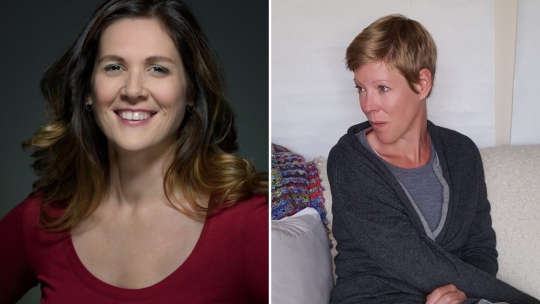
Yorath House artists Christine Lesiak and Kerri Strobl, photos supplied.
Since the end of March, Kerri Strobl and Christine Lesiak have been the artists in residence at Edmonton’s historic Yorath House. During their residency, the artists brought their different artistic practices together – Kerri is a writer, poet and visual artist, while Christine is a theatre creator – for an exciting new collaboration that explores memory, ancestry, and nature through a live-performance work.
As the duo conclude their time at Yorath House, we caught up with the artists to reflect on their residency, the time to collaborate, and any future plans. Read on to discover how their residency took them all the way from theatre, poetry and music to experimenting with clay seed balls (and how you can make them yourself at home!).
Sometimes plans can change over the course of a residency project. Now that your residency is coming to an end, can you tell us how your work evolved from your original proposal? Were there any interesting surprises or new ideas?
Artist residencies are vital to evolving artistic practice. As full-time independent artists, it’s incredibly rare that we have focused, supported time for creative research. It offers the possibility to create something boldly new by working with an artist from a different discipline. In a residency like Yorath House, we have the freedom to experiment, learn, and evolve.
Our initial proposal was to write and develop a live-performance work about memory, ancestry, and nature, centred around a collection of poetry and accordion melodies that Kerri wrote while living for three years in the forest and tending gardens. For about the first ½ of the residency, we worked toward the goal of a live performance, but then we discovered that wasn’t the right choice. Instead, we switched our focus to rehearse and audio record Kerri performing her poems, with support from her beautiful accordion, named Alice. It was also around this 4-week mark that we wondered if an 8-week long residence was too long, but we soon realized that’s actually when our collaboration truly grew deep, deep roots. It’s when our most profound and vulnerable work began to emerge.
We also experimented a lot with clay forms and seed balls as a method of conscientious planting. We tried lots of different clay forms and shapes and structures to see how the seeds would germinate. But at the end of the day, it was the centuries-old ball shape that pleased them the most.
Do you feel like the physical space at and around Yorath House influenced your process(es) and the work you produced during your residency? If so, how?
The grounds of Yorath house are peaceful and inspiring. We were able to harvest some seeds from the grounds - wild roses, Yarrow, Yellow Dock. We found it was very helpful to be around nature and observe the slow slide into spring when working on themes that hold seeds and planting at its centre. Having a dedicated studio space meant we could be totally focused on our residency, free of distractions.
Describe your artistic practices in relation to one another’s. How did you combine, influence and play off one another’s distinct processes during the residency?
Kerri is an interdisciplinary artist who has worked across Canada, the U.S. and Europe with various types of folk. Her practice explores Land, Plant Medicine (European Tradition), Spirituality and Ancestry through installation, sculpture, performance, sewing, and video. Christine is a theatre-artist with a specialization in interactive comedy, performer-created work, empathy-based experience design, and site-specific performance. As a new collaborative duo, we discovered that we both had tremendous expertise to share with one another. Kerri shared her settler plant knowledge, and art-therapy and trauma-informed principles and practices. Christine shared her performance, voice, and experience creation knowledge and experience. This artistic exchange cracked open both our core practices. It is the type of learning that comes from extended engagement and conversation. It is integrated into our bodies and practice, and we will apply our learning in our respective communities for the rest of our careers.
How do you think the work you produced during your residency will inform future work? Do you have plans to continue to collaborate?
The work we completed in the residency was a vital step in exploring what a truly transformative performance work around Kerri’s writings could look like. As settlers, we worked to be very careful to ensure the poems and settler seed knowledge we investigated did not go anywhere near what might be Indigenous knowledge. However, we discovered that there is the very exciting possibility of a future performance work that would involve collaborating with one or more Indigenous artists. Until those conversations happen, we can’t know where this particular work will go. No matter the outcome, it’s clear that we have a lasting creative connection, and we expect to continue to be in each other’s creative lives.
Based on your experience, who and what is the residency good for?
This residency is ideal for two artists who want to engage in a deep, meaningful, and respectful artistic exchange. People who are curious, who want to learn from each other, share their practices, and discover what might emerge.
You briefly touched on creating clay seed balls as one of the core components of your residency. How do the interactive seed balls relate to your work?
Clay is a metaphor for the human body, we are made of the same material as clay; some scientists have even postulated that life started in clay. When we manipulate clay, it elicits a pre-cognitive, pre-language response in our brains. This can put us in touch with buried memories and emotions that we may need to explore for personal growth and healing. Our residency started with a clay exploration Somatic engagement as a part of an interactive, multi-sensory experience as a way of creating a united grounded and open energy. Additionally, we celebrate the miraculous growth that comes from a single seed. In our case, we looked at the bean seed (Phaseolus vulgaris) specifically as a heritage crop that moved from hand to hand from their origins in Peru, all the way around the globe, as it adapted to each new ecosystem.
_______________________________________________________
Are you interested in learning more about how you can create your own clay seed ball sculpture? You’re invited to join Christine and Kerri on May 18, 2022, at the City Arts Centre (10943 83 Ave NW) from 3:30-5:30 pm for a family-friendly event to learn to make your own tiny clay and seed sculptures that you can place in your garden and watch grow.
Come and get your hands into the dirt and clay and hear some stories about how the humble bean and many other plants traveled the world over to become the food and plants we have around us today!
If you are unable to attend in person, the artists have graciously provided instructions that you can find below.
Field Notes from Yorath House: Making Seed Balls
“This is a story that starts with the smell of good black earth” - from Black Earth, a poem by Kerri Strobl.
WHY SEED BALLS?
Seed balls have been used since ancient times. People used seed balls to replant large areas with great success: In Egypt, seed balls were used to restore farmland after the Nile’s annual spring flood; in India, they were used after the monsoons; and there is some evidence to suggest it was also used in the “Americas”. As people travelled, they brought their seeds with them and traded with other groups. Different types of bean seeds became a type of calling card, since they are easily distinguishable and beautiful, as they come in vast colours and patterns, like precious stones.
In the early twentieth century, microbiologist and agriculturist Masanobu Fukuoka revived the practice, incorporating it into his “natural farming” movement. He referred to them as “a small universe within themselves” He made thousands and thousands of seed balls to cast all over his family farm in Japan and made careful observations on how they behaved, remarking that the seeds will wait to germinate until the time is right.
And in the 1970’s, they were incorporated into the tactics of “Guerrilla Gardening“, a movement which seeks to highlight issues of food security, food sovereignty, and equal access to quality food. Do you remember seeing Sunflowers in empty lots around the city last year? It could have been some seed balls at work there.
Today, seed balls are proving themselves to be a successful and efficient method to reforest and replant native plants in India and Kenya.
Seed balls are easily and inexpensively prepared, transported, and planted (well, it’s fun since you can just throw them!). The clay protects the seed against birds and animals that might eat it, and it helps hold in moisture until the seed is ready to germinate.
We know that native species have been negatively impacted by invasive species. We can help moderate this by planting species that are native to the region we are planting in. The city of Edmonton/amiskwaciwâskahikan is situated in a unique ecosystem where many beautiful and unique plant species thrive. One awesome resource for finding out more is the Edmonton Native Plant Society. http://edmontonnativeplantgroup.org. Another great reason to create seed balls is that it helps out native pollinators like the Mason Bee and Butterflies.
WHAT YOU NEED!
~1 cup compost or potting soil
~1 cup wet clay*. We used some old Plainsman clay (Buff Stone) and rehydrated it. It’s nice if it’s a little bit on the wet side compared to what you would use for sculpting.
- Seeds. We had fun using climbing bean seeds and alfalfa seeds because they germinate quickly. But you can use anything, really.
*You can use dry clay powder and mix it.
STEPS:
- Mix the clay and the compost/potting soil. Dig your hands in. Really squish it and mix it well. The mix should hold together easily. If it’s crumbly, add more water.
- Once it’s all mixed, pinch off a bit of the mix, and roll it into about a 1-inch ball.
- Push your bean seed into the centre of the ball, and tuck it in snuggly.
- Put some alfalfa seeds on the outside of your ball.
- (Optional) Let it dry for two days. Do this if you want to preserve the seed for a longer period of time, or if you want to toss the seed into hard-to-reach spaces. Store dried balls in paper or cardboard, not plastic.
- When you want them to work their seedy magic….
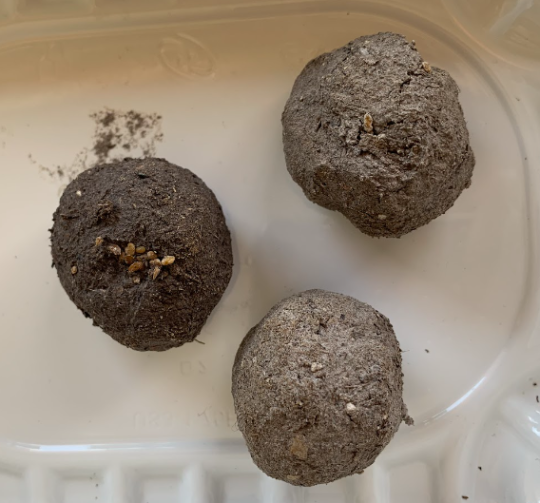
Nestle your ball gently on top of some soil, indoors or outdoors. If you water the soil it will activate the seeds right away.
Here are some photos of our seed ball-friend’s journey. We started ours indoors in a tray with potting soil.
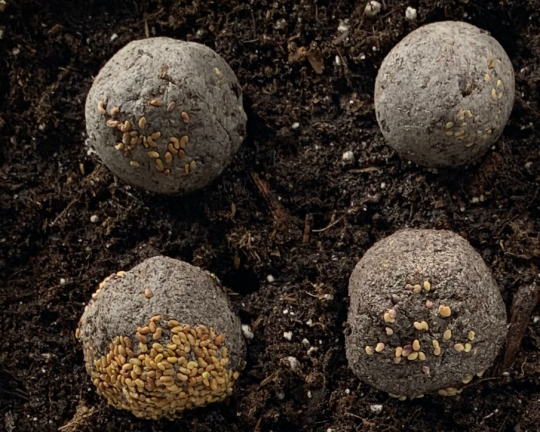
Here you can see the alfalfa sprouting. Once they were large enough, we had them as a yummy snack!
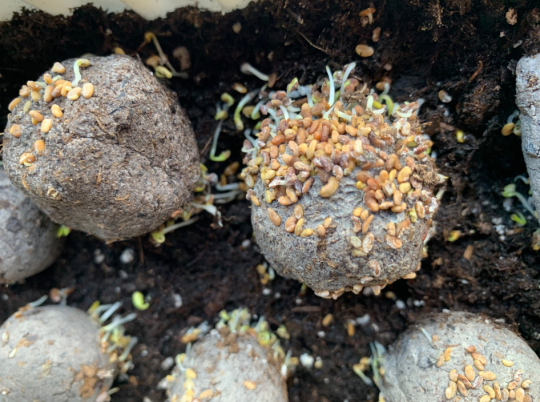
It’s a very exciting day when the ball cracks open. Each seed picks it’s own journey in time and space. The early-birds pop out about 5-6 days after they get water.
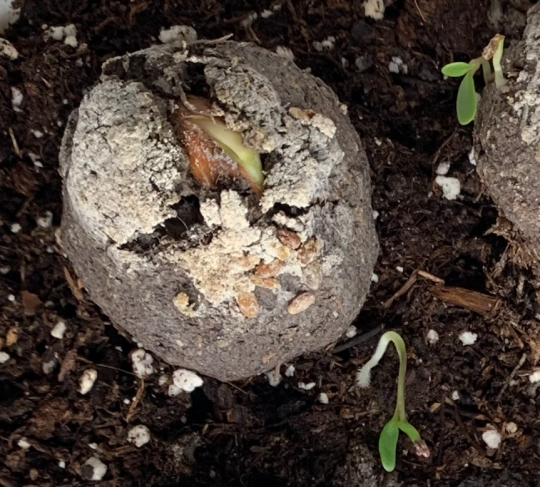
Tiny roots working their way through the clay.
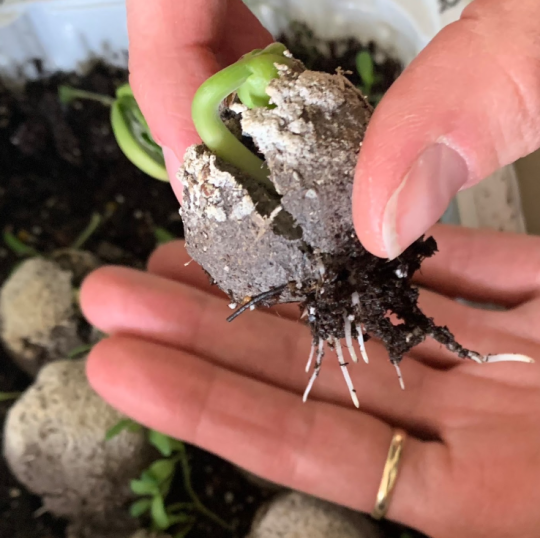
The next day….
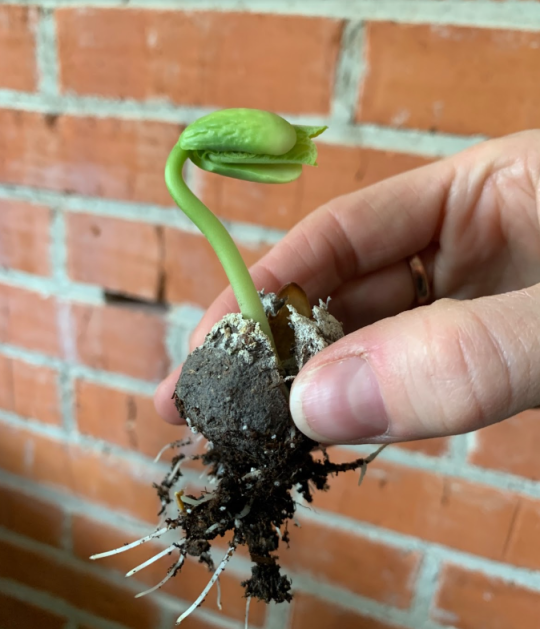
And a few days later, the boldest of the beans demands to be transplanted into the garden.
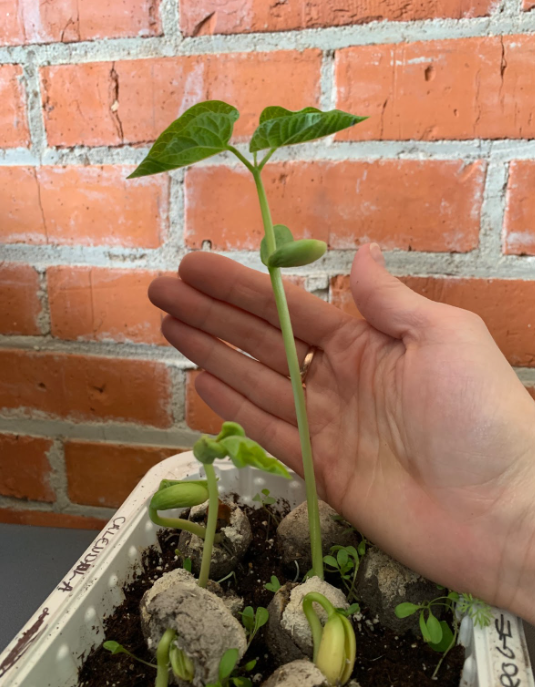
We enjoyed this resource for all the ins and outs of seed ball making: https://seed-balls.com
________________________________________________________
Black Earth
By Kerri Strobl
This is a story that starts with the smell of
good black earth
warm and damp
in the
Early Summer Sun,
it sounds with bees in the flowers
the breeze in your hair,
and placing bright shiny white bean seeds into freshly dug
holes
This is the story of the smell of a small house,
its perfume is of sour cabbage leaves, cream and bacon fat,
This is the story
of whiskey glugging into a glass, ice cubes that crackle
It’s the story of hands with scars from life’s long work.
It’s a feeling of treading in footsteps
that are both your own and of ones
who have gone before you.
It is dug deep, dug deep, deeply in gratitude for the life that has been placed before you
It started with a need to move,
to find belonging and to grow.
It comes together with love, forgiveness
and of leaving things
behind,
forgetting.
Forgetting, it is the story of those who are Lost as well Forgetting
it is a story we all know, we share it,
like the sound
of a heart beating
We don’t think of it,
The music moves me.
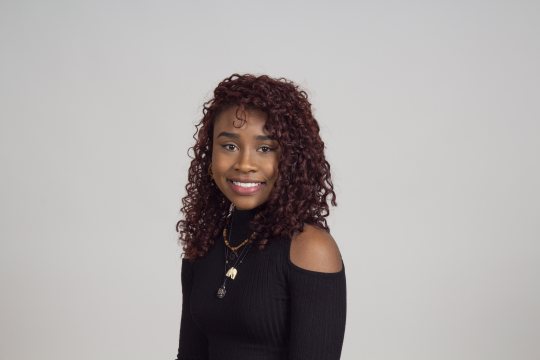
You don’t continually need to be making art to be an artist. There will be moments when you’ll be stuck, and that’s okay—you’re not losing the art in you. Those wise words belong to artist Raneece Buddan, who learned that truth soon after completing her BFA in Art and Design. As you’re about to discover, art and self-awareness go hand in hand for Buddan. In her work she focuses on her cultural identity, being of Afro and Indo-Caribbean ancestry, by using fabrics to symbolize the beautiful merging of both cultures, as well as the discomfort she felt around her hair and skin tone from childhood to her teenage years. Introspective, innovative, and inspired by process—This week’s “I Am YEG Arts” story belongs to Raneece Buddan.
Tell us about your connection to Edmonton and what keeps you living and working here.
My mother lived in Edmonton for a few years before being transferred to Fort McMurray for work. When I immigrated to Canada in 2015 from Jamaica, I spent my first year in Fort Mac before moving to Edmonton to attend the University of Alberta, after being accepted for their Fine Arts program. I have since lived here throughout my degree, and now two years after completion, I have stayed to grow my practice as an artist. Thankfully, Edmonton provides opportunities and funding for emerging artists that I have and will continue to make use of as I grow as an artist and build my CV.
What’s the first thing you ever made that inspired your artistic path? Did you know then that you’d unlocked something?
I was always a creative “artsy” child. The first thing I remember creating and being really proud of was a project for second grade, at age seven. It was a dollhouse made out of a cardboard box, covered in construction /cartridge paper, with added hand drawings. I remember being so proud of it because it was so neat and perfect—plus my teacher kept it years after. From then on, I continued making random stuff, and in high school, I finally had art classes from 7th–11th grade, which gave me access to artists (my teachers), new processes, and materials. This is where I first used clay for portraiture and began collaging and experimenting with textures in my paintings. Clay and collaging techniques are now major parts of my art.


Top: Blooming ancestry, 2019-2020, ceramic, fabric, plaster,21x12.5x19.5, photo supplied. Bottom: To Fit But To Stand Out, photo by Charles Cousins.
Tell us a bit about your process and use of material exploration.
My process in both my sculptural and painting practice has evolved into me finding my abstract figures within the material and being led by the material. I find figures within the grains of the wood (e.g. baltic birch plywood in my paintings), which I then cut out and intuitively add elements of the human figure, as well as fabric, both the real thing and painted. I strive to have my hand-painted fabric be as close to the real thing as possible. That means colour-matching and mimicking line weights and designs almost exactly.
In my sculptures, I follow the curve and natural grooves of the wood, and in my clay work, whatever abstract forms came from pounding the clay. Often times I’ll create small studies for my paintings and sculptures using a variety of materials to then translate into larger pieces.
Having recently completed your BFA in Art and Design, what’s your transition been like from student to working artist? What skill/wisdom have you leaned on most?
Initially, in the first year, I was incredibly burnt out because I went straight into an internship at Latitude 53 right after finishing my final year, which was from fall 2019 to summer 2020. I took no time off, which contributed to more burn out, so I wasn’t inspired to do art. I didn’t create any new work for almost a year. This was very hard, and I felt discouraged because I had been consistently making work throughout my degree, so I questioned whether or not I’d ever make art again. Eventually I had to make work because I’d received funding from the EAC with a report due. Through experimenting, I was able to get back into the rhythm of things for a couple of months, though I then stopped again for a few more months, however this time guilt-free. I realized then it was okay to not make work constantly. I also realized I knew nothing about being an artist outside of an academic setting, so it was unnecessary to be as hard on myself because I was still figuring it out and that “when it happens, it’ll happen. No need to force it.” I’ve been working at Latitude 53 for almost two years now, and I am happy with my work/art life balance.
What would you say are your greatest artistic sensibilities, and how do you nurture them?
I think I’m able to notice the small things—the microdetails. And I take satisfaction in (1.) noticing them and (2.) appreciating them by making them more visible by highlighting, transforming, or simply leaving them as-is; specifically for someone like myself who gets pleasure in seeing what has been overlooked to discover themselves.
What does community mean to you, and where do you find it?
I guess community means commonality, support, and being able to come together to enjoy and appreciate? I am happy to still have a small art community with some of my past classmates at the U of A. Even though we don’t share a studio space together anymore, we still make the effort to support one another online and in-person, whether that’s cheering each other on when we make something new or attending each other’s exhibitions. I have also found a growing community with Black creatives in Edmonton, whom I connected with through the 5 Artists 1 Love exhibition. The first time was an Artist Battle I did in 2019.


Top: Within this Vessel, photo supplied. Bottom: Entwined, ceramic, wood fabric, 2019-2020, photo by Charles Cousins.
What’s something you’ve learned about yourself through your work?
I am very capable and am able to do anything once I put in the time and effort. I’m very proud of myself for that. I also learned I’m a perfectionist who always wants to keep things within the lines and very pristine—a gift and a curse.
Tell us a bit about what you’re currently working on or a technique you’re hoping to explore next.
Currently, I’m designing and printing my own fabric using screen printing and block printing. Fabric is the main component in my work, and I think it would be beneficial for me—and also a matter of authenticity—to know what certain symbols mean within the textile. Also to research and know exactly where my fabric is from and the process behind its creation. Through this, the process is a major part of the art piece as well.
I’m currently working at a small scale, but I’d like to work larger. I would also like to learn how to weave, as the textiles I’m researching are mostly weavings I’ve simplified, so it’d be interesting to actually make the weavings I’ve been researching and inspired by.
Describe your perfect day in Edmonton. How do you spend it?
I’m a homebody and an introvert, so I prefer to just spend as much time by myself in my own space. But if the weather is nice (a.k.a., it’s summer), sometimes I like to visit the park (e.g. the Paul Kane Park) and just lie there in the grass soaking up the sun and enjoying the fresh air, maybe watch the ducks be ducks. I enjoy just doing nothing—absolutely nothing. It’s a luxury and peak relaxation.
Want more YEG Arts Stories? We’ll be sharing them here all year and on social media using the hashtag #IamYegArts. Follow along! Click here to learn more about Raneece Buddan, her work and where to follow her on social media.

My Knots, fabric, synthetic hair, and oil paint on wood, resin,12x20, 2021, photo supplied.
About Raneece Buddan
Raneece Buddan is a Jamaican artist who moved to Alberta in 2015 and completed her BFA in Art and Design at the University of Alberta in 2020. In her work, she focuses on her cultural identity being of Afro and Indo-Caribbean ancestry, showing the beautiful merging of these cultures, as well as the discomfort she felt around her hair and skin tone from childhood to her teenage years. This is depicted by replacing her skin tone with fabrics meant to represent each culture and the use of synthetic hair. Her process is based on material exploration and finding figures within the material, the grains of the wood, and mounds of clay.
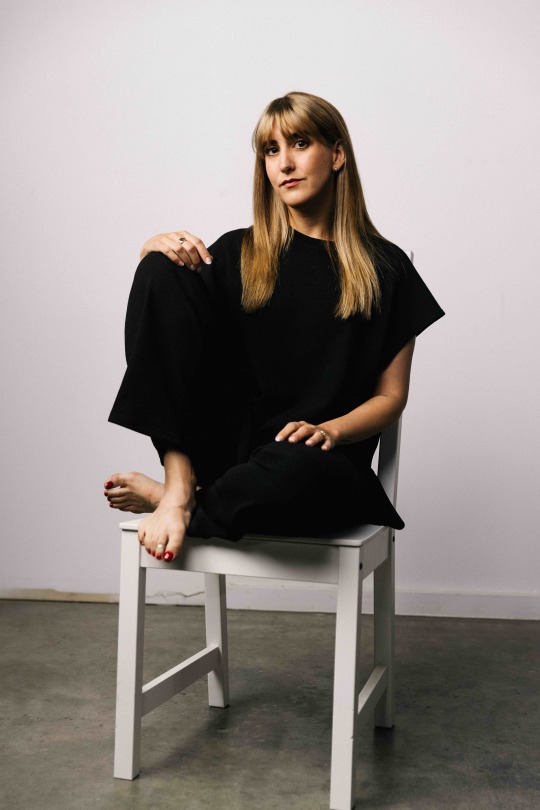
Photo credit: Cooper & O’Hara
Ever thought of our bodies as beacons and receptors in relationship to one another? Interdisciplinary artist Stephanie Patsula has. And a lot. Her live performances and immersive art installations explore her curiosity about the choices we make in relationship to each other and the environment around us. Safe to say, unpredictability isn’t something she shies away from. Just as significantly, neither is collaboration—a gift that continues to influence her work in ways she could not have dreamed. Best of all? It all started here in our arts community—a place she feels upheld, challenged, and understood. This week’s “I Am YEG Arts” story belongs to Stephanie Patsula.
Tell us about your connection to Edmonton and what keeps you working and living here.
I lived between Edmonton and Strathcona County until my early twenties when I relocated to Winnipeg, Manitoba, to start a BFA. It wasn’t until moving back to Edmonton, after a 10-year hiatus, that I started to integrate myself into the local arts. I began an MFA at the University of Alberta in the fall of 2018, as well as an internship at dc3 Art Projects—these two institutions were an excellent entry point for getting to know a variety of individuals at an accelerated pace.
What has kept me living and working here has been an ecosystem of artists, arts initiatives, and creative spaces. Edmonton has a very inviting and supportive art community, and I am truly grateful to all those who have encouraged me to participate within it.
What was it about the arts that made you feel it could be your community?
The arts have always been a space that I felt upheld, challenged, and understood. So with that said, I gravitate towards the arts and arts community wherever I live.
What is it about lens-based work that resonates with you and your artistic sensibilities?
Photography and video work resonate with me, as so much of what I currently create is rooted in the presentation of the live body and live performance. Lens-based practices allow for me to document work and use that documentation as ephemera or objects that can be presented separately or installed as a satellite to live performance(s).
You’ve said that your work “prioritizes embodied research, exploration of site(s), reciprocity through sound and symbology, while attempting to approach concepts of relational ethics, cultural ritual and spirituality.” Can you unpack that a bit for us?
The way that I think about it, embodied research, exploration of site, and reciprocity are almost one in the same. I am motivated by the desire for connection. To feel and be felt, I rely on my body, the places I inhabit, and the people and things around me to activate the relationships found in the performances and installations I build.
I am curious about the choices human beings make in relationship to one another and how a variety of moods or atmospheres can be created depending on the variables or constants in an environment. Currently, my interest is in exploring sensorial memories, and I tend to cite and generate instances of echoic and iconic memory when attempting to create a new narrative through my artwork.


Top: Stephanie with Flexible Hours performing in Iceland, photo provided by Outvert Gallery. Bottom: Whitemud Creek Ravine field recording, photo by Eric Fraser.
Tell us about someone who’s been a mentor to you.
I would like to shift the way that I define the experienced and trusted advisors in my life, opting for a less linear or hierarchical way of characterizing those who have helped to shape me at a variety of intersections of my career. For that reason, I embrace the nuance involved with personal growth and the variety of sources and stages of career that care, support, and shared knowledge can be derived.
I have had the privilege of knowing a wide range of this community’s multifaceted participants and can wholeheartedly state my gratitude to several people who have invested their time and energy towards helping me on my path. Although each of these individuals intersect with the arts in varied ways and with differing perspectives, each of them has underscored the importance of patience, inclusion, and innovation through their own actions, and each of them has generously helped me navigate how to be a better artist and community collaborator.
What makes these folks so fundamental to my time here is that they have led me to trust in my own ability, intuition, and pedagogical approaches. I really respect and value “mentorship” that places the autonomy of the “mentee” at the helm, and I hope that if I ever find myself in a similar position, I can provide the respect, critical feedback, and opportunities I have been afforded during the time I have known each of them.
What’s your favourite and least favourite parts of the creative process?
I would say that both my favourite and least favourite part of my creative process comes from a place of failure, or at least what I would deem failures in the work that I create. I have been unsuccessful in my practice and research on numerous occasions, but the way I interpret and respond to things going wrong has really changed in recent years.
Despite how disheartened I feel at the moment, these uncomfortable circumstances are very pivotal and help me to stay motivated to do better and learn. I find the process of moving forward towards a solution extremely rewarding.
What has the arts community taught you about yourself? And how has it influenced your work?
Being a part of the arts community has taught me the value of creative collaborations amongst peers. This has influenced my work in ways that I could not have dreamed. I am able to co-create projects with skilled technologists and artists in a way that I could not do alone.
Tell us a little about what you’re currently working on.
At the moment I am working on a performance-driven collaboration between myself and live composer Eric Fraser, called Flexible Hours. We are working with a variety of collected and created audio textures to build sound arrangements that vary in mood, tone, and function. The piece we are rehearsing is called “Beacon,” and we are performing on April 28th, in Calgary, as part of The Grand YYC ‘Live & Local’ event.
When you think YEG arts, what are the first three things, people, or places that come to mind?
When I think of YEG arts, I think of:
- Mile Zero Dance—an incredible artist-run space lead by Artist Director Gerry Morita and General Manager Kelly Ruth.
- DIY—Edmonton is full of really inspired pop-up galleries, artists creating and self-funding events, River Valley exhibition spaces, and outdoor shows…
- Grant and project proposal writing with my pal, Eryn, at Kaffa off 109th—because this has been crucial to maintaining the financial support needed to explore and research. It can be a challenging and confusing experience, but is made so much better with a coffee in hand and a friend nearby.
What are you looking forward to most this spring and summer in Edmonton?
I love the River Valley, and it is pretty special that I can access the longest stretch of connected urban parkland in North America. I enjoy venturing out with a number of sound-recording devices and collecting a variety of soundscapes and textures from different sites around the city. There is so much to listen to, and I am really looking forward to doing more of that as the weather gets warmer.
Want more YEG Arts Stories? We’ll be sharing them here all year and on social media using the hashtag #IamYegArts. Follow along! Click here to learn more about Stephanie Patsula and her work.

Sympathetic Resonance still at FAB Gallery, photo by Luke Johnson.
About Stephanie Patsula
Stephanie Patsula is a Canadian interdisciplinary artist. The projects she creates are focused across a variety of processes coalescing in a union of somatic experiencing, experimental sound creation, and lens-based ephemera. Patsula’s work prioritizes the creation of immersive art installations and live performance, which explore bodies as beacons and receptors in relationship to each other. Her processes embrace the unpredictable dynamics of working with new materials, spaces, and bodies by corresponding with them improvisationally—a technique that reflects a personal desire for reciprocity and intimacy through an attentiveness to collaboration and adaptability.
In addition to her art practice, Patsula aims to foster connections within the local art community, working with project spaces and arts incubators to activate sites with programming, interventions, and events. Patsula holds a MFA in Intermedia from the University of Alberta, and she is an MFA candidate of the Sound dept. at the School of the Art Institute of Chicago.

Photo by Nadia Jade Photography
It is always better to be loved by few than liked by many. Emmet Michael knows this and couldn’t be more grateful. If you don’t already know his name, he’s a singer-songwriter winning the hearts and attention of music fans with his debut album, I Hope You’re Home. It’s an album that’s both an unflinching look at life as an outsider and the power of feeling at home in one’s own skin. As you’ll soon discover, this artist’s openness to talk about music is as generous and moving as his ability to write it. Equal parts grit and grace, this week’s “I Am YEG Arts” story belongs to Emmet Michael.
Tell us about your connection to Edmonton and why you make it yourhome.
I was born and raised in Edmonton. Up until recently, I spent a lot of time wishing I lived elsewhere. As time went on, I found more and more reasons to appreciate it here—particularly its vibrant arts and music scene. Even artists in more metropolitan cities, such as Vancouver or Toronto, are raving about the opportunities and support networks in Edmonton.
Alberta is a strange place to find yourself in as someone who is a part of a minority group—but Edmonton seems to be a safe hub for people like me. People in Edmonton appreciate and uplift unique voices in music in ways I think rural Alberta communities have yet to do.
What are your musical influences, and where do you see/hear them reflected in your work?
I grew up in the Christian church and was first introduced to music through worship. I think that’s a lot of where the more “ethereal” and “ambient” sounds in my songs come from. Despite never having written worship songs, I’ve been told often that they have a “worship music vibe.” Watching my mom sing on stages at church was what first inspired me to become a performer.
In my adolescence I really fell in love with emo music, and then later with more “folky” singer-songwriter types. Some of my favourite artists include: Manchester Orchestra, Brandi Carlile, Corey Kilgannon, Ruston Kelly, and Phoebe Bridgers. I listen to a lot of different genres and find that a little bit of everything makes it into my own sound. I don’t ever want to stay married to one particular avenue or get pigeonholed into a single style. I think the one thing that all of the artists I listen to have in common is the depth of meaning in their lyrics. They’re all poets in their own way, and that’s what I aspire to reflect in my writing as well.
What is the songwriting process like for you? Where do you usually begin?
My songwriting process is always quite abstract. Inspiration often hits at really inopportune times, like while I’m at work, driving, or in the middle of the night when I should be sleeping. I try to take advantage of it whenever it comes because it doesn’t come all that often. Most commonly my process is sitting down with a guitar or at the piano and tinkering around until something resonates. At that point, the words just follow naturally and are often just an expression of whatever I’m wrestling with at a given time. It’s always been a very personal and very cathartic experience for me. I live with a lot of anxiety and overthink everything. When I sit down and write a song, it’s a time where my mind is actually quiet enough for me to process underlying emotions. Having something tangible at the end of all of that—a fully completed piece of music—is just an added bonus to the whole experience. Writing lyrics enables me to actually understand and communicate what I’m going through in a way that I’ve always struggled to articulate in words.
What does community mean to you, and where do you find it?
As someone who hasn’t always felt a sense of belonging, community is life-saving. As a queer and transgender individual growing up in a religious community, I always felt a sense of loneliness and “otherness.” I felt like I had to suppress who I was in order to be accepted. I think authentic community breeds the opposite of that. It is about finding people who not only accept you as you are, but CELEBRATE you for who you are. I found that in the Edmonton arts community, at open stages in particular. These were places where you were encouraged to listen and share the things that make us all the most human, in a language that everyone understands—through music.
Tell us about someone who’s been a mentor to you.
I have had a lot of important mentors throughout my life and career, too many to name them all. One of the most prominent was Rhea March. I met her at one of her open stages almost a decade ago, when I first started performing my original songs. She helped me get some of my first gigs, interviewed and aired my music on her show, It Takes a Village, on CJSR radio, and later got me my first larger-scale opportunity at Canmore Folk Music Festival, in 2019. Among offering me support professionally, she also encouraged me personally. Early on, I dealt with a lot of self-doubt and struggles with mental illness and addiction. She saw my potential from the very start and helped coax it out of me. I will forever be grateful to her for that above all things.

I Hope You’re Home album cover. Photo by Nadia Jade Photography
What’s one piece of advice someone gave you growing up that turned out to be true. What’s one piece that didn’t hold up?
One piece of advice given to me at the beginning of my music career was to be able to take constructive criticism and “no's” well. If you manage to persevere through enough times hearing “no,” you were bound to get a “yes” eventually. I most certainly found that to be the case. I still get declined opportunities all the time, and sometimes it really stings, but the wins I’ve experienced as a result of pushing through have been well worth all of it.
Before recording my first project, the 5-song EP, I Feel Like I Just Woke Up, in 2019, I was told by someone in the industry that my songs were never going anywhere unless I made them more “mainstream.” I was encouraged to warp my sound and lyrical content to fit what he thought the greater public would be most apt to consume. The reality is that people gravitate the most to people who are authentic in what they create. I have learned the importance in knowing that it is always better to be loved by few than to be liked by many. A small audience of people who really resonate with what I’m doing will always mean more to me. The numbers don’t matter as much as people seem to think they do.
Tell us about the role that funding and awards have played in your career. What doors do they open for artists?
Funding has played an invaluable role in the advancement of my career. It is because of grants from the Edmonton Arts Council, The Alberta Foundation for the Arts, and FACTOR that I was able to afford to record and market my debut full-length album, I Hope You’re Home, released in May 2021. Having a professionally produced, full-length album put my name on the map in a way that it hadn’t been before. I had music played on radio across Canada, including CBC and SIRIUS XM radio. I had interviews on Global News and CTV Morning Live. I am now being offered far more performance and showcasing opportunities, which have allowed for me to be able to support myself financially in a way I couldn’t before. Just recently, I was awarded the Edmonton Music Prize for my album. The prize money will allow me to invest in my career even further, through the purchase of better equipment, studio time, and the cost of accommodations for touring.
I would not have been able to continue investing in my growth without these supports, and I am just so grateful to live in a place that values investment in creative work. It is my hope that I can use these investments to enrich my community the same way it has so greatly enriched me. These types of funding and awards help connect artists to their potential audiences, record music they might not otherwise be able to afford to, and promote the economy of Edmonton arts as a whole.
What makes you hopeful these days?
In recent years, I have watched Alberta embrace more diversity in the music scene. There have always been plenty of talented artists that are 2SLGBTQ+ and/or BIPOC, but now they are being given a platform. We still have a long way to go, but progress is happening. That gives me hope for the future of music in Edmonton and in Alberta.
Tell us a bit about your latest album, I Hope You’re Home, for which you were awarded the 2022 Edmonton Music Prize. What inspired it, and what story did you want to tell?
I Hope You’re Home is a culmination of all of the experiences I had that made me the person I am now. It expresses the longing for a feeling of “home,” not as a place, but as a comfortable existence in your own skin. There are songs on this album that I wrote as a teenager, and others I wrote just a couple of weeks before getting into the studio. Each song is a snapshot of a point in my life where I was really wrestling with something. Some of those things included: coming out as trans, going through an addiction, battling mental illness, grieving a loss, and trying to discover what love means in all it.
Years from now, when you look back on this album as a snapshot in time, how do you hope to finish this sentence: I didn’t know it at the time, but…
I am worth more than the story I tell.
You visit Edmonton 20 years from now. What do you hope has changed? What do you hope has stayed the same?
I hope that people are less afraid to express themselves as they are—for how they identify and who they love. I hope none of that matters at all. I hope that we continue to cultivate a culture of collaboration over competition. I hope there are more opportunities created for open and honest dialogue. I hope that we continue to see an Edmonton full of arts and music festivals and events. I hope that we continue to expand upon investment in art and music, as I believe these mediums are imperative to social change and a thriving community.
Want more YEG Arts Stories? We’ll be sharing them here all year and on social media using the hashtag #IamYegArts. Follow along! Click hereto learn more about Emmet Michael, and visit the EAC’s website for more information about grants and awards that support artists.

Photo credit: Kassia J Photography
About Emmet Michael
Introspective and enthralling, with equal parts grit and grace, Emmet Michael is a musician who was built on his trials. Turning to music in his darkest times, he found solace in his ability to share his heart with others through his lyrics. Drawing on his experience of transitioning from female to male, living with mental illness, and battling addiction, his songs carry a tone of desperation and sorrow. With soulful melodies and heart-wrenching lyrics, his music conveys a message that is both powerful and vulnerable. Entirely unique, yet familiar.
There is a lifetime’s worth of honesty and vulnerability encapsulated in the Edmonton Music Prize Winning album, I Hope You’re Home, the debut full-length album released in summer 2021. A bold, unflinching look at life as an outsider before undertaking a journey of self-discovery that would help mould him into the person he is today, it is the sum of those experiences that resonate throughout the course of the record.
Recently showcased to larger audiences at Canmore Folk Music Festival, Festival Place, and the Northern Lights Folk Club, his live shows provide an experience simply too incredible for words. His eloquent storytelling pairs perfectly with an always evocative performance, allowing those in attendance to connect to him, themselves, and each other.
Raw vulnerability is what will always set Emmet apart. He bares his soul in a way that is sophisticated far beyond his youth. This is only the beginning for this talented songwriter.
“I Am YEG Arts” Series: VISSIA
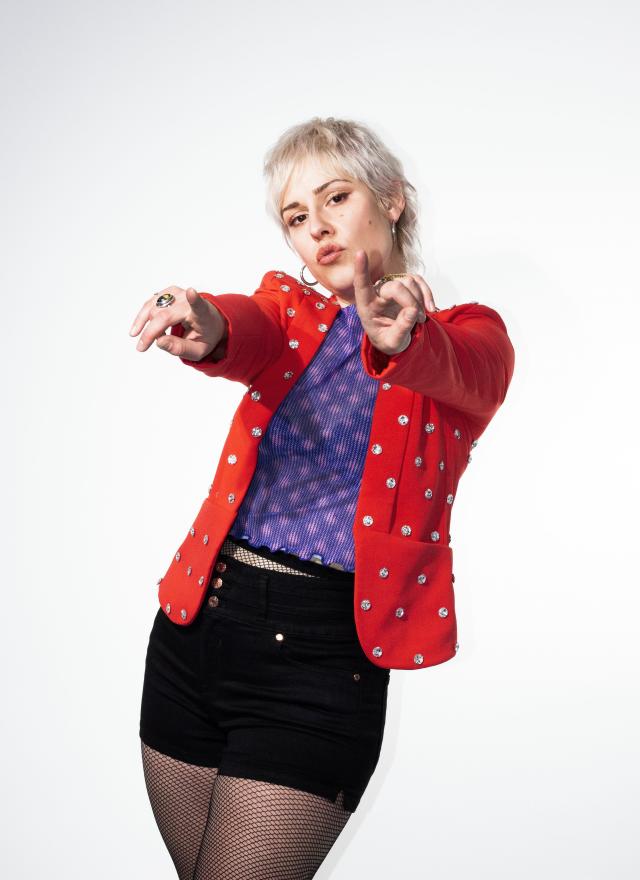
Photo credit: Kane Wilkinson
There’s always more to discover. But for singer-songwriter VISSIA, the through line is always emotion, and her new album is no exception. Titled, With Pleasure, the compilation is a reflection of just that: taking pleasure in the whole process of being here and creating something out of nothing—discomfort and all. That journey is exactly what her curiosity craves. Rather than stepping where she’s already been, VISSIA’s embracing the challenges that come with venturing out past one’s comfort zone. And she’s doing it—With Pleasure. This week’s “I Am YEG Arts” story belongs to VISSIA.
Tell us about your connection to Edmonton and what keeps you working and living here.
I settled in Edmonton permanently when I was studying music at MacEwan in 2010 (It’s actually kind of wild to look at that. I’ve been calling Edmonton home for 12 years!). Edmonton is the only city outside of my hometown (Stony Plain) that I’ve ever lived, and going to university here put me in touch with creative collaborators I am still working with to this day. I’ve seen venues sprout up and grow—and also go.
I’ve made friends in the arts community who have moved on to other places. I’ve stayed. I can’t say whether I’ll stay forever—the future is unknown—but Edmonton has been good to me. It’s where I played my first shows as a solo artist. I appreciate how unpretentious and creatively inclined this place is for artists. And there is always more to discover, within and outside of the arts community, which is exactly what my curiosity craves.
What are your musical influences, and where do you see/hear them reflected in your work?
My musical roots are steeped in the country and folk traditions of songwriting, and those styles will always have a place in my heart, but in the past couple of years I have been really influenced by pop-leaning styles of music—pop, R&B, soul, rock. I listen to a lot of music from both indie and mainstream artists, anything from Lady Wray to The Weeknd to Hovvdy. The way that pop music connects with so many people across cultures and geography is so fascinating to me. I don’t love all pop music—a lot of it is not made to last—but the stuff that cuts to the core of the human experience in a way that hooks and begs to be listened to over and over again is something that I’m interested in exploring more. I dug into this exploration with my most recent album, With Pleasure. I think my roots show in songs like “Doorway” and “I Just Wanna Hold U,” and then with the rest, I’m pushing into new (to me) musical territory. The through line is always emotion.

VISSIA performing live in Kingston. Photo credit: Kane Wilkinson
On the business side of being an artist, what’s one decision you’ve made that’s moved your career forward in a significant way, and what’s something you wish you’d passed on?
The business side of being an artist involves so many more small decisions than really big significant ones, I think. It’s about consistency in work ethic and learning how to decide which opportunities are right for you as an artist, and which ones are not. I think how one does that is by constantly reconnecting to one’s values and reasons for doing this line of work and learning how to weigh risk versus potential positive impact. The more that I stay grounded in myself and what is true for me, the easier it is to say, yes, to the right opportunities and, no, when it just isn’t the right fit for me. Passing on something that doesn’t feel right or make sense creates space for the things that do. Through it all, I try to stay centred and focused on what I am looking to accomplish and trust that what is for me is already on its way to me.
What was the first song you remember wishing you had given to the world?
I remember being completely intrigued by “Vincent,” by Don McLean, when I was probably 11 years old or so. The Best of Don McLean CD got a lot of spins in my household—my mom’s influence—mostly for “American Pie” and this one. I’ve been a hard-falling romantic since I was young, and this beautiful song felt so tragic to me. The melody is gorgeous and a joy to sing, and I loved the challenge of trying to learn the finger-style guitar accompaniment. I didn’t even fully understand the meaning behind it at first; I just knew it made me feel deeply.
Tell us a bit about your latest album, With Pleasure, and what the highlights have been for you so far.
With Pleasure has been playful and explorational for me as an artist and performer. When I initially sat down to write for the album, I had a different title and intention. I thought I was going to write something closer to my previous album, Place Holder, which is more of an alternative, roots-leaning singer-songwriter album. When I was initially denied funding for a grant I had applied for, I decided to take a step back and really figure out what I wanted to experience artistically with this album. Rather than taking steps where I’d already been, I decided to move into a new direction and embrace the challenges that come with venturing out past one’s comfort zone. The process was all about play and fun—and pleasure. So that’s where I got the idea for the title of the album. It doesn’t mean that this is an album full of experiences that are entirely pleasurable. It’s about taking pleasure in the whole process of being here and creating something out of nothing, discomfort and all.
In addition to receiving some really lovely press and feedback from the UK, US, and across the globe, highlights for this album have included landing at #7 on CKUA’s Top 100 Chart for 2021, going on tour and playing to sold-out shows across Alberta and Ontario with Toronto duo USS, and now embarking on my own Canadian tour, followed by an international festival showcase at c/o Pop in Cologne, Germany. With every album I make, I feel like I am coming more into myself as an artist and person, and With Pleasure is a personal highlight in my own emergence.

Album cover of With Pleasure.
What does community mean to you, and where do you find it?
Community is like chosen family to me. It’s about gathering and nurturing all of the one-on-one relationships. I find community when in relationship with people who reciprocate support, trust, and vulnerability. Community is fluid and changes all the time though. Some people will be with me for decades, but I also accept that some people are in my life for only a season. I just want to connect with people who share my values, goals, and passion for creating. I also love how we can be connected over distances, and in that way, community is not limited by where one is physically.
Tell us about someone who’s been a mentor to you.
My stepdad, Ted, has been a significant mentor to me; not specifically related to music and what I do in my career, but a mentor in life and growing up. He’s seen me through some of my
biggest personal struggles and helped usher me along my personal growth journey. I feel very lucky to have him in my life as someone I can turn to for advice, a second opinion, or just an ear to listen. He always makes space and time for me, and I’m really grateful for the meaningful connection we have.
What excites you most about the YEG arts scene right now?
I’m most excited about the upcoming emerging local music artists here in Edmonton. There are a lot of artists in their early-to-mid 20’s who are passionate and putting out really great work at a high level, and they deserve to be heard.
Describe your perfect day in Edmonton. How do you spend it?
I live in Queen Alexandra, and I love being within walking distance from the river and places to drop in to grab treats and pints. My perfect day is quiet, slow, and meandering. I’d be sleeping in to the best of my ability, grabbing breakfast at the Sugarbowl, and then going on a long walking adventure through the river valley. I would eventually end up at the Black Dog to catch the sunshine on the rooftop, probably with a friend or two.
What makes you hopeful these days?
Playing live concerts again gives me a lot of opportunities for meeting new people. People will come up to me after a show and share their stories with me, and it’s those interactions I have with complete strangers that make me hopeful. Everybody wants to be seen and heard, and I think listening to each other’s stories—without feeling the need to relate—is how we stay connected to our humanity.
Want more YEG Arts Stories? We’ll be sharing them here all year and on social media using the hashtag #IamYegArts. Follow along! Click here to learn more about VISSIA, her new album, and where to catch her on tour.

VISSIA performing live in Kingston. Photo credit: Kane Wilkinson
About VISSIA
It is undeniable that Edmonton, Alberta, artist—VISSIA—is a songwriting and performing force to be reckoned with. With a show-stopper of a voice and a knack for storytelling, VISSIA captures the minuscule moments of monotonous everyday life and turns them to gold on her fearless new album, With Pleasure—an album that pines for connection, reminiscing on missed connections, and blurry nights out that meant everything. On every song, it feels like love is just around the corner. It’s a contagious feeling that makes us hopeful for the future and desperately excited to meet it.
VISSIA has made high-profile appearances including the UK’s Great Escape Festival, NXNE, the Edmonton Folk Music Festival, and the Canmore Folk Music Festival, opening for the likes of Hawksley Workman, Jim Bryson, Matt Andersen, and Lindi Ortega.
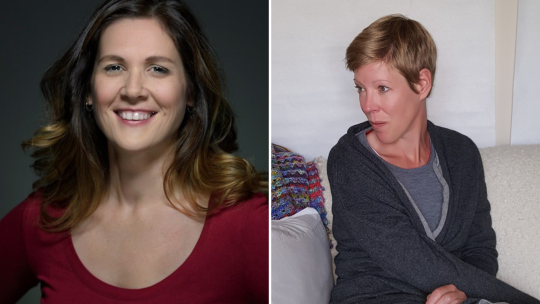
Artists Christine Lesiak and Kerri Strobl. Photos provided by the artists.
“Once upon a time, when we were not here, not like we are now
the stars planted seeds in our mouths
filled with words
becoming our story,
filled with songs
becoming our movements
they take us through this world,
we didn’t know this,
we had forgotten,
the mysterious workings of stars to do things this way.”
- Kerri Strobl
The second artist pair to take up residence at the Yorath House Artist Studio Placement are Kerri Strobl and Christine Lesiak. The Yorath House Artist Studio Placement pilot program began in 2020 as a partnership between the Edmonton Arts Council, the City of Edmonton, and the City Arts Centre, investing in artists working in a range of art forms and practices to foster experimentation and creative collaboration.
Kerri Strobl is an interdisciplinary artist who has worked across Canada, the U.S. and Europe with various types of folk. Her practice explores Land, Plant Medicine (European Tradition), Spirituality and Ancestry through installation, sculpture, performance, sewing, and video. Her work has been shown at several pop-up galleries, festivals and theatres. Kerri is a Bilingual Art Educator (French and English) at the Art Gallery of Alberta where she develops art projects and facilitates classes in person and online for children, youth and adults. She is studying to be an Art Therapist.
Christine Lesiak(christinelesiak.com) is an award-winning theatre-artist with a specialization in interactive comedy, performer-created work, empathy-based experience design, and site-specific performance. Through her company, Small Matters Productions (www.smallmatters.ca), Christine has been creating, performing, touring, and producing original theatre since 2007. She is passionate about experiences that invite the audience to engage directly with art. Her current areas of interest are performer-created interdisciplinary work that integrate fact-based science, environmental, and social justice topics into entertaining and engaging performance. She is excited to celebrate Edmonton’s natural areas and encourage Edmontonians to see the land in new ways, with a new understanding of its unique history.
According to the artists, they are looking forward for the opportunity to undertake a time of focused and intensive exploration to write and develop a live-performance work about memory, ancestry, and nature. The work will be centered around a collection of poetry and accordion melodies that Kerri wrote while living for three years in the forest and tending gardens. While in the studio at Yorath House, the artists will explore Kerri’s poems with the accordion, explore clay as a medium for ephemeral environmental sculpture, and develop the story line.
“Yorath House is the perfect place to inspire this work because of its cultivated outdoor space on the river valley. The land placement dovetails perfectly with our key themes of exploration: the cultivated versus the natural, the line between collective memory and personal ones and the spirit or language of land.
The ability to attend to this work at this time, in this place is a gift. We are living in challenging, divisive times that call for us to reach out to each other by sharing our gifts and experience. One of the hopes in doing this work is that it will create ripples of more sharing to help create bridges of understanding in how our personal histories and views influence how we live together.”

Writers from all over the world call Canada home, but once in Canada, they don’t always get the opportunity to become published writers—not if English is their second language.
One of those writers is Luciana Erregue-Sacchi, a Canadian-Argentinian editor, writer—and now publisher—who like many hyphenated Canadians, rarely saw or heard underrepresented ESL voices in Canada’s largely anglo-centric publishing industry. In 2020 she changed that, launching Laberinto Press—Western Canada’s first press to publish writers whose first language is not English, and world literature in translation. Its mandate? Produce literature by culturally diverse writers that do not pander to tokenism, but touch on the true diversity, multiplicity, and complexity of the human experience. As Errugue-Sacchi explains, that mandate extends to every detail of the press, including its name.
“Laberinto is the Spanish word for labyrinth, one of the main literary tropes of Argentinian writer Jorge Luis Borges, who writes about intersecting and diverging stories and lives in his short story “The Garden of Forking Paths.” As a child, I was also fascinated with the story of the Minotaur, and as a young immigrant, that idea of losing and finding yourself resonated with me,” says Erregue-Sacchi. “Laberinto Press is the synthesis of those converging and diverging stories we tell each other. It is a site of encounters and experiences.”
Thanks in part to a cultural diversity grant from the Edmonton Arts Council (EAC), Erregue-Sacchi was able to actualize her editorial mandate by publishing Beyond the Food Court: An Anthology of Literary Cuisines. As Erregue-Sacchi explains, discovering the EAC’s grant allowed her to do much more than publish her first book.
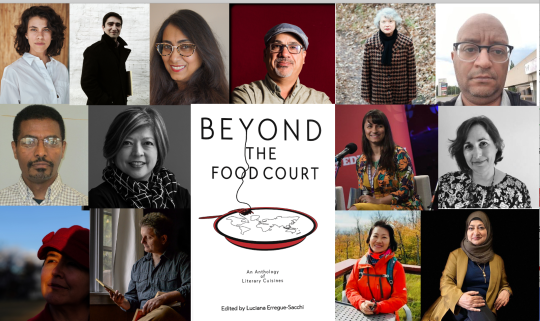
“It was a perfect convergence of what I wanted to create and the avenues to pursue that project,” says Erregue-Sacchi. “I came across the grant just browsing their website, and it has been a life-changing investment. I managed to create not just an anthology with 14 local authors, I got to hire local editors, designers, pay for the printing, the marketing materials, and get started with my press, which has already produced its second book. Most importantly, it gave me a huge sense of accomplishment and, probably, I am still unable to see the actual ramifications of this. That is to say, grants do a lot more than support a particular project—grants are a massive vote of confidence for artists, cultural workers, and the communities they represent and serve.”
Laberinto’s second publication, Beyond the Gallery, continues the anthology series, this time featuring a broad range of writings on visual culture by Spanish-speaking writers, artists, and cultural workers. Though Erregue-Sacchi happily admits that anthologies are one of her favourite genres, her decision to publish them as Laberinto’s first two books was as practical as it was personally gratifying.
“I really wanted to showcase as many of our writers as possible,” says Erregue-Sacchi. “I wanted people to focus on the deep value of diverse narratives and the power of brief stories to create conversation. In my case, I decided I wanted to tackle two senses: taste (Beyond the Food Court) and sight-non-sight (Beyond the Gallery), and showcase wildly different stories from writers who live here in Canada. I want to demystify difference by engaging with it.
Creating spaces that don’t yet exist is an all-too-common necessity for the BIPOC community, but if you’re lucky enough to chat with Erregue-Sacchi, you’ll discover that the deliberate joy in what she brings to publishing is as intentional as her editorial mandate. But as grateful as she is for the support she’s received, the realities of carving out a space for Laberinto Press in Canadian publishing has been exhausting to navigate.

“As much as I want to thank local festival organizers, independent bookstores, distributors, and granting bodies in the province who believe in diversifying the publishing industry, there is still lots to be done,” says Erregue-Sacchi, adding that “agencies like the Canadian Book Fund do not fund emerging BIPOC publishers like myself, instead prioritizing ‘diverse’ books by established presses who have earnings of above $50,000. Likewise, The Canada Council has funding schemes for publishers, but as Erregue-Sacchi points out, “it’s rarely for publishers at the earliest, shall we say, embryonic stages of their business life.”
The logistical gymnastics don’t end there. “Funding bodies mostly require that the applicants be non-profit organizations or loose groups of collaborators, rather than businesses that, ultimately, support BIPOC artists,” notes Erregue-Sacchi. “Sometimes other bodies request that a publisher fulfills a certain annual quota of titles produced or does not self-publish in order to fully join, when the reality is that self-publishing sometimes is the only option for new underrepresented authors. Other times, certain book awards make sales figures or marketing efforts a determinant factor in awarding prizes, a feat for presses like mine. It is quite the Twilight Zone from this perspective.”
Despite all the hurdles, Laberinto Press, Erregue-Sacchi, and the 22 hyphenated Canadian writers she’s published are slowly shifting the structures of Western narratives—starting right here in Edmonton. It’s a shift Erregue-Sacchi hopes will continue to help shape the answer to “What is Edmonton culture?”
“I hope Laberinto continues to show that difference is experiential, deeply personal, and has value beyond the stereotypical. I want us, as a community, to focus more on the diversity of lived experiences. Someone who writes about their homeland is still an Edmontonian, or an Albertan. It is a ‘very Edmonton’ thing to be a creator from somewhere else. I want Edmonton culture to be a breathing, living organism formed by ever-changing humans, institutions, and groups.”
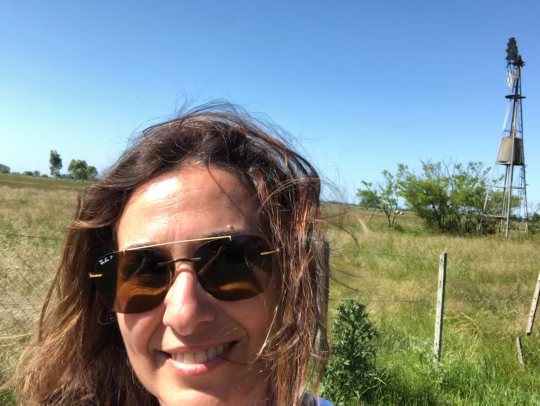
About Luciana Erregue-Sacchi
Luciana Erregue is an Argentinian-Canadian publisher, writer, and cultural worker. She is the founder of Laberinto Press, a Banff Centre Literary Arts Program alumni, and maintains her blog SpectatorCurator where she muses about art and life in AMISKWACIWÂSKAHIKAN (ᐊᒥᐢᑲᐧᒋᐋᐧᐢᑲᐦᐃᑲᐣ ).
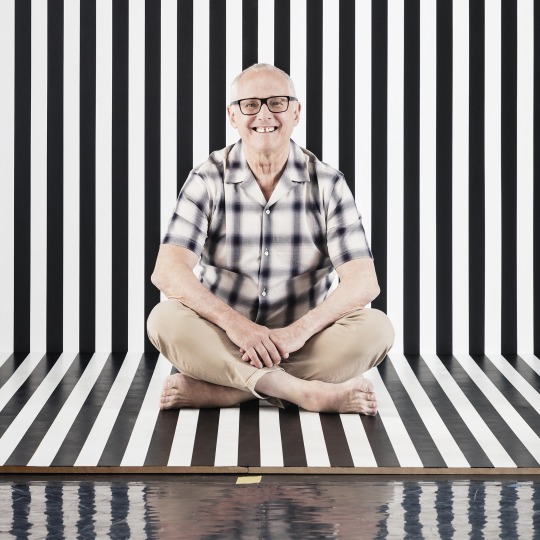
Photo credit: Daniel Wood
As we get older, our work often becomes more contemplative. That’s definitely the case for Brian Webb—and it’s exactly what he’s looking for. As an accomplished dancer, choreographer, and artistic director of the Brian Webb Dance Company, his artmaking has been both a journey of collaboration and a portrait of self. Today, that portrait reflects Webb’s commitment to the three practices that guide him: faith, dance, and martial arts. Amalgamating them is his new passion, as he asks the question, “Do I have the guts to be who I am today?” This week’s “I Am YEG Arts” story belongs to Brian Webb.
What keeps you choosing Edmonton as your place to live and work?
Edmonton is my home. Even though I danced in New York, which I loved doing and it really changed my life, I decided to come back to Canada, and Edmonton is where I ended up—particularly because I was offered a job at MacEwan. And that was very fortuitous because, right away, I started a dance company, and from the very beginning, it was a company in residence at MacEwan. Such an opportunity—and I tried to make the most of that.
Living in Edmonton has been great for me, and I am an Edmontonian through and through. I believe in this community and am thankful for the huge amount support I have received from the public sector and the private sector. For over 43 years I’ve had a community organization with my name on it—and how lucky for me—but I, of course, can’t do this by myself. This is a community organization, and that includes a huge number of hours of volunteerism.
When you were 17 and first starting out, what was it about the arts that made you feel it could be your community?
All through my childhood and youth, I studied piano and earned my Grade 10 Toronto Conservatory Piano. In doing so, I got an inkling I wanted to be in theatre, so I auditioned and got in to the drama program at the University of Alberta, which in those days was a most respected theatre program in Canada. There I took the first movement class, which was from a woman named Dorothy Harris. And I have to say that changed my life because I went, ‘Oh, this is me!” And from that moment, I’ve danced for the rest of my life. Now I’m 70 years old, and I’m still dancing.
As a choreographer, what narrative or inspiration do you find yourself returning to?
It’s always, ‘Who am I?’ I believe that all artmaking is a self-portrait. When you are creating art, I think you’re in a big dialogue with one’s self, with yourself, with myself… So I think that the topic I constantly return to is, ‘Who am I today?’
Tell us about the importance of mentorship in the dance community and how it has influenced your path.
We never do things alone. There are people who become important in one’s life, and I think it really has to do with what one learns from them. I was very fortunate when I started out to have some very good teachers, both in the drama department at the U of A and in the community. In particular, there were two women who hugely influenced me and my decision to go to New York, and those women were Jackie Ogg and Charlene Tarver. As a matter of fact, by the end of the first year of their dance company, which I was part of when I was 18/19 years old, I had choreographed my first dances—one of which was a full-length dance. I mean, who gives you that kind of opportunity? That is huge mentorship. As a teacher of dance, I think I learned to be a mentor for young artists, and I continue to mentor today. There are people across the country I’m in dialog with all the time about the creation of work. I think as one matures, it’s especially important to be open and generous with younger people—and peers.
How important has collaboration been throughout your career?
Along with mentorship, what’s important in artmaking is collaboration. When I did a Master of Fine Arts degree at California Institute of the Arts, which is still one of the great art schools of North America, I was introduced to feminist art theory, which basically says that we all have a story to tell, and each one of our stories is of equal value. And what that really then encourages is democracy. Well, that too can be applied to dance. And there’s one person who influenced me that way hugely, and that’s the visual artist Blair Brennan, with whom I collaborated nine times.
Blair and I defined collaboration as the democratic exchange of ideas to make something new. So, when you’re collaborating the first time, you learn who each other is and how you are going to communicate with this person. By the ninth time you’re collaborating, it’s hard to tell who is doing what because you’re doing everything together in a very democratic way. Blaire just had amazing influence on me that way, and it showed in our work. We performed those dances across Canada—and some of them in the US. He was just a major, major influence on me.
Tell us about a lesson you’ve had to learn more than once.
I think when you make a career of performing before people, it takes a lot of ego to do that. At the same time, I think I’ve learned to be humble in that process, and being humble was a big lesson for me. I think, too, that I’ve also learned to be who I am: very critical of myself and very ambitious—always working to make the best work I can. But as a friend of mine said to me the other day, “you are one of the most ambitious people I know, but you are not competitive.” And I’m not. I just do what I do.
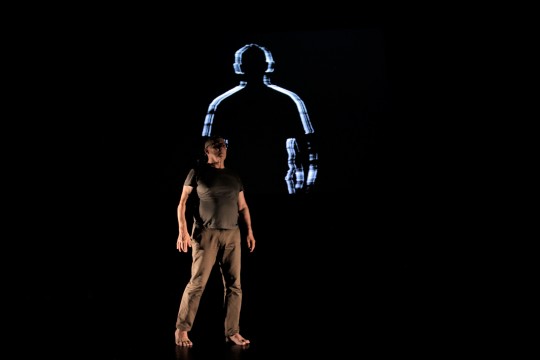
BWDC Production of “PLACE”. Photo credit: Bottom Line Productions.
What excites you most about the YEG arts scene right now?
I think it’s most important that we recognize diversity in our community, so I’m excited that I’m seeing artmaking from so many more points of view than I once did. I like that very much. Over the years, the BWDC has produced the premiere of all of Usha Gupta’s dances. It has taken time and commitment from both her and me to develop her place in the Edmonton and the Canadian dance community. And I have learned from her! Our relationship is most important to me. She’s a very important artist now in our setting, and I have loved that relationship a lot. As excited as I am about diversity, there’s a part of me that worries that sometimes there is more political correctness than there is honesty in our efforts to celebrate pluralism. That’s a big statement, but I do believe it’s the truth. I think that as a community we still have a huge amount of work to do. It’s not enough for us to say we believe in diversity—we need to truly invest and reinvest in it long-term to make meaningful change. Anything less than that does a disservice to the importance of diversity and—ultimately—to the art itself.
What are you currently working on/exploring?
I am working—and on a really big piece—and my collaborators are Brad Necyk and Gary James Joynes. Garry is an AV artist, and Brad is a virtual reality artist. So, as someone only interested in contemporaneity, and I think that’s been a constant in the BWD scene, I’m only interested in today. So what I’m working on is a big piece about time.
I think about time a lot, and what time means, and how time is almost impossible to define—and yet I’m very aware of my age and finite time. In other words, the one thing we all have in common is that for each of us, time ends, and then we have the inconceivability of eternity. And as a practicing Christian, that makes me consider a lot of things about time and take interest in what other people have written about it. For instance, Saint Augustine and his 11th Book of Confessions, which is a discussion of time. In it, he describes present time as a perception of time, past time as memory, and the future as expectation. Now those are very personal things because who can really define time? It’s a wild one. So that’s what I’m looking at in this piece. And I’m having so much fun doing it.
Who’s someone inspiring you right now?
One of the people I’m working with in my new piece is a fellow named Deepak Paramashivan. Deepak does an ancient form of carnatica chanting—and—he’s currently at the U of A working on his third PhD. How can that person not be inspiring! Deepak also loves that old rock band, The Doors, which I also love. So one day we entertained people in India by singing Doors songs. In other words, we can talk and we can play. He’s just a very giving person.
What makes you hopeful these days?
Certainly my faith makes me hopeful. Hope is part of faith. But when I am working with artists like Brad and Gerry and see how they are really using technology and are super interested in it, that makes me hopeful too. I don’t know how people can call themselves a contemporary artist without some sort of interaction with technology, because technology is defining our world. And if we can make art in some sort of interaction with it, we can create some kind of positivity. But if we are only interested in technology for the web… well, that’s sad because it’s not creative.
In an interview a few years back, while reflecting on your dance career, you commented that “you have to dance who you are today.” Who are you today, and what is your dance?
I’m an artist. But I’ll tell you a little story. There was a period of time when I came back from California through to the beginning of the 90s that I described myself as a queer artist. Eventually, I realized I had put myself in a box, and I just couldn’t do that work anymore, artistically, politically, etc. It is then that I became an artist who is queer. There is quite a big difference between being a queer artist and an artist that is queer. So that’s kind of the intro to the answer, “who am I?” There is no question that my faith is determining very thoroughly who I am today, and that I’m interested in other contemporary artists who are very involved in a dialog with their faith. I mean, I ain’t unique. There are many people that way!
But on a secular side, dancing who I am today as a 70-year-old person is humbling, it’s hard work, it’s fun, and it opens me to communication with people in a different way. And I like that. I think back to how I was when I was a young dancer and how interested I was in my presence in a physical way, and in my “beauty” as a dancing human being. Now if I were interested in that today, it’d be pretty pathetic! So I’m interested in how I can dance—really dance—who I am.
Want more YEG Arts Stories? We’ll be sharing them here all year and on social media using the hashtag #IamYegArts. Follow along! Click here to learn more about Brian Webb and the Brian Webb Dance Company.
About Brian Webb
Brian Webb has developed a national reputation as a contemporary dancer, choreographer, and artistic leader. He has brought an international array of contemporary dance companies to Edmonton through the BWDC, which he founded 34 years ago, and his collaborations with Edmonton artists have toured across Canada and in the United States, including New York and Los Angeles.
Among many other honours, Brian won Edmonton’s prestigious Artistic Lifetime Achievement Award in 2012 and has received the Queen’s Golden and Diamond Jubilee Medal for his volunteer work in the community.
Words by Adriana A. Davies, February 2022
Artworks by Marlena Wyman February 2022
Artists-in-Residence at Yorath House
(Photographs as credited)
It is time to write the final blog post, No. 8, which focuses on family. It’s hard to believe that our two-month residency is up. It’s been an amazing experience and has resulted in a surge of creativity for Marlena and myself.

Yorath House ca 1980s. Yorath family collection.
Yorath House was a family home for 43 years and was a passive observer of all the joys, hopes and sufferings of the people who lived there. To understand this, I’ve done a lot of research on key family members. This started with revisiting the work on Christopher James Yorath, Dennis’ father that I did for his entry in the Dictionary of Canadian Biography, which I began in 2013. The family entrusted me with biographical accounts, correspondence, a memoir, newspaper clippings, speeches and other materials about C. J. but also touching on other family members.
Among these treasures was a small watercolour sketch of Yorath House done by a member of the team at Rule Wynn and Rule. Little did I know at the time that my attention would be focused on the house and that I would be a “resident” there for two months in 2022 (at least during the day). It seemed natural for me, therefore, to spend part of the residency focusing on the Yorath-Wilkin families and their experiences. This spun off naturally from one of the goals of our residency, which was to examine the relationship between space and place, and also time and the river.
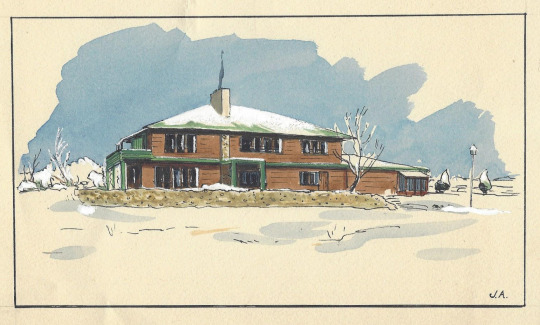
Architectural drawing of Yorath House by Rule, Wynn & Rule, 1949. Yorath family collection
In this respect, the experiences of the families are both unique and universal. Historic structures are not just about the design and building materials but rather about these and also the occupants who lived or worked there. The range of human experience, I believe, somehow leaves a residue in the walls and natural landscapes. I know that this is a fanciful and, to some, an absurd notion but, humour me, visual artists and writers get to play with this kind of stuff! I think that I can be both rational and fanciful as I move between non-fiction and creative non-fiction. I propose to tell some family stories in both prose and poetry, and show that human beings turn space into place.
The Yoraths: Father and Son
C. J. (Christopher James) and D. K. (Dennis Kestell) Yorath, father and son, were skilled businessmen and “community builders.” They were part of the industrialization and urbanization of the City of Edmonton and Province of Alberta in the twentieth century. C. J. was born in 1870 in Cardiff, Wales, the son of William Yorath and Sarah Hopkins. In 1904, he married Emily Kestell.i The couple had two sons, Dennis and Eric, and a daughter, Joyce. From 1895 to 1898, he studied civil engineering at Cardiff College (later part of the University of Wales). When he completed his studies, he obtained work with the City of Cardiff and learned a great deal on the job about issues such as drainage, street-railway electrification, road and bridge building, and artificial gas delivery. In 1909, he moved to London and did some lecturing at the Westminster Technical Institute and, more significantly, worked for the firm of Sir Alexander Richardson Binnie on a massive drainage project in the city. At that time, many ambitious young men looked to the colonies to further their careers. In 1912, he became aware of a major urban planning project: Canberra had been designated the capital of Australia. He submitted an application to develop the master plan; he was unsuccessful and then turned his eyes to Canada.

C. J. Yorath, Who’s Who in Canada, volume 16, 1922, page 748.
In 1913, C. J. submitted an application to an international competition to become city commissioner and treasurer for the City of Saskatoon and won. He may have learned of the competition from his brother Arthur, who had homesteaded near Oyen, a town in east-central Alberta, near the Saskatchewan border and north of Medicine Hat beginning in 1911.i C. J. was charged with preventing the City from declaring bankruptcy – the state of many Canadian municipalities at that time as a result of the worldwide recession and a dramatic fall in the value of land and property, and huge decline in the property tax base. On April 23, Yorath sailed from Southampton, England, on theOlympic (a sister ship of the Titanic) with wife, Emily, and their two sons Dennis and Eric. They arrived in New York on the 30th and reached Saskatoon early the following month.
C. J. brought not only engineering and project management expertise to his job but also a vision about the proper layout and development of urban areas. In a 1913 article that he wrote for Western Municipal News, he approvingly quotes Aristotle’s definition of a city as a “place where men live a common life for a noble end”; stresses that municipalities should be purposefully planned; and laments that too often “cities have grown up in a haphazard manner, and many a beautiful spot turned into an ugly accumulation of bricks and mortar.” Emphasizing natural beauty and artistic symmetry, Yorath allied himself with the Garden City movement, describing the ideal municipality as “beautiful, well planted and finely laid out, known and characterized by the charm and amenities which it can offer to those who seek a residence or dwelling removed from the turmoil, stress and discomforts of a manufacturing district.” He not only got the City out of debt, he also left them with a “Preliminary plan of greater Saskatoon,” which made tangible his vision of a city with plentiful green space and, among other innovations, a ring road around its outskirts. While it was shelved for lack of funding, as was the case in many municipalities across the country at the time, it was a legacy.
In 1921, he accepted a higher-paying job in Edmonton and, on March 23, the Edmonton Journal, welcomed him to the city and noted, “There are no airs of the autocrat or supposed superman about him.” He had a very large mandate: he was commissioner of public works and utilities and joint commissioner of finance, in effect, Edmonton’s city commissioner. C. J. found that the municipal debt was higher than that of most western cities and, during his three years in Edmonton, succeeded in putting the city in a stronger financial position. While more than a third of Edmonton’s debt was tied to its waterworks, electrical powerhouse, street railway, and telephone system, under his tenure all of these services were financially self-sufficient and provided additional tax revenue. Newspaper articles reveal that he was a popular speaker and visited other municipalities; a favourite topic was “public ownership vs. private control.” He was a strong believer in the latter.
Edmonton City Council minutes during C. J.’s term frequently deal with discussions about the provision of gas to residential and business customers. In 1909, Eugene Coste, who worked for the Geological Survey of Canada, made a major gas discovery in the Bow Island area near Calgary. He established Canadian Western Natural Gas in 1911 and built a pipeline to Calgary. In 1924, C. J. joined the company and, in 1925, became President and managing director of Canadian Western Natural Gas, Light, Heat and Power Company, which supplied not only Calgary and Lethbridge but also towns in between.i By 1927, Northwestern Utilities and Canadian Western had become subsidiaries of the International Utilities Corporation, an American holding company, and by 1930, Yorath was president and managing director of several other Canadian subsidiaries.
In June of that year, he arranged the sale of all these firms to the Dominion Gas and Electric Company, an American subsidiary. After this massive deal (the Calgary Albertan estimated its value at $30 million or $505,056,287 Cdn today) was completed, C. J. remained in charge. He was at the peak of his career when he died as a result of a heart condition on April 2, 1932. Family members believe that it was the stress of his work that precipitated his health issues. His obituary in theAlbertan encompassed nearly an entire page and outlined his business successes, as well as his community service, noting: “But the heavy burden of business cares did not curtail Mr. Yorath’s interest in sport and community life. He was a prominent member of the Kiwanis Club and a keen golfer, having been a member of Calgary Golf and Country Club for many years.” He was also a member of the Masonic Order, as were most members of the British establishment, and was interested “in conservation of the gas supply.” The article notes: “He had just returned from Edmonton, where discussions regarding conservation measures took place, when he was stricken with the illness which proved fatal.”i The work that he set in motion would result in the establishment of the Petroleum and Natural Gas Conservation Board in 1938 (later the Alberta Energy Conservation Board).
C. J. was part of Calgary’s business elite and the family’s home at 1213 Prospect Avenue in the Mount Royal district was an enormous brick and wood Craftsman-style home with some Tudor elements built in 1912. The district was initially nicknamed “American Hill” because of the number of wealthy Americans who lived there (this was pegged at about one-third). Some were initially drawn by the ranching opportunities and others by the coming in of the Turner Valley oil field in 1914. The formal photograph of the house in the bottom lower right corner shows the gas fittings in the home to demonstrate the importance of the fuel in a modern residence. The house was similar to the one built by Eugene Coste for his own residence, in 1913, which had 28 rooms and was located at 2208 Amherst Street in Mount Royal. As the district name suggests, the subdivision was built on an escarpment that provided expansive views of the new city. Like Old Glenora in Edmonton, there was a covenant that directed that only homes of a certain (high) value be built there. C. J.’s granddaughters remember the extensive grounds that surrounded it including gardens and flowerbeds and also allowed horses to be kept on the property.
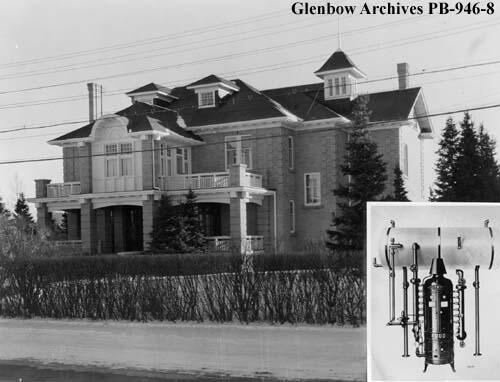
C. J. Yorath residence, Calgary, Alberta, ca. 1930. C.J. was President and Managing Director of the Calgary Gas Company. A sketch of the plumbing and heating system appears in the lower right-hand corner. Photographer: W. J. Oliver. Glenbow Archives, Libraries and Cultural Resources Digital Collections, University of Calgary, PB-946-8.
Dennis Kestell Yorath was born in London, England in 1905 and was educated in London, Saskatoon and perhaps Edmonton. His father’s wealth allowed him, as a young man, to enjoy the benefits of being part of Calgary’s elite and he learned to fly a plane and play polo. A number of young Canadian men had learned to fly during the First World War, among them Calgary’s Captain Fred McCall and Edmonton’s Wilfrid “Wop” May. They were pioneers who helped to set up flying clubs in their communities. Dennis knew both of them and was a charter member of the Calgary Flying Club, which was established in 1927, and obtained a pilot’s license in 1929.i He was also an expert horseman and played polo; in fact, according to his daughters, he played in a game with the Prince of Wales, Edward VIII, when he visited Calgary in the 1920s. According to newspaper accounts, he played for the Calgary Blues Polo Team among whose members was J. B. Cross. His father, A. E. Cross, was a rancher and co-founder of the Calgary Stampede, the Calgary Brewing and Malting Company, and Calgary Petroleum Products (1912). J. B. and Dennis would follow in their father’s footsteps. The pages of the family’s photo albums include pictures demonstrating these pursuits.
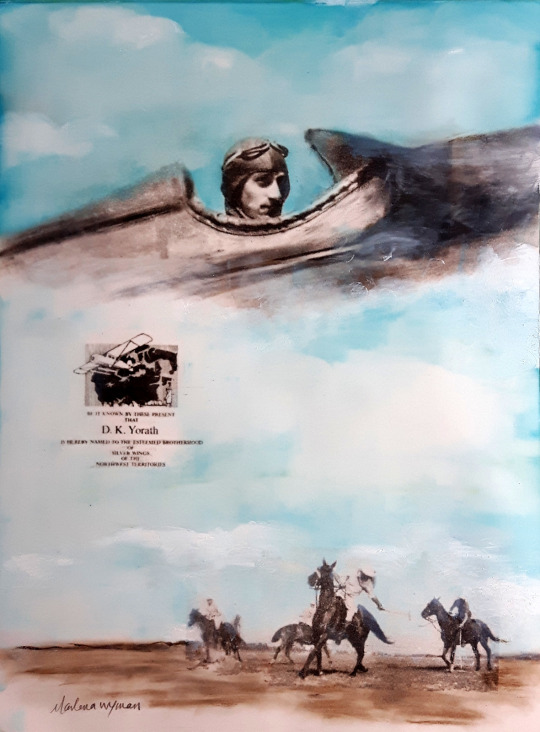
Dennis Yorath painting by Marlena Wyman – image transfer and oil stick on Mylar. (Photos from Yorath family collection ca 1930).
With respect to his career, Dennis started work with the Imperial Bank of Canada in Edmonton where he worked for two years and, then, following his Father to Calgary began work, at the age of 19, for Northwestern Utilities and, in 1925, for Canadian Western Natural Gas. His father’s early death at the age of 52 catapulted him into a leadership position in the companies. In 1933, he married Bette Wilkin, whose father, among his various real estate and insurance interests, was also a co-founder and shareholder of the North West Brewing Company. According to family history, the Wilkin and Yorath families knew each other when C. J. and wife Emily lived in Edmonton, and that Dennis dated Bette’s older sister Jean until she found the man she was to marry. Dennis then turned his attention to Bette. After their society wedding, the couple went on an extended honeymoon to China and Japan, and brought back some lovely antiques including a Chinese chest, Japanese screen and brass inlaid tray table and two stools. They moved into a cottage on the grounds of C. J.’s home in Mount Royal. In 1940, Dennis left his jobs to serve his country becoming director of pilot training for southern Alberta, based at the No. 5 Elementary Flight Training School near Lethbridge as part of the British Commonwealth Air Training Plan.i In 1941, the School relocated to High River. Bette and their two daughters, Gillian (born 1936) and Jocelyn (born 1938) remained in Calgary. Just as his father’s career had been impacted by an oil and gas boom, so would Dennis’ career. The coming in of the Leduc and Redwater fields, in 1947 and 1948, triggered massive development, and prosperity for not only Edmonton but also the entire Province of Alberta. In 1949, Dennis was transferred to Edmonton to become general manager of Northwestern Utilities and, in 1956, became president of both Northwestern and Canadian Western Natural Gas. He served as chair of both from 1962 to 1969. From 1957 to 1973, he served as Director of the International Utilities Corporation and, from 1973 to 1981, as vice chair of International Utilities Corporation. On March 2, 1971, the New York Times noted: “TORONTO, March 1 (Canadian Press) – The International Utilities Corporation reported yesterday that its 1970 net income rose to $33,475,000 [worth $242, 562, 610 Cdn in 2022], or $2.42 a share, from $33,070,000, or $2.61 a share, a year ago. The Toronto-based conglomerate, which has administrative offices in Philadelphia, reports its financial results in United States currency.”i
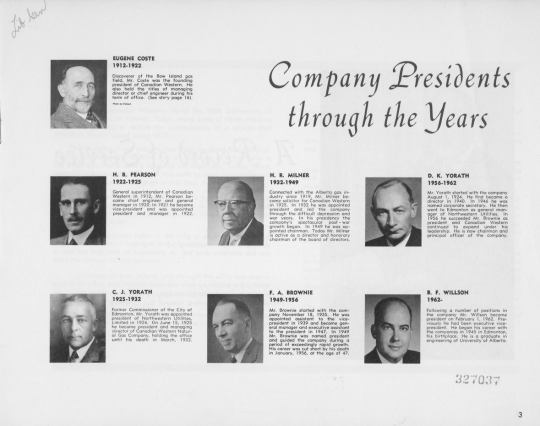
Dennis Yorath headed the Canadian Western Natural Gas Company when it celebrated its fiftieth anniversary. A commemorative book titled Half a Century of Service: 1912 – 1962: Canadian Western Natural Gas Company included photos of its presidents on page 3.
On their move to Edmonton, Dennis and Bette chose to build a “signature” house in the Modern Style designed by Rule Wynn and Rule, just as his parents had chosen a Craftsman-Style House in Calgary. Dennis died on May 8, 1981 as a result of early onset Alzheimers’ Disease. In 1985, Bette had her nephew, architect Richard Wilkin, design and see to the renovations required to create a rental suite on the second-storey of her home to avoid living alone. In 1992, the city bought the 11-acre Yorath property for $900,000 to consolidate public ownership of river frontage in Buena Vista Park. The fieldstone memorial at the river’s edge of the property commemorates not only Dennis and Bette but also her parents, William and Hilda Wilkin, who had given them the land.
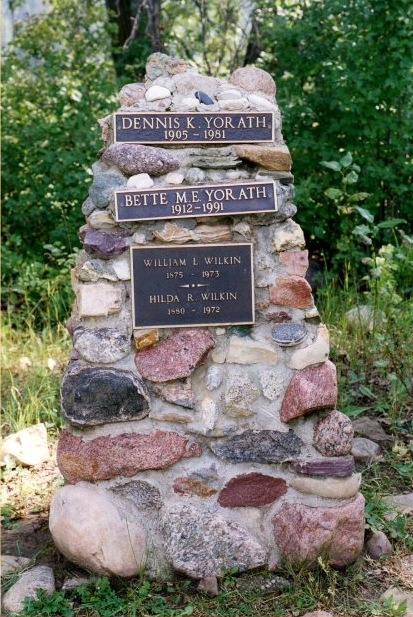
Wilkin-Yorath family cairn on the grounds of Yorath House. Yorath family collection.
During his lifetime, Dennis received many honours and was an active volunteer in both professional associations and community organizations. For his war-time service, he was awarded an Order of the British Empire by the British government in 1946. From 1947 to 1949, he served as the president of the Royal Canadian Flying Clubs Association, and, in 1949, was awarded the McKee Trans-Canada Trophy for his contributions to aviation. From 1947 to 1955, he was Director of the Canadian Gas Association (CGA) and served as Vice President in 1951, and, President, in 1953. From 1955 to 1957, he was a director of the American Gas Association. In 1951, he received a life membership in the Edmonton Flying Club and, in 1973, was inducted into the Alberta Aviation Hall of Fame. In 1955, he was president of the Edmonton Chamber of Commerce and, in 1962, headed the United Community Fund of Greater Edmonton. From 1966 to 1972, he served on the Board of Governors of the University of Alberta and was involved with the Friends of the University of Alberta Botanical Gardens; the University awarded him an Honorary Doctor of Laws Degree in 1974. Dennis was active with the Canadian Council of Christians and Jews, the Community Chest Air Cadet League of Canada, Boy Scouts Association and the Salvation Army. He was a supporter of the Edmonton Klondike Days Association and, in 1966, as part of the Sourdough Raft Race, six boats raced from the dock below Yorath House down the North Saskatchewan River. He was a member of the Committee that helped to decide on the design of the Canadian flag. He died on May 8, 1981 in Edmonton.
Mothers and Daughters
The women of the Wilkin and Yorath families lived in a time when they were defined by what their husbands did, and were expected to be excellent wives, mothers and hostesses. This was certainly true for Hilda Wilkin, Emily Yorath and Bette Yorath. Their husbands worked hard and the families were part of the upper middle class elite of people of Eastern-Canadian, British or American origin who dominated the development of Edmonton and other communities not only in Alberta but also the rest of Canada. Their doings can be found in the pages of the Edmonton Bulletin, Edmonton Journal,Calgary AlbertanandCalgary Herald. Their attendance at events at the Legislature, church fetes and meetings of the Imperial Order Daughters of the Empire, St. John’s Ambulance and other patriotic societies always referenced them as “Mrs.” or “Miss.” Their first names were rarely mentioned, if at all. They are invisible except in the many pictures in family albums.
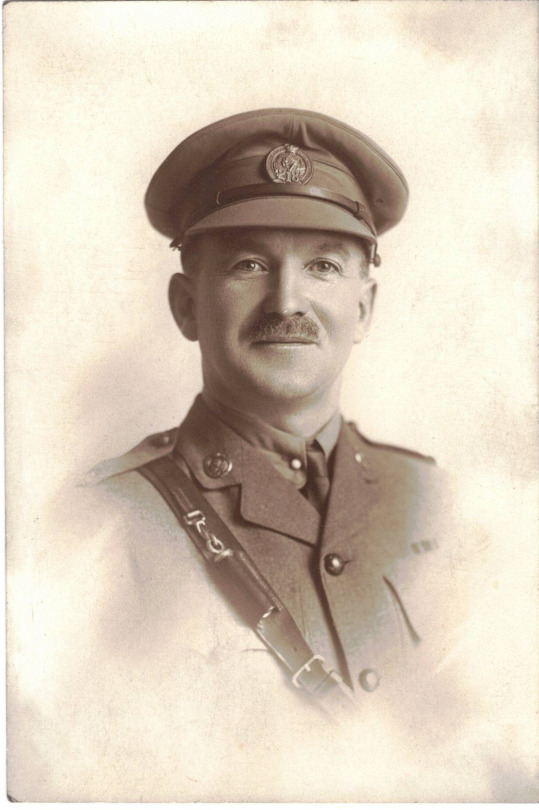
William Lewis Wilkin in military uniform, 218th Battalion, Canadian Expeditionary Force, ca. 1916. Photo courtesy of Richard Wilkin.
William Lewis Wilkin arrived in Edmonton in 1892 on an adventure and began to make good working at retail, real estate and insurance brokerage. He returned to England in 1904 to marry a childhood friend, Hilda Richardson Carter, and brought her back to the relative wilds of Fort Saskatchewan where he operated a store and served on the town council. Their first child, a son, also called William, was born in 1905, and their fortune improved with the increase in numbers of their family. As property ventures began to dominate William’s business life, he and Hilda decided to move to Edmonton from Fort Saskatchewan. They auctioned their furniture so that they could have a fresh start and also went to England for a holiday with children Bill and Jean. This was not a “steerage voyage” and he writes in his memoir: “The trip over was as far as I remember very nice but not startling. On the boat Bill & Jean (about 4 & 2) shared our nice fairly large cabin at night & had meals & play room in the nursery which was well equipped with everything including a competent nurse.”
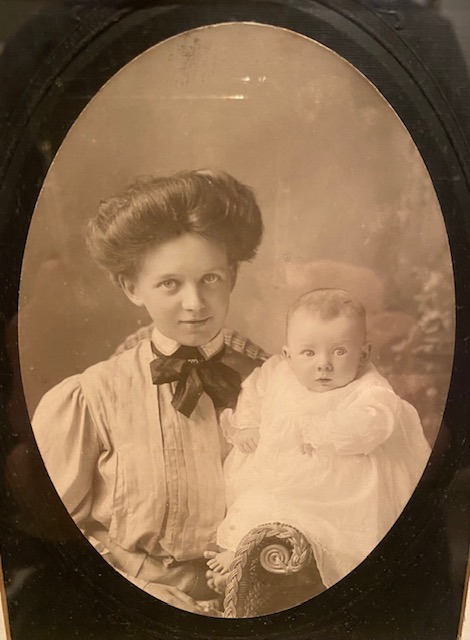
Hilda Wilkin (née Richardson Carter) and son W. V. (Bill). Yorath family collection.
Their Edmonton home was located on the corner of 123 Street and 103 Avenue and was a three-storey Craftsman-style home with a wrap-around porch. It was across the street from Robertson Presbyterian Church (Robertson-Wesley United Church today), which was built in 1913, and kitty-corner from the Buena Vista Apartments. Children Margaret Elizabeth (Bette) (born 1912), Robert (born 1914) and Richard (born 1919) completed the family. Their comfortable family home was known for excellent hospitality and, according to grandson, Richard Wilkin, almost every evening his grandparents were “at home” for visits from family and friends. This continued in their new home at Connaught Drive in Old Glenora, which was built around 1945. Both Hilda and William lived to the age of 97 and welcomed grandchildren into their home and even hosted sleep-overs. Their homes were tastefully decorated with English antiques and they adhered to the formalities and civilities of British life with teas and formal Sunday dinners.

Emily “Marnie” Yorath (née Kestell) pictured in formal dress for a wedding or other society event. Yorath family collection.
Emily Kestell Yorath was the perfect hostess for her husband, a leader of the business community, and presided at events in Calgary at their Mount Royal home. The Yorath children – Dennis, Eric and Joyce – all married well and had children. The Yorath children called their grandmother “Marnie.” There was always something to do both inside and outside the grand home. There were extensive gardens as well as games such as tennis and lawn bowling as well as horseback riding. The Yorath children and their spouses took part in not only family events but also other more official entertainments. After her husband’s death, Emily remained in Calgary where her daughter Joyce Yorath Williams and son Eric resided. Eric was vice president of Carlile and McCarthy Ltd., a firm of stockbrokers. Emily died in 1958.
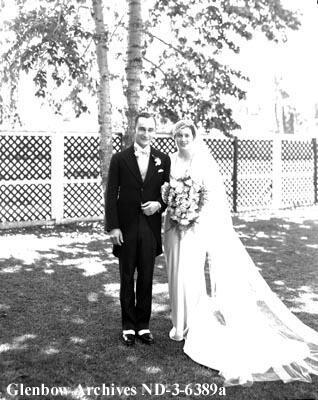
Dennis and Bette Yorath wedding photo taken in the garden of the Wilkin home in Edmonton in 1933. Photographer: McDermid Studio. Glenbow Archives, Libraries and Cultural Resources Digital Collections, University of Calgary, ND-3-6389a.
It could be said that Bette Wilkin “married up” but she was undaunted when she moved with Dennis to a modest home, referred to as a “cottage” on the grounds of the Mount Royal property. She had attended a private girl’s school in Vancouver for a time, according to her daughters, and was a superb equestrienne. The wedding photo of her in her parents’ garden in Edmonton shows a beautiful, self-assured and serene young woman. She was prepared to be the perfect wife, mother and hostess. Since Dennis’ father was dead, the oldest son and wife became the principal supports for his widow; and, since Dennis was in the same business, he continued his high-level social interactions with civic and provincial leaders, as well as the business community. Bette tended extensive gardens and bred peonies, rode daily and also raced thoroughbreds in “Powder Puff” Derbies in Calgary.
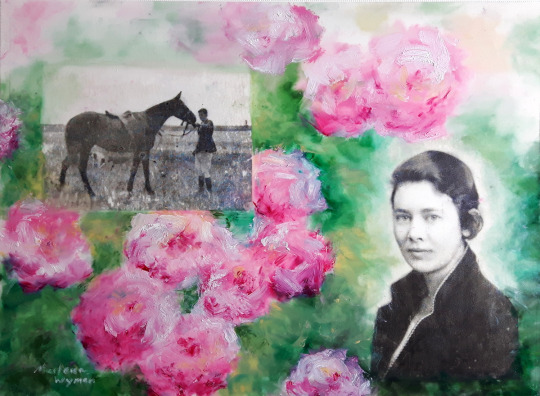
Bette Yorath (née Wilkin) painting by Marlena Wyman – image transfer and oil stick on Mylar. (Photos from Yorath family collection ca 1930).
Bette supported Dennis in all of his activities including the war-time work with the British Commonwealth Air Training Plan. She and her young daughters visited him in Lethbridge and High River where he was based. According to daughters, Gillian Brubaker (née Yorath) and Elizabeth Yorath-Welsh, the couple responded to the call from the Canadian government to help refugees and also befriended some Japanese Canadians interned and re-located to the sugar beet farming areas around Taber and Brooks. The move to Edmonton in 1949 was difficult but Bette took it in stride and with Dennis planned their new home working with architects Rule Wynn and Rule. The joy of the new home was extinguished when daughter Jocelyn died of leukemia in 1950. Sorrow was followed by joy with the birth of Elizabeth Jane. Life in Yorath House was a continuous round of socializing both with family and friends, and business associates and community leaders.
Bette’s taste was evident in the home’s furnishing which were a blend of antiques and contemporary furniture animated by purchases made on their honeymoon trip to China and Japan as well as other international travels. These included an inlaid brass tray coffee table and matching stools, a Chinese chest and Japanese screen. Bette also collected Japanese prints. The symptoms of early Alzheimer’s disease ended Dennis’ career but Bette supported him to the end. Four years’ after his death, she decided that she did not want to live alone and commissioned her nephew, architect Richard Wilkin, to design a self-contained suite to be created on the second-storey of her home. She died in 1991, the year before the City purchased her home.
Family Voices
In my work in community and social history, I’ve found that oral histories and correspondence, memoirs and other documents are an invaluable tool. The first-hand account is both exciting and revealing, and makes history come alive. Besides archival and other primary sources, I had the pleasure of talking with Yorath daughters Gillian and Elizabeth and nephew Richard Wilkin. I will let them speak in their own voices whether through transcripts of interviews or reminiscences.
Interview with Gillian Yorath Brubaker
Adriana A. Davies and Marlena Wyman
Zoom Conversation, Sunday, 3 pm Edmonton time and 1 pm Alaska time, January 30, 2022
After my parents’ marriage in Edmonton in 1933, they settled in Calgary where he worked. The family home, a “cottage” on the grounds of my grandparents’ large house, was situated near the Sarcee Reserve [Mount Royal] in Calgary. My father was an excellent rider from an early age and played polo including with Prince Edward on his visits to Calgary. One of his polo ponies, Cheetah, was brought up to Edmonton when the house in Buena Vista was built in 1949, in addition to our mother’s horse, Lady Patricia. We had more horses and donkeys in Calgary, but not all were moved up to Edmonton. Both my parents excelled at riding and my mother as a young woman had ridden as a jockey in “Powder Puff” derbies in Calgary and won! She had attended a private school in Vancouver for two years when in her teens. It was Crofton House School.i We rode almost daily and my sister Jocelyn was an excellent rider.
I believe that the Calgary cottage was built around 1920 and my parents bought it and moved in after their honeymoon in China and Japan. My grandparents lived in the “Big House” next door. My grandfather died in 1932 and my father followed in his footsteps working in the gas business in Calgary and later Edmonton (International Utilities).
My father was a skilled aviator who learned to fly in his early twenties. He would fly a Tiger Moth aircraft to our home in Calgary. He was a friend of First World War flying ace Wilfrid “Wop” May. From 1939 to 1945, my father lived in Lethbridge as head of the British Commonwealth Air Training Plan. He was very concerned about the air crews that he helped train and grieved at the loss of lives. He was away from the family and this was hard for me, my mother and Jocelyn, who was 14-months younger than me.
The nearby community of Taber was a centre of the sugar beet industry and was chosen as a location to intern Japanese from British Columbia, who were designated enemy aliens in the Second World War.i Our parents befriended two Japanese young women, Tammy and Ruby, from the internment camp. My parents also signed on to sponsor displaced persons: the Government of Canada was advertising for host families. They arranged for Eine Kranz from Riga, Latvia to come to Canada and my father located her fiancé Henry in a European internment camp and arranged for their wedding when they arrived. In Calgary, we had a huge garden and the Kranzs worked for us.
In Calgary, I attended St. Hilda’s School, which was a boarding school, and had to wear a uniform.i In 1949, when Father became the head of Northwestern Utilities, we moved to Edmonton and lived with my grandparents until our house was built. We moved in in the fall of 1949. Leaving Calgary was hard – I felt that I was losing all of my friends. I went to Glenora School in Edmonton at 135th Street and 102 Avenue (Stony Plain Road).i Jocelyn and I wore uniforms on the first day of school and we stuck out like sore thumbs. Jocelyn held my hand tightly and shivered. In the 1944 photograph of myself and Jocelyn with our cousin Rick Wilkin, we are wearing our school uniforms and Rick was wearing a robe. The photo was taken at the Wilkin summer place at Kapasiwin Beach on Lake Wabamun.
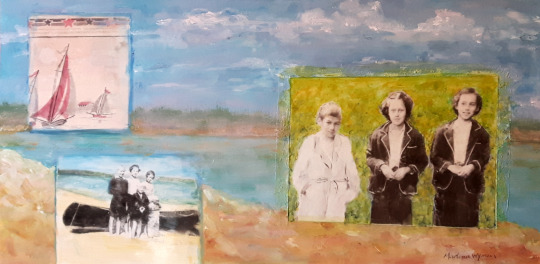
Wilkin and Yorath Cousins painting by Marlena Wyman – image transfer and acrylic paints on Mylar. (Photos from Yorath family collection ca 1944).
My mother loved the move to Edmonton since she was born and raised there and had family and friends there. It was a “huge move” with not only furniture but also horses and a pony being transported up. The current Yorath House parking lot was a pasture at the time and the Yorath horses as well as some belonging to our neighbours grazed there. There was a shed for the horses. Near the house was also a gravel pit and the Legroulx family lived nearby. There were three or four houses at the top of the hill. The Tellingtons also lived nearby, along the river.
Our house was built on about 14 acres of land and there was a mink farm owned by Esther Fisk nearby. It was 14 miles away from the City and located in wilderness. The house had many flower beds and also fruit trees around it. In Calgary, we also had large gardens including one devoted to peonies, which my mother bred and entered in competitions, some of which she won. She transplanted some of the peonies from Calgary into the Yorath House flower beds. The lawn and gardens sloped down on the land behind the house toward the river, and a large vegetable garden was planted on the side of the house where the garage is.
My parents had lots and lots of parties. Many had lost loved ones in the Second World War and just wanted to enjoy themselves. Cocktail parties took place all the time not only in our own house but also the Bill Wilkin residence [Richard’s family] at 16 St. George’s Crescent.
I remember breaking down when my sister Jocelyn died in 1950 and the first five years in the house I was in a daze. I remember that my parents were away and Jocelyn and I were staying with our Wilkin grandparents and sleeping in the same bed when Jocelyn woke me up and told me that she was not feeling well. I turned the light on and found the bed sheets covered in blood. Jocelyn had had a massive nose bleed. I called our grandparents and they took Jocelyn to hospital where she was diagnosed with leukemia. This was in September and she died in October [Provincial Archives death records show date as Oct 21, 1950]. I made a vow at that time to study radiology and go into nursing.
I attended Westglen High School [now an elementary school] at 10950 – 127 Street as did my cousin Richard Wilkin.i Initially I biked to school but eventually my parents bought me a blue Renault car, which I drove to the edge of the City, and parked on Stony Plain Road and 136 Street and walked the rest of the way. I remember that once while driving through the gravel pit near our house in my Renault, I nearly tipped it over. Baby Elizabeth was inside. We had a maid called Ilse who helped look after Elizabeth.
When I finished High School in 1954, I attended the University of Alberta and as a student worked for Dr. Bill Armstrong, who was a friend of the family. His specialty was ear, nose and throat. Around 1957, when I finished university, I went for a year of travel and work in Europe. I lived in London, England, and Linz, Austria. I remember climbing the Matterhorn and meeting my future husband John Brubaker on the climb. I climbed the West Ridge and he and a friend climbed the East Ridge. We then met in a bar. John was at Yale as an undergrad and attended law school in Charlottesville, Virginia.
In Linz, I worked in a Lutheran Church refugee camp that helped refugee boys who had been active in the Hungarian Revolution in 1956. They were kicked out of Hungary or maybe just left. I worked as a general “dog’s body” in the camp and was similar in age to the boys. Some of the boys went to Canada and established themselves. I returned to Canada but no-one seemed to be interested in my experiences other than mother and father.
John and I got married on December 28, 1959. The day was beautiful but cold and the well froze which meant that the inside toilets could not be flushed. Portable toilets were set up on the grounds. John and I flew to Calgary that night and then on to Washington, DC. There was a storm the next day and I heard that some of the guests from away stayed for three or four days adding to my parents’ worries.
John and I moved to Virginia and, then, in 1962, to Juneau, Alaska, and lived there until 1964 when we moved to Anchorage and we’ve been there ever since. I never went back to medicine and worked in a number of fields. John and I had two children, Heather and Michael.
I remember coming back to Edmonton for a visit in 1978 for the party that my parents hosted for Prince Philip. My son Michael was set to open the car door when the Prince arrived but the Prince opened it himself and said, “Beat you.” My parents knew a number of Royals.
With respect to the sale of our house, I remember that the City had “right of refusal.” I was shocked to see that the renovated house was so open and white on the ground floor. The downstairs was more closed in with “swing doors” into the dining room. There was also a door into the kitchen opposite the freezers on the wall. The dining room walls were pale blue and the floors throughout were teak.
Elizabeth Yorath-Welsh Reminiscences:
Part 1: Life at Yorath House
My parents moved up to Edmonton after World War 2 so my father could head up Northwestern Utilities. They built this house in 1949. The land was purchased from a farmer named Stephenson. The architects were Rule, Wynn and Rule.
I was born in 1951. My very early childhood of course is vague, but we did have maids until I was 2. Then there was a lady named Mrs. Bowman who looked after me when Mum & Dad would go away.
As a child I have very fond memories of growing up in the River Valley area now known as Buena Vista. There were quite a number of people living in that area along the river or overlooking the valley. Buena Vista road didn’t exist back then, so we used 81st Ave down the hill to 131st St. to get to our house, and it was all dirt/gravel road – awful after a heavy rain!
I remember Old Tom & his horse drawn wagon would come and cut the fields for the hay. He lived up above the zoo before it was built. Also, the milk was delivered by a horse wagon!
By age 2 I was getting to know how to get around rather quickly. Having the “run” of the river valley was not a bad life! There were other farms & small homes throughout the Valley, & the people were all wonderful. There was a chicken & turkey farm right across our field to the north owned by the Bates family. Both Sue & John Bates babysat me. Near them was my best friend, Heather Washburn & her brother, Rod. I would visit the Bates’ first, then carry on in time to watch Heather’s Mum braid her long red hair. Then we were off and running. This is all at ages 3, 4, & 5. The Washburns moved away when I was 6. I lost my dear friend to Vancouver!
At the area where Buena Vista Park begins, where the public washrooms now are, is where the Legroulx family lived. Larry & Jean & their 2 boys Claude & Marcel. Larry worked for my Dad both at Northwestern Utilities, & as a gardener & fix (nearly everything) man! Jean also helped out with a lot of the parties.
There were several mink farms around. One was owned by the Blaylocks on what is now 81 Ave at the bottom of the hill. That road used to go straight through until about 1970 when the city built the berm. Chris Blaylock was also a babysitter, & I played with his sister Lynne. Further up that 1st hill and to the right were several families, the Neimans. Kim was my age, & his sister Noanie also babysat me. The Shaws, who owned Shaw plumbing, had 4 boys & a girl. Actually one of the boys lives in the last house on Buena Vista beside the top end of the Zoo, Alan Shaw.
Laurier Heights School opened in 1958. By then a bunch of young families had moved into the Valley.
A wonderful couple lived across the field in a house that was beside the little hill that goes down to the parking for people going for walks. Esther & Ted Fisk & Ted’s brother, John. They had a few mink for a while, but then got rid of them to grow raspberries. Esther became our housekeeper & was a Nanny to me. A wonderful woman who taught me a lot! I would often have lunch at their house & tea after school. I will never forget going canvassing with her when I was about 5 or 6, & one of the houses we stopped at was Al Oeming’s. There in his back yard was this magnificent creature!! His Cheetah! Well … although a bit scared at first, I fell in love with Cheetahs!
I learned to ride with Betty Tellington who lived with her Mum & brother across from the big field where the dogs play in the off leash area. That used to be a horse field & riding ring. Betty had some great horses & I loved riding. We had some fun gymkhanas in the ring! I was not bad at the barrel racing! Betty was yet another babysitter as well. And her mother was my grade 6 teacher. There were several other small houses past the Tellingtons, and a large house at the end where the bridge to Hawrelak Park is now. I don’t remember much about them though.
In 1958 they were building Buena Vista Road to accommodate the opening of the Storyland Valley Zoo in 1959. Rather daunting to see those huge earth movers rumble down the road! But that changed things considerably. It soon became the new way to get to our house. And Laurier Park was built … which took care of the family of Métis that lived in the “woods” ½ way into the Park with their team of huskies tied up outside their shack.
Another shocker, there was a couple in the very early 50s until about 1956, who lived in the River Bank in a cave. I would not have believed it if I had not been in it! It was near where the Métis lived. I think Dad helped them out. It actually looked kinda cozy.
Before 1958 there were very few houses even up to where the IGA is now [not the IGA at 91 Avenue and 142 Street but another store that no longer exists near Laurier Heights School]. It used to be a Loblaws. And across from it was also small houses, shacks & farms. We bought our chicken eggs from a family who lived in a shack there. And, yes, shacks were common housing back then. I also remember our milk being delivered by a horse driven cart. We had well water until I was 9. Dad quickly got rid of it after my sister’s wedding in December 1959. The well froze the night before the wedding. A shock to wake up to. 150 guests coming to the reception & no water. Luckily, December 28th 1959 was a warm day. We were able to be outside around the fireplace. The caterers had to bring water in. The hairdresser had to come at 7 AM & bring hot water to wash Jill’s hair. She looked fabulous despite it all & it was a day to remember.
Across from where the Washburns & Bates had lived, a family from Holland moved in with their then 6 children. The Matthezings. A very good family. My father helped them over the 1st few years with getting city water, gas heating, & a proper fridge as I recall. The girls & I quickly became playmates. Liddy & I had a “club house” kind of a hole in the woods which is still there today.
Things began to change in the 60s & certainly in the ‘70s a lot of these places got bought up by the City Parks Dept. It has now become the Buena Vista off leash area we all know today. Thank God we hung on to this beautiful house my parents built, and it was declared a Historical Site so the public can now enjoy it today!
Reminiscence Part 2: Mum, Marnie & Granny
Marnie was my Dad’s mother. I remember her as being a lovely, warm, caring lady! She would come up to stay with us at least once a year, and shared my room. I also remember going to see her when we went to Calgary. Occasionally we stayed at her house & I always went in to see her in the mornings! Unfortunately she died when I was 5. She was staying with us when I got that spanking when Heather Washburn & I were caught playing by the river. She was very consoling, but also clear that Heather & I had made a wrong choice, that playing by the river could be dangerous. (So as you see, though Mum may have said something once, I learned the hard way that playing by the river was not a good plan).
Granny & Grandpose [Wilkin grandparents] were my favorites! I spent many weekends at their house on Connaught Dr. And the family often met there for drinks after work. Sunday dinners were also frequent. They were very patient with me, especially given I made a fort out of 2 card tables right in the middle of their living room! But I always helped out and cleaned up when asked. One big tradition was after Christmas Dinner we children were allowed to walk down the center of the dining table! Another Christmas Tradition was them coming out to our house to be there to open presents. I was not allowed to see the tree until they got there! Grandpose was gruff in a very amusing way … always teasing us. Granny would sometimes admonish him by saying “Tod, you’re scaring the poor child!” Later as I got older I learned a lot from Granny, especially cooking. I loved to bake with her & after finishing school it became apparent I was good at it & was sent to Cordon Bleu in London. Granny lived to be 97, and was always very spry. She would love to tell everyone “I’m 97 you know!” She was an amazing dressmaker & knitter. She made most of my Barbie doll clothes. Imagine the fidgetiness of that.
Mum was a wonderful & very gracious woman. She was very clear when I was a child what my chores were … setting the table for dinner, cleaning up, helping guests with things … get this get that. “Jane will get it”… “Jane will do it.” We loved to go “hacking” in the woods and cut branches out of the way … and look for wild onions. (I have to see if I can find those again this spring.) Parties were certainly plentiful & friends would pop down on weekends for a drink in the garden. I loved my parents’ friends. I usually helped Mum cook the dinners, and also did a lot of the flower arrangements. A wonderful bunch of people.
I would attend most of the dinner parties, often helping out the caterers in the kitchen as well. Then of course there were the wonderful Pre Derby parties held the night before the Canadian Derby in mid-August. Dad was head of the racing commission, so the parties were pretty grand events! We always had a marquee set up as there were often showers or even thunderstorms! And in 1976 there was the party for all the Heads of State for the Commonwealth Games. Prince Phillip made an appearance there as well. Dinner even with just the 3 of us was always in the dining room. Properly served & with wine … which I started drinking at a young age. My godfather gave me a wee wine glass at the age of 8!
Mum loved the outdoors, so we walked, x-country skied, downhill skied & rode horses. She also played tennis. We went up to Sunshine Village to ski every year when I was a young kid. I learned to ski there when I was 8 … and was a very fast skier! She always loved a good afternoon of going for a walk then having a cup of tea by the fire. We also loved to garden, and had a huge vegetable garden and flower gardens. Dad always grew daffodils & tulips in his greenhouse for spring … and the living room was a sea of color when they were in bloom!
When I was in my 20’s and proved my riding skills, Mum & I would go ride horses belonging to a good friend … ex race horses. We would ride down in the fields below the Edmonton Country Club … often encountering coyotes. We always had Mum’s dog, a Great Pyrenees & my Labrador. Naturally, there was always quite the interaction … Pyrenees – 1; Coyotes - 0! But it was always amusing!
She also loved fishing, & I would sometimes join her & her friend on trips down around Caroline to Nordegg. They fly fished & I used a casting rod with a worm … I caught the bigger fish! Always delightful fun.
Apropros your writings on Keillor Rd [Yorath Art Residency, Blog Post 2], I had a couple of friends over for dinner one night back in the '70s, & Dad was home as well … Mum was away. As we ate our dinner we watched a couple up on a small clearing just off Keillor Rd set up a card table with a nice tablecloth, candelabra and silverware. The lady then served her gentleman friend a nice dinner! So lovely!
I miss those days! So many delightful friends, and always something interesting going on!
Interview with Richard Wilkin
Adriana A. Davies and Marlena Wyman
Wednesday, 2 pm, January 19, 2022, Yorath House, Edmonton
I was born in 1938, the son of William Wilkin [1905-1986], the first child of William Lewis (Tod) Wilkin [1875-1972]. I remember that my grandfather was a questionable driver, who handled his car as he would a team of horses and buggy. He was very strong minded; my grandmother Hilda was a “brick of a woman.” She was a childhood friend of Tod’s, and he returned to England to marry her [circa 1904]. Their other children were: Jean (Jefferey) [born 1907], Margaret Elizabeth (Yorath) [born 1912], Robert [1915] and Richard [1920], who died in the Second World War.
Sometime before 1905 the Wilkin family moved into a big house on the corner of 123 Street and 103 Avenue with a detached garage/stable/servants’ quarters. The main house was a three-storey single family home. Around 1946, they built a new house at 10314 Connaught Drive in Old Glenora.
My parents Bill Wilkin and Katherine Frances Tyner married in 1928. They lived in the apartment over his parents’ stable when they were first married. My parents built a house at 16 St. George’s Crescent also in Old Glenora ca. 1948. This is where I grew up. The house was sold to Cam Sydie years after my parents’ deaths. The Sydie family (owners of Fabric Care Cleaners in Edmonton) were close friends of the Wilkins’ ever since the 1920s.
My father and Uncle Robert were with W. L. Wilkin Ltd until the 1970s. William L. Wilkin and Co. acquired the Buena Vista land along the River Valley – not only the 12 acres of what became the Yorath property but also a similar amount to the East. My father planned to build a house on the adjoining 12 acre property but changes in bylaws in 1950 enabled the City to expropriate land from private land owners in order to extend the parks system in the River Valley. I don’t know the financial details of the acquisition of the Yorath property. Certainly, as head of Northwestern Utilities, Dennis would have had adequate compensation for the move to Edmonton from Calgary.
I remember a number of small houses along the road in front of the Yorath House, maybe five or six. One of the houses was the residence of the Yorath’s maid/friend, who along with her husband were caretakers of the property. According to my cousin Elizabeth Yorath-Welsh, this was Jeanne and Larry Legroulx.i The area was rural and the neighbours raised small livestock. Bette and Dennis kept several polo ponies on their property at that time. Dennis had been a keen polo player in Calgary in earlier years.
The Wilkin building in downtown Edmonton was sold around 1969-1970 and my grandfather got rid of his insurance and bond business. My father and Uncle Bob retained the real estate component and had offices on the ground floor of the Buena Vista Building. My father’s career was always connected to his own father’s, including the North West Brewing Company (later Bohemian Maid), of which he was president at one point. The building was located below Saskatchewan Drive and above Walterdale Hill; it has been for many years the City of Edmonton Artifacts Centre.
The Yoraths and the Wilkin families were friends with many of the business leaders in Edmonton during the 1950s through the 1980s. These included such names as Munson, Milner, Macdonnell, de la Bruyère, and Mactaggart.
I remember numerous dinner parties with family, friends and business colleagues. I remember Gillian’s Christmas wedding in December 1959 to John Brubaker, a young lawyer from Philadelphia. I was a groomsman. The wedding was at Christ Church Anglican on a Saturday; the septic tank failed [Gillian and Elizabeth say it was the well], and they had to bring in portable toilets placed in the field at the back of the house, two for men and two for women. I remember the well-dressed guests having to go out through the snow to use the facilities. Gillian and I were and are close friends.
As the head of Northwestern Utilities, my Uncle Dennis had many social commitments and had a public presence. I remember that, for a Klondike Days Breakfast, my Aunt Bette wore a beautiful lace dress from ca. 1910-11 that belonged to her mother Hilda Wilkin. In 1985, my Aunt Bette, who was living alone after her husband’s death, came to me as nephew/architect to create the separate apartment on the second storey of the house. The tenant was a friend of Bette’s, John Layton, and his partner. I remember the City, over the years, pressuring Dennis to sell the house for parkland; a deal was worked out that allowed them to live there so long as they chose. I remember that my grandparents were extremely sociable well into their 90s. They hosted a drop-in/cocktail hour almost every evening. They did this until their deaths in their late 90s.
Tour of the house:
The architects were Rule Wynn and Rule – who were the most prominent in town, and had the largest practice during the 1940s and 1950s. John Rule did the design for the Yorath house. I subsequently worked for RWR one summer when I was studying architecture. I attended the University of Washington from 1957, where I studied architecture.
The house was built on a floodplain, thus it had no basement. Instead, it had a dugout area under part of the house that was filled with rock for drainage in case of flooding. A few years after it was built, the river did flood and the water came up almost to the level of the main floor of the house. There were no utilities when it was built because City infrastructure did not reach that far out of the city at that time. There was a well for water and oil tank for heating and cooking. The house did however have power. On my return from Italy in 1968, I lived with my ex-wife, Karen, in the House for several months while Dennis and Bette were travelling.
The house was not as open as City renovations have made it today. A hallway ran the length of the main floor from the living room to the kitchen where the posts are located today. The living room’s wood-burning fieldstone fireplace wall continued with a partition between it and the dining room. The sunken living room was entered through an open doorway directly across from the main staircase to the 2nd floor. The walls were stained mahogany and there was a floor-to-ceiling built-in bookcase on the right of the door (along where the current accessibility ramp is located). The dining room was located next to the living room and it also was closed in with a door or case opening from the corridor. Next to it was the kitchen which was also enclosed. There were windows and a Dutch door out to the garden on the end (south-east) wall. Kitchen cupboards were located on both sides and there was a sitting area and table at the north-east end. A stove and fridge were located on the north wall. The freezer cabinets were located in the corridor, in the same spot as they are presently. Across the corridor was the ironing/service room, plus the main furnace/utility room.
The large master bedroom was located at the south-west end of the second floor. The bedroom area was where the fireplace is (the fireplace was natural gas). The bed was located on the west wall where there are no windows. A large dressing room and master bath were located at north-west end of the room. The door leading to the hallway was located on the short south-west wall around the corner from where the present doors are located. The present doors were originally a wall. The full-length balcony is original to the house. The present-day washroom was part of Elizabeth’s bedroom and the original bathroom was between Elizabeth’s and Gillian’s bedrooms. Gillian’s bedroom was at the far south-east end. Across the corridor from the girls’ bedrooms was the recreation room.
The house was renovated to include an apartment on the second floor after Dennis’ death. Bette retained the master suite and 2 bedrooms, and the rest was converted into a self-contained apartment; stairs led to it from near the garage.
A Maid or Nanny’s Tale
Based on a telephone interview with Ilse Ella Messmer (born Hanewald)
Adriana A. Davies, January 29, 2022
Around 2011, Ilse at the prompting of her children began to write a memoir; she had taken a writing class at the Lion’s Seniors Centre in Edmonton. Included in the memoir is an account of her work as a maid/nanny for Dennis and Bette Yorath for five-and-a-half months in 1953. I asked for permission to quote from her account in a Yorath House Residency blog post and she agreed. She was delighted to be interviewed.
Ilse Hanewald was born on a small farm owned by her parents that was 20 kilometres North of Dresden. They witnessed the bombing of Dresden by the Allies but fortunately were outside of the range. Her brother Karl was a soldier in the German Army and was injured and, after convalescing, decided to immigrate to Canada because he “didn’t want to become a Soviet coulee” in East Germany. He left around 1951 and worked, first, on a farm near Winnipeg; next in the Town of Kerrobert, Saskatchewan; and, finally, in Slave Lake at the air base as a cement finisher. Ilse, who had studied at an agricultural college for a term and started work in the office of a collective farm. Not happy with the work, she decided to begin a nurse’s course at the Görlitz Hospital in the town of the same name in East Germany near the Polish border. She hadn’t finished her course when her brother sponsored her in 1953. She boarded ship on January 31 and left from the Port of Bremerhaven. She had fled to West Berlin via East Berlin and was helped by some friends of her parents who lived in the English Zone. On board ship, she felt alone – she says “I felt that I had burned all my bridges.” She frequently cried herself to sleep.
The Yorath period of her life was “like a dream.” Coming from East Germany, it was a huge change. She sent parcels home with coffee and cocoa for her family; she also sent chocolate; she preferred not to eat it herself but rather send it to her family. She had arrived with two small suitcases. The “match” between her and the Yoraths was made by immigration officials in Edmonton, who arranged for a meeting at Immigration Hall. Ilse could not speak English but she felt that Mrs. Yorath had a “kind face” and agreed to work for them. She says of the Yorath House, “For me it was a good place to come to; I hold it dear in my heart.” She arrived in February 16 or 17, 1953 and felt that the house was away from everything. She had Thursday afternoons off and Mrs. Yorath would drop her off downtown but she had to make her own way back. Every second weekend she had off. She worked for the Yoraths for just under six months and left so that she could study English and better her circumstances. After completing English and bookkeeping courses, she was able to find work in a bank and later married.
Ilse’s Memoir
Excerpt 1: Arrival
Karl arranged for a friend to give them a ride to the Yorath House but they got lost around 142 Street and 87 Avenue and had to telephone Mrs. Yorath. She told them to wait there that she would come and pick them up.
She arrived with baby in car seat, we left Karl’s friend behind, and she would bring Karl back to the city after I was settled in their home. Driving we had been very close, one more hump and a bend we would have seen across the snow-covered meadow the stately Yorath house, as we did now. First thing on arriving we were greeted by two friendly black Labradors. All the while the Baby about fifteen months old eyed us intently, as her mom peeled off her baby-blue woolen coat and leggings to put her in her crib to sleep upstairs. Mrs. Yorath showed us through the rest of the house and then ferried Karl back to town, as I took to my littler room across the kitchen, unpacking to stay.
My situation seemed to me more than adequate and I would handle what was before me, however very difficult would be learning to understand let alone speak this eccentric “Weltsprache” so far much confounding me. Later that day I became introduced to Mr. Yorath and their teen-age daughter Gillian, each as we met extending their hand in a formal gesture of Welcome to Canada. Mrs. Yorath explained to me that my day starts mornings at seven, I set the alarm clock in my room. Also there 3 were uniforms folded in one drawer for me to wear, for which I was grateful, since my wardrobe was quite limited. Near the front entrance was a cloak room with washbasin, mirror, and beside a private toilet for my use.
Next morning perkily dressed in my uniform and on time I entered the kitchen to meet Mrs. Yorath, who was beset by two hungry dogs, their feeding time. Bindy, the smaller and calmer was the mother to Skippy, her lively male offspring about three years old and were very friendly family pets. Their beds were in the garage, a connecting door with a swing flap gave them entry into the house. Also to the north-west end of the house was the furnace room and the place for the dog’s food bowls, we filled them with water and dry dog food. Next in the kitchen we prepared an electric coffee percolator, taking it through a swing door into the formal dining room, it was placed on a side board, plugged in an outlet.
Here we set the table for two with place mats and simple blue earthenware dishes, stainless steel flatware, complimented by washable napkins. Toast was made in the kitchen, in a warmed silver dish with glass inset and cover brought to the table, as well apple juice in small glasses. Mr. Yorath wearing a business suit came downstairs and the couple sat down for breakfast.
Into the kitchen walked Jill, greeting me with “Good Morning” Ilse, setting the kitchen table for two, making toast, all the while chatting and showing me about, inviting me to join her at the table and encouraging me to choose from cornflakes with milk, toast and jam with peanut butter. Jill went off with her father who took her to Victoria Composite High School [actually Westglen High School] before starting his work day as General Manager at Northwestern Utilities, their office on 104 Street south of Jasper Avenue. Mrs. Yorath attended to the Baby bringing her to the kitchen where she sat her in the seat of a low play table to be fed breakfast, a fine milled product of grains from a box called “Pablum,” mixed with warm milk. For now I sat with t
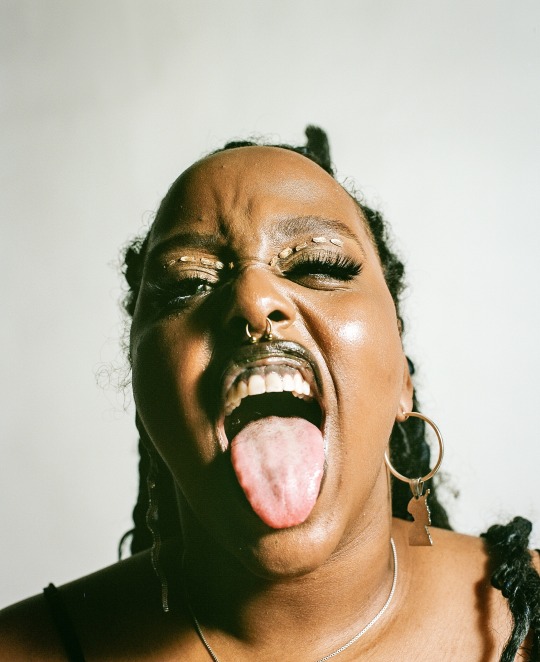
Photo credit: Jibril Yassin
Art has always been their medicine. It’s where they go to fill up, create, innovate, heal, and reimagine the world as they need it to be. And in a year that’s cried out for healing and reimagining, it’s no surprise this multidisciplinary artist replied with poetry, film, dance, music—and heart. Because no matter the form it takes, their artwork honours the spectrum of freedom for Black/Indigenous Peoples everywhere. This week’s “I Am YEG Arts” story belongs to NASRA.
Tell us about your relationship with Edmonton and how it’s influenced your path.
It has been a ride. I was born in Calgary, then was in Ottawa and Toronto back and forth until I was 11. So I’ve been in Edmonton since 2007. It’s been really formative—I owe a lot to this land—but I’ve also experienced more of the truth of who I am through fighting Edmonton and getting picked on by Edmonton for being who I am and wanting what I want for myself. So It’s definitely layered. But I am very grateful for the spirit of gathering that exists here. And I’m grateful for the underdog energy that it brings because I’ve come to a state where I do rep Edmonton, I rep Treaty 6, I rep Amiskwaciy. Whenever I go anywhere, it’s definitely because of that hidden magic that exists here—the power of people’s stories and creative energy that exists here. A lot of people don’t think that Edmonton has what it takes, and I love proving them wrong. So it’s a mixed bag.
You’re often described as a creative and an innovator. Why are both important to you and your work?
I guess, to me, they mean the same thing. In my imagination, they’re closer than they’re made out to be. I feel very connected to the identity of being a creative—maybe more so than an innovator—but I think that’s because creativity in my world has always meant innovation. It’s always meant creating something from nothing. It’s always meant manifesting and materializing what exists in my imagination and making that real around me. And whether that’s through a piece of music or a poem, I’ve always needed creativity because of how it innovates my life—how it could take my circumstances and reimagine the world that I’m craving in my heart whenever I feel like I want more. That’s what I feel like creativity is about.
You were named Youth Poet Laureate of Edmonton in 2016. What do you think it is about poetry that resonates so strongly with youth?
There’s no rules! I remember it was the one subject in school that was really based on my feelings, and my perspective, and my reality, and my truth. And it allowed us to go explore ideas that were often too lofty or that, especially as a young person, I didn’t have a right to speak about. You don’t have a right to speak about love, you don’t have a right to speak about trauma, and authority, and autonomy—you don’t have a right to speak about your dreams other than how they’re going to get you into the workforce.
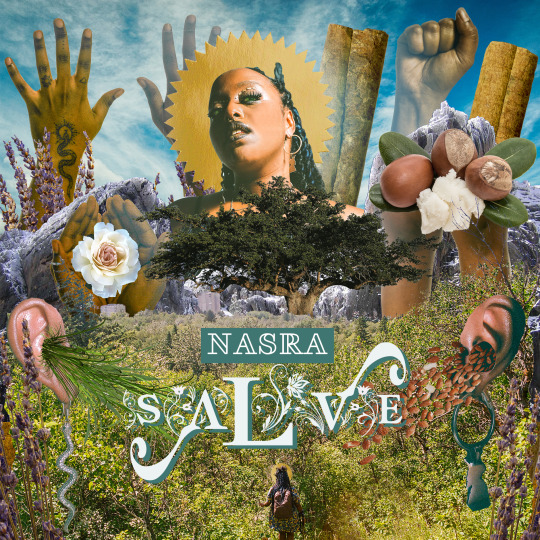
SALVE Ep cover. Design by Kaz Mega. Photo credit: Jibril Yasssin
Tell us about your ep, Salve.
Salve is my baby. And, honestly, I’m glad Salve exists just because it exists. I said I wanted to make music, and I made music! For me, music is my oldest dream… It’s also a collection of teachings that I’ve gathered around healing myself and a practical self-care that goes beyond bubble baths.
How would you describe Salve in terms of its style or influences?
I’m still trying to figure out what the style is myself, but it definitely pulls from a mixture of neo-soul and hip-hop, alongside a lot of base. The base is where I like to start, so it’s definitely base driven. And it’s a collection of spoken word along with music, and every song is about, and works with, the healing property of a certain herb because through herbal medicine, I’m connecting back to my African/Indigenous practices of healing. A huge part of what that album is about is how they have healed me through my practice with them.
Is there a piece of advice that you lean on when days are tough? What is it, and who offered it to you?
My mom, who is amazing, has always told me a variation of that phrase, “you are in the world, but not of it.” She’d also pair it with “don’t let this world take you.” As a child who was always very feely, and as a neurodivergent person and very sensitive human being, it is very often that some of my deepest pains and troubled times have come from just being overwhelmed by the pain I was experiencing—or just feeling by proxy. So, yeah, “don’t let the world take you. You are in it, but not of it.”
What does community mean to you, and where do you find it?
Wherever the love is. Yeah, wherever the values meet and the embodiment of those values meet—that’s where I find community. I am rooted in the belief that we are all connected, and I move through the world with that at the forefront. It’s how I was raised. I know that my values are pretty clear, and if I can align with folks on those values, and if the way they’re embodying them excites me and makes me curious and want to learn, I am all in. Let’s go!
Looking back on Black Art Matters (BAM), what’s one big thing it’s taught you about yourself and the arts community?
It’s taught me that I have to get real good at asking for help. It’s taught me boundaries—definitely. Again, I’m very dreamy and very feely, so I do have a lot of insight and ideas about how we can make things different—and different for me. That’s also at the forefront. A lot of this change is for me. I’m not out here for charity. I need the world to be nicer to me—to allow me to become who I am without trying to disappear me. I have a right to that. With BAM, I really grounded in the truth that If this isn’t serving me, it’s failed. And when I was experiencing burnout, I really needed to take that into account.
The chorus of the first song on Salveis: I’m the Black life that I’m fighting for / I’m the Black life that I’m living for / I’m the Black life that I’m loving for / I’m the Black life that I’m speaking for. It’s me, and I can’t create anything from me if it’s not also going to feed back into me. If it’s not going to pour back into me, there’s no use in that whatsoever. So I think that is a huge lesson that BAM has taught me: that I am the community that I am creating for. If that means I need to reel things in, or get more people to help, or take a nap for a year, I’ll do it.
I’m also living under and through multiple intersections that are actively being marginalized and systemically hunted and threatened. So I actually don’t have the privilege to just try something else. I have to figure it out and be the one who is the most responsible and in charge of my wellbeing. I have to call on my community to engage with the structures that it has set up for me and maybe change some of them so that I’m not working so hard just to choose myself every day when a lot of other people aren’t experiencing that much pushback. It’s not fair. I want to be fair to myself and call on my support systems to advocate for that care for me as well.
Which part of your creativity is unlocked when you collaborate?
I think the play gets activated for me, and I’m back in the sandbox when I get to collaborate. There’s always a perspective that I didn’t have access to, then all of a sudden it’s, ‘I didn’t even think about it like that because it wasn’t my job to, and now there’s a whole new world of possibility that we can access!’ When I collaborate, I also get to share the win. That’s my favourite part. It’s really nourishing, and it feeds me to then be able to go and be alone because I’ve been filled up.
Collaboration also activates my practices around vulnerability, and being wrong, and my ego… All of those things are valuable, even if I don’t feel like it at the time! They challenge me in those new perspectives. The play also opens you up to needing to let go of some of your ideas, and not experiencing them as precious little babies that you’ll never get back again. So that ego really has to soften and allow for that vision to be expanded. And even though it’s exciting, it can be uncomfortable as hell.
Is your starting place the same, regardless of whether you’re working alone or collaboratively?
Yeah. My starting point is always setting intentions and doing a bit of a needs assessment to see how big the “ask” is emotionally, mentally, physically, financially, spiritually. It’s me asking, ‘What am I expecting of myself and also from the folks that I’m working with, so that we can start from a place that is truly transparent?’

DNAPLAY by NASRA. Photo credit: Jibril Yasssin
Tell us a little about what you’re currently working on.
DNAPLAYis a multidisciplinary theatre piece that explores the routine as ritual. Coming from this quarantine experience and COVID experience, I’ve been called in along with my creative comrades to really venerate the tiny moments that actually aren’t so tiny when you look at the patterns that they belong to. And by looking at those patterns as ritual and as ceremony, I can give them the kind of sacred recognition they deserve because they’re what’s keeping me here. With this opportunity to slow down and take stock, I really wanted to remind myself that this is about who I am, not what I do. It’s about how can I really see the art in my every day and honour it so that I never feel like I’m not an artist—no matter what my paycheque or calendar is saying.
Salve is also going to be a backbone of the show. There’s going to be poetry, and film, and movement as the primary mediums that I’m channeling through. I’m very excited, and I’m working with a brilliant group of Black queer artists.
What makes you hopeful these days?
Oh, man. Definitely so much, but hope is where I live for the most part. But definitely the creativity of Black queer artists—and Black-Indigenous artists, and Indigenous artists across the board—is really feeding me. Communities that are on the frontlines in all shapes and forms, and who have a vision and are tapped in every day to innovation, and change, and imagination also give me hope. Looking back at history has always sustained and has a really great track record, so I’m really invested in Black imagination and Indigenous imagination for what could be possible for our lives and spirits.
You visit Edmonton 20 years from now. What do you hope has changed? What do you hope has stayed the same?
No more pipelines anywhere. I hope that people have homes, and that we have a really beautiful system of making sure people are living with dignity. And that there is a thriving, culturally diverse, and brilliant arts scene that has room for everyone to speak their peace.
Want more YEG Arts Stories? We’ll be sharing them here all year and on social media using the hashtag #IamYegArts. Follow along! Click here to learn more about NASRA, Salve, and DNAPLAY.

Photo credit: Emily Welz
About NASRA
NASRA is a queer Oromo/Somali multidisciplinary artist based in Amiskwaciywaskahikan (Edmonton). Everything NASRA creates stems from the Black Indigenous belief that art is nature expressing itself; a true language of languages that has and will continue to sustain Black life. This belief named them Youth Poet Laureate of Edmonton in 2016 and birthed their festival turned platform, Black Arts Matter. BAM celebrates the inherent worth of Black creatives in Alberta through performance, education, and paaaaaarties.
NASRA’s currently exploring their creative languages through DNAPLAY; a veneration of Black queer routine as ritual. Channeled through poetry, film, dance, and the genre-bending, bass-driven sounds of their ep, Salve. No matter the form it takes, NASRA’s heartwork honours the spectrum of freedom for Black/Indigenous Peoples everywhere.
Words by Adriana A. Davies, Feb 5 - 13, 2022
Artworks by Marlena Wyman Feb 8 - 20, 2022
Artists-in-Residence at Yorath House

Outing in Laurier Park 1913 - Marlena Wyman - image transfer and oil stick on Mylar (Image from City of Edmonton Archives #EA-10-2927-15).
I think it is time to start writing what is in effect a history of Laurier and Buena Vista Parks because that is the setting for Yorath House. I’ve spent about four weeks researching aspects of this history. It was difficult getting this information and, thank heavens for archives and digital records.
The stories of how Laurier and Buena Vista Parks came into being spans a period of over 100 years: from the end of the fur trade era to the 1950s. The land on which they are located was originally the home of Indigenous Peoples, specifically the River Cree. The ward name, Sipiwiyiniwak, means “People of the River” in Cree. Yorath House is located in what became Buena Vista Park. It is like a “bull’s eye” in the centre of this important piece of land.
Gold Seekers and Homesteaders
In order to tell the story of the “Western Parks,” it is important not only to find out who owned the land but also to examine emerging visions of what cities should be, and their relationship to the land. Land settlement is part of the story of the signing of treaties with Indigenous Peoples and filing of homesteads. Though the fur trade was essentially over when settlement began in the 1880s, a new resource drew fortune seekers. In 1859, James Hector, a geologist with the Palliser Expedition, noted the presence of gold flakes at Fort Edmonton.
Gold rushes had been occurring in various parts of the U S in the first part of the nineteenth century. Tom Clover, a Missouri native and veteran of the California gold rush of 1849, in the 1860s heard about gold being found at Fort Edmonton and made his way here. The section of the North Saskatchewan River that he worked in the 1860s became the Cloverdale and Clover Bar neighbourhoods. Several early Edmonton businessmen also started out in the gold fields of California and BC including Timolean Love, Jim Gibbons, Ed Carey, William Cust and Donald Ross. In 1862, over 170 gold seekers known as “overlanders” (in contrast to those who took maritime routes) passed through Edmonton in July.1 While the majority were heading to BC, about 60 stayed in Edmonton to pan for gold along the River.
The transition from gold seekers to residents happened in the next 10 to 15 years. In 1866, James Gibbons, from Donegal, Ireland, was one of those gold miners. At the age of 15, he travelled to the US in 1852 visiting a sister in New York and an uncle in Delaware. Greed for gold took him to California and Nevada before he headed North to the Fraser River in BC (1859) and, finally, Edmonton. The signing of Treaty 6 enabled gold seekers and others to file for homesteads. The cross-over to settlement in what became Edmonton’s west end took place as a result of a Hudson’s Bay employee from Scotland. Malcolm Groat signed on with the Hudson’s Bay Company in 1861 and served at Fort Edmonton. By the time he ended his service with the HBC, he was in charge of farming operations at the Fort. In 1870, after the HBC selected their 3,000 acre land reserve around the Fort, Groat claimed 900 acres along the western edge of the reserve (what became River Lot 2), and settled there in 1878 with wife Marguerite and their nine children. She was the daughter of Chief Factor William Joseph Christie. Other HBC employees including Métis did the same. They established the pattern of long, narrow lots with river frontages on both banks of the North Saskatchewan. Many of their names are reflected in neighbourhoods or land features.
On the Miner’s Flats, now Buena Vista and Laurier parks, three gold-seekers and friends claimed land: Gilbert John Anderson, Thomas Charles Stephenson/Stevenson (so-called “English Charlie”) and James Gibbons. In 1873 Gibbons married Mary Isabel Anderson, a stepdaughter of Gilbert Anderson. With the help of his wife, who was Métis, he made several trips to Winnipeg to bring back trade goods. After 100 years of the fur trade, family ties were complex as a result of the inter-marriage of HBC employees and Indigenous women. Linda Goyette and Carolina Jakeway Roemmich note in Edmonton In Our Own Words:
Their descendants take care to describe the mingled lineage: Gilbert Anderson, who grew up among Cree relatives in the Enoch band, inherited his name from a Métis great-grandfather who was an HBC employee; but he was also great-grandson of Chief Michel Callihoo and a [great]-nephew of the early gold prospector Jimmy Gibbons. “These people were contemporaries in a small community,” said Anderson. “The families intermarried in the early years and that’s how Edmonton began.
Gibbons wrote a reminiscence in which he notes:
Christie was in charge at Edmonton. There were about twenty-five families about the place. They were French Canadians, half-breeds, and Highland Scotch. William Borwick was the blacksmith. William Lennie was also a blacksmith; there were those days two kinds of Scotch – those who could speak English and those who could not. Jimmie Gullion was the boat builder assisted by his brother, George. Pig Kenny was in charge of the pigs. Malcolm Groat was in charge of the men. There were two clerks in the post – McAulay and McDonald. Sandy Anderson was the saddler and made the dog harness. John Norris was dog runner. Donald McLeod was in the company service at that time and I remember that he spoke very little English. Gilbert Anderson was sawing lumber for the Company, and William Meavor was getting out the logs.”2
Gibbons filed for a homestead comprising 80 acres “on the North side of the Sask. River,” in 1878 (Section 24, Township 52, Range 25, Meridian 4). The records note that he has a family of five and will be using the land for “mining, farming and trading.” The value was placed at $1,000. His witnesses were Stephenson and Anderson. He later got a pre-emption for the adjoining land and, in 1893, he noted that he had 40 acres under cultivation, 25 “horned cattle,” 15-20 calves and yearlings, and 40 head of horses, mares and colts. In 1885, he applied for a “patent of home.” Gibbons also served as the Indian Agent for the Stony Plain Reserve (1898-1908) and, in that capacity, was involved in three key surrenders of lands: Enoch in 1902; Alexander Band in 1905; and the Michel Band surrenders in 1903 and 1906. Gibbons was the founding President of the Old Timers’ Association in 1894. He also filed for a homestead in Stony Plain in 1902 and purchased land and built a house for his retirement at 125 Street and 105 Avenue (this is a designated historic resource). He died in 1933.3
Gilbert John Anderson appears in the HBC Archives database of servants’ contracts: in 1852, he is listed as a “labourer” and, in 1862, as a “sawyer labourer.”4 On July 23, 1885, he filed for homestead Section 25, Township 52, Range 25, Meridian 4, which is also part of the Laurier Park lands. On January 24, 1894, he did another filing for Section 26, Township 52, Range 25, Meridian 4. The record shows that he had been a miner for 20 years and had two children, and that this would be his permanent residence. He also notes that he had broken the land and had cattle, four horses, a chicken house and a stable. Anderson was born in Stenness, Orkney Islands, Scotland on July 1830 and died in Edmonton in 1915 and was buried in the Edmonton Municipal Cemetery.
The last of the three friends to file for a homestead, in 1885, was Stephenson. He filed for Southeast ¼, Section 25, Township 52, Range 25, Meridian 4. His witnesses were his friends and neighbours James Gibbons and Gilbert Anderson. The land purchased by William Wilkin on which Yorath House is situated is part of this homestead. Stephenson was born in England in 1838 and died in 1923 in Edmonton and is buried in the municipal cemetery. In most records, his surname is spelled “Stevenson,” which made it difficult to locate his homestead papers, which were under the name “Thomas Charles Stephenson.”
Alberta’s Capital City: The Rush to Urbanization
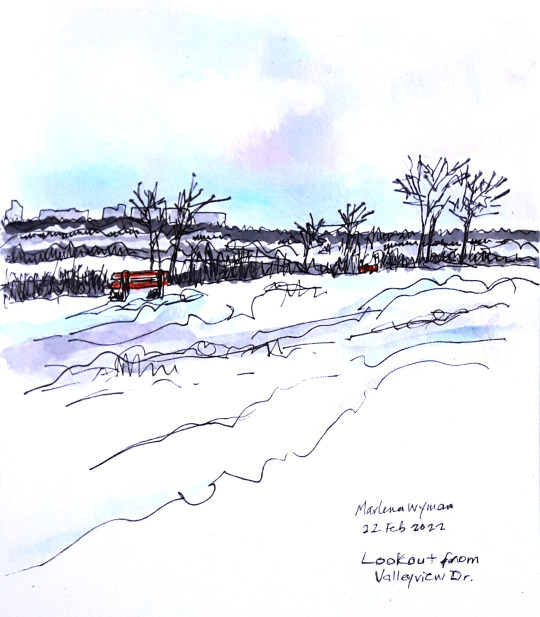
Painting of Valleyview Drive by Marlena Wyman.
Edmonton incorporated as a town in 1892 and as a city in 1904; in that time period its population rose from 700 to 8,350. In the early years of the twentieth century there was a feeding frenzy of property speculation. In 1903, Malcolm Groat sold his estate to property developers. In the same year, Charles Stephenson sold part of his land to realtor S. H. Smith, a city alderman (1906-07), for $12 an acre. Stephenson did not sell all of his land retaining a number of acres on which he and, later, his grandson, William Stephenson, resided. Maps from about 1912 show a square of land with river frontage in private hands.5
The extent of Edmonton’s property boom, partly fueled by the building of railways, is described by historian John Gilpin as follows:
Between 1903 and 1914, 274 new subdivisions were created, which inflated the assessed value of city property to $191 million. Most of these existed only on paper and would never be developed. This rate represented an 1800 percent increase in the number of subdivisions on the north side alone compared with an 800 percent increase in the total population of Edmonton between 1904 and 1914.
These new subdivisions were located on both sides of the river, with the largest concentration being northeast of the central business district. Mundy’s 1912 map of Greater Edmonton shows new subdivisions established as far as seven miles from the downtown area. The names chosen were common to other Canadian cities, and included Tuxedo Park and Queen Mary Park. With the exception of Windsor Park, Glenora, and Beau Park, these subdivisions did not deviate much from the grid pattern. The cumulative result was the creation of a blueprint for a “Greater Edmonton” that dazzled the imagination of Edmonton’s boosters, strongly influenced many aspects of civic policy, and created new opportunities for Edmonton real estate brokerage firms.6
The property speculation was also fueled by Alberta’s becoming a province on September 1, 1905 and Edmonton being designated as the capital in 1906. This was the result of powerful allies in Ottawa including Prime Minister Sir Wilfrid Laurier, who had been there at the inauguration of the province on a bandstand in the Rossdale Flats.
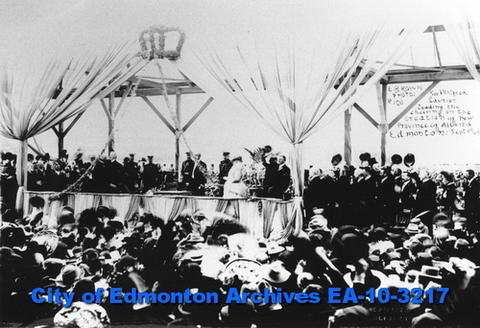
Sir Wilfrid Laurier speaking at the inauguration of the Province of Alberta, September 1, 1905 in Edmonton at the Rossdale Flats. Photographer: Ernest Brown, City of Edmonton Archives EA-10-3217.
The provincial government immediately began to plan for an impressive Legislature building and grounds, and 21 acres was purchased from the Hudson’s Bay Company for the site overlooking the North Saskatchewan River. In an article in the Bulletin of November 5, 1906, the headline states: “New C.P.R. Bridge Will Have Suitable Design: Architecture Will Accord With Surrounds and Harmonise With Provincial Buildings.” Premier Rutherford himself met with Sir Thomas Shaughnessy, head of the CPR, to discuss this and tells the journalist that landscape architect “Mr. F. G. Todd of Montreal” has been contracted, and notes that the same process was happening in Saskatchewan. The Province chose Todd because of his impressive credentials: he had studied with pre-eminent American landscape architect Frederick Law Olmstead, the designer of New York’s Central Park and Montreal’s Mont Royal.

View of Fort Edmonton with the completed Legislature Building behind, ca. 1912, Photographer: McDermid Studio. Glenbow Archives NC-6-234.

Drawing of proposed approach to Legislature building, 1912. The Legislature was built in the period 1907 to 1913, in the Beaux-Arts style and is an impressive steel-frame, sandstone and granite structure. It was designed by architects Allan Merrick Jeffers and Richard Blakey and Montreal architect Percy Nobbs helped with the final revisions. Photographer: McDermid Studio, Glenbow Archives NC-6-160.
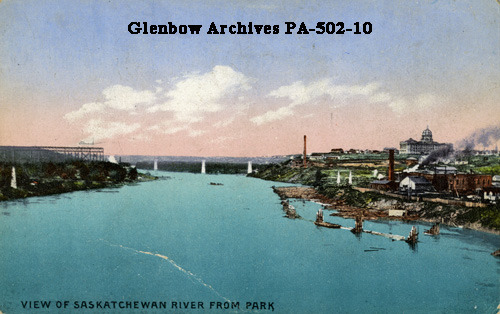
A postcard showing a panoramic view with the completed High Level Bridge and Alberta Legislature, ca. 1917-1918, Glenbow Archives NA-5002-5
The City of Edmonton Archives has extensive correspondence pertaining to parks development in the period 1906 to 1912, including Todd’s 1907 typewritten report that presents a grand vision for the City. In November 1906, Todd was contracted “to prepare a comprehensive beautification scheme for the city” for a fee of $500. He begins by praising the civic government for initiating planning early and cites a number of examples of cities that had not done so, and had to do very expensive remedial work.7 He sees no limits for Edmonton, the capital of a resource-rich province, and makes a key recommendation:
In evolving a comprehensive scheme for parks and boulevards for Edmonton, every advantage should be taken of the great natural beauty of the situation, and also attention must be given to the economic interest of the city, by withdrawing for park purposes, property which is of least value for building, if it is equally valuable for park purposes. Indeed it often happens that the land most unsuitable for building is the best for park purposes, such as the sides of steep ravines and hillsides.
The report has the following sections: East and West End Parks, North End Park, Hudson Bay Flats, Ravine and Hillside Parks, Rat Creek Park, Groat Creek Park, Small Parks and Playgrounds, Boulevards and Parkways, Boulevard to Groat Creek, Boulevard to Rat Creek, Hudson Bay Boulevard, Namayo Boulevard, Capital Boulevard. He devotes a final section to “Plantings.” Thus, before Edmonton had even begun its urban development, it was committed to becoming a “green” city and part of the Garden City Movement that had gained dominance in the UK, the US and Australia. In 1898, Ebenezer Howard published a book titled Cities of Tomorrow. In it, he espoused a method of urban planning in which towns and cities are surrounded by “green belts” and a balance is struck between housing, industry and agriculture. Three such communities were built near London and he received a knighthood.
In the section titled “East and West End Parks,” Todd praises the City as follows:
Your city has already made a commendable start in the way of supplying its future generations with ample breathing space, by purchasing a good sized park East of the city, and one in the Western part of the city. These are splendid properties and well adapted to the purposes for which they have been set apart, and I would suggest that when these are developed later on as the city assumes a larger size, that as much as possible of their present natural beauty be retained, and that their natural picturesqueness be further increased by planting of many trees and shrubs in an irregular and natural way. When drives and walks are built they should be designed with graceful curves, and arranged with the existing and proposed woods in such a manner as to present the park to the best advantage.
The west end park purchase that he refers to is an as-yet unnamed area: it is part of the North ½ of Section 24 and West ½ of S.W. ¼ of Section 5, 52, 25, West of the 4th Meridian. The 205 acres belonged to James Gibbons and the city paid $25,625. The purchase was made through the power plant capital account because, initially, the City intended to move its power-generating facility from the Rossdale Flats to this site. In the City records, and also in articles in the Edmonton Journal and the Edmonton Bulletin, the matter is discussed. A December 29, 1906 article in the Bulletintitled “Recommends Gibbons Site for Water Work” notes that the Commissioner had had specifications prepared for a water treatment facility that would supply “three-million gallons” through a “direct-connected, motor-driven pump.” The other part of the proposal was for a power plant.
The move seemed to be supported by the City Commissioner because not only was there ample land but also water and coal. An article in the Journal of October 10, 1907 titled “New and Extensive Improvements Are Being Planned for Edmonton” provides information on the equipment for the power plant including generating capacity and notes that testing of coal deposits had been done. It does, however, point out an issue: “The Gibbons’ property is about three miles from the centre of the city in a direct line, but owing to a bend in the river it is about five miles distant by trail. In order to transport the heavy machinery to the plant to the site, and to provide communication with other coal mines in case the fuel supply should at any time fail, it is considered necessary to construct a spur line to the property.”
The urgency of expanding the current power plant and the drawbacks of Gibbons’ land supported the vision provided by Todd in his report, and the decision was made not to build on the west end site. By 1909, the Journalwas advocating for the location of a park there with the support of the City’s medical officer Dr. T. M. Whitelaw, who gave his hearty approval for a “large suburban park.” On July 29, 1910, it reported: “The advisability of christening the McGibbons [sic.] property Laurier Park will be considered at a special meeting of the council which has been called for Monday at 10 o’clock. At this meeting also a resolution urging the removal of the penitentiary from its present site will be drafted. The resolution will be presented to Sir Wilfrid Laurier during his stay in the city.”
Removing a penitentiary and designating an urban park were both part of the beautification of the City. The new provincial jail would be moved to Fort Saskatchewan, a more remote community in which to situate dangerous offenders. In 1910, Laurier travelled across Western Canada via railway for a period of two months. It was an electioneering trip to get in touch with this fast-growing region of the country. He stopped in Edmonton on August 10 where he was honoured by the park naming.
The influence of Frederick Todd cannot be underestimated. We experience it every time we walk or drive along roads and walkways on the embankments on both sides of the North Saskatchewan River. These reflect the following recommendation in his report:
The advantage of a system of boulevards and driveways connecting the different parks surrounding the city is of such obvious importance that it is hardly necessary to dwell upon it. Few cities have such splendid opportunities for magnificent scenic drives as Edmonton, and it will always be a matter of regret to future generations that land for a boulevard along the entire river embankment was not secured until it was too late to make it continuous. There is however still left the opportunity of obtaining boulevards commencing a little east, and a little west of the city, and the land for these it seems to me should be secured at as early a date as possible.
Laurier Park was the beginning of over 100 parkland purchases that the City undertook in the period 1907 to 1931. These included the Highlands golf course and the Mill Creek, Groat, Mackinnon, Kinnaird and Whitemud Creek ravine lands.8
With respect to the “West End Park,” on October 19, 1910, a proposed nursery was approved; the site comprised five acres. A December 20, 1910 document provides costs for clearing the land of burnt and dead timber. Itemized costs include: ploughing of 37 acres; brushing of 75 acres; mowing, curing, stacking of hay on 50 acres. In another document of the same date, the following activities with accompanying costs are listed:Todd had recommended the planting of many trees and the City took his advice to heart. On April 4, 1911, a Blue Print of the layout of the West End City Park is requested from the Engineering Department (unfortunately, it is not in the file).
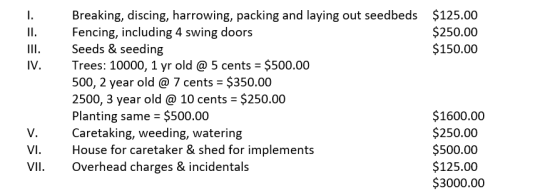
Todd had recommended the planting of many trees and the City took his advice to heart. On April 4, 1911, a Blue Print of the layout of the West End City Park is requested from the Engineering Department (unfortunately, it is not in the file).

A family outing at Laurier Park in 1913; trail for not only walkers but also people on horseback was developed. Photographer: Byron May Co. City of Edmonton Archives 2A-10-2927-14
While Todd had set the City on the development of parks, in 1912, correspondence reveals that other landscape architects were also being consulted. Whether this was because Todd was unavailable or “new blood,” as it were, was needed is not clear. A September 16, 1912 letter from American Park Builders, Chicago, requests that they be placed in a position to bid for projects. They note that they can either plan and build the park, or use the plans of other landscape architects. To support the application, they note that they are responsible for the Lincoln Park System in Chicago.
Correspondence also relates to other parks existing at the time including Rat Creek Ravine and Victoria Park; and the building of proposed East and West “river drives.” All are costed fully by A. J. Latornell, the City Engineer. Other projects include roadways leading to the Legislature and the proposed CPR High Level Bridge. A letter dated September 26, 1912, deals with the acquisition of three ravines in the Quesnell subdivision for park purposes. It notes: “Quesnell Ravine would form a desirable addition to Laurier Park to the West, while the other two would form a nucleus of two parks between Laurier Park and West End Park. All three are useless for building purposes.” Market sites on both the North and South sides of the River were also planned.
The Parks Commission delivered its first report on December 31, 1912. During the year, they received proposals from Morell & Nichols, Landscape Architects and Engineers of Minneapolis for park planning work. They were invited to produce a report. In 1912 and 1913, at the recommendation of Morell & Nichols, prominent town planners from the US and Great Britain were brought in to provide public lectures. In addition, the Report notes that “A Womans Club has been formed for the purpose of studying Town Planning on the basis of Mr. Morell’s report.” To help get the message out, it is proposed that 2000 copies of the report be printed and sold to clubs at 50 cents per copy. It is also suggested that copies be made available free of charge to high schools and the University. Finally, the recommendation is made to Council that Morrell and Nichols be retained as the City’s town planning experts.
A January 23, 1913 letter from P. M. Barnes, Assistant Superintendent of Parks to Mr. R. B. Chadwick, refers to a report prepared by the Provincial Archivist, Miss Katherine Hughes, with recommendations for the naming of Edmonton Parks. They are as follows:

What is fascinating is that, in this era of white dominance, the Provincial Archivist recommended the following names: Cree Embankment, Metis Park, Blackfoot Park and Assiniboia Park.
According to her entry in the Dictionary of Canadian Biography, prior to coming to Alberta, she was linked to Indigenous causes. She was born in 1876 in Prince Edward Island and became a teacher and journalist and was a member of the Canadian Women’s Press Club. Her Uncle, Cornelius O’Brien was Archbishop of Halifax. According to the DCB entry, written by Pádraig Ó Siadhail,
Biographical sketches claim that she was involved in mission work for the “uplift” of natives in eastern and central Canada. In the summer of 1899 she was employed as teacher at the Mohawk reserve of Saint-Régis (Akwesasne). Two years later Hughes launched, with ecclesiastical support, the Catholic Indian Association, which sought to find employment outside reserves for graduates of Indian schools and, reflecting contemporary attitudes to natives, assimilate them.9
In 1906, she moved to Edmonton to work for the Bulletin reporting on provincial politics. In May 1908 she was appointed as the first provincial archivist and charged with developing the Bureau of Archives. In 1909, she was seconded to serve as the private secretary to Premier Alexander Cameron Rutherford and served in the same position for his successor, Arthur Sifton. In September 1913, she accepted the position of assistant and secretary to the agent general for Alberta in London, England.
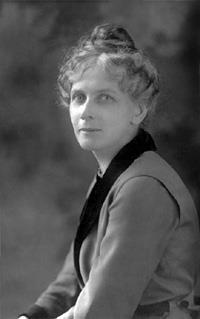
Katherine Hughes, first Provincial Archivist of Alberta, ca. 1906. The Provincial Library of Alberta along with the Provincial Archives was established in 1906. Provincial Archives of Alberta A5398.
Besides the list of names, Hughes also provided suggestions as to the historical periods to be commemorated through naming. This is an amazing document for its time. The periods are as follows:
1. The Indians.
2. The coming of the fur-traders, voyageurs, &c.
3. The rise of a new race – The Metis (mixed blood), halfbreeds.
4. The advent of a, The Missionaries, b, the gold miners, c, distinguished travellers or explorers (like Palliser, Southesk, Kane, Butler &c.)
5. The pioneers (free traders, independent of the big fur companies, settlers on farms &c. Mounted Police.
6. The era of the klondyke rush – very brief period, but one fraught with results, affecting Edmonton’s development.
7. The present day period of record making, growth and progress.
In April 1913, Morell & Nichols were advising about the setting up of shelters at East End Park, Groat Ravine, Laurier Park and South Side Park. Advice is also given on the building of playgrounds and a “swimming pool on Syndicate Avenue.” They also suggest that a gymnasium be added to the pool, perhaps the first multi-use recreational facility in the City. It is noted that the consultants had provided three “schemes” to date. In January 1913, the City hears from another landscape architect wishing to do business with the City: Thomas H. Mawson & sons from Vancouver. Their credentials and extent of their work is impressive. It is clear that the Commission is taking its work seriously and they add another name to their roster: L. L. May & Co. Inc. Nurserymen, Florists & Seedsmen from St. Paul, Minnesota.
Civic-minded individuals or, perhaps developers who had an interest in enhancement of their own property development ideas came forward to offer land to the City. Perhaps the most extensive was the proposal by Dr. L. L. Fuller of Strathcona to donate property for the development of Glen Lockhart Park in the Whitemud Creek area. The Bulletin of June 12, 1912 reported on the proposed donation of land as follows: “The only conditions attached to the offer are that the City develop the valley as a high class recreation and amusement park and make it possible for the citizens to get to it by building a car line to it. The exact area offered to the city will not be known until the survey is complete. It will be between 275 and 300 acres. The proposed lake will be 1 ¾ miles in length and some 100 acres in extent.” Fuller proposed building a dam to create Lake McKeen, which could be used by pleasure craft and could also be stocked with fish. The “park fever” incited by Todd would come to an end with the recession that began in mid-1913; this also would end the existence of the Park Commission.
Land Development: The West End
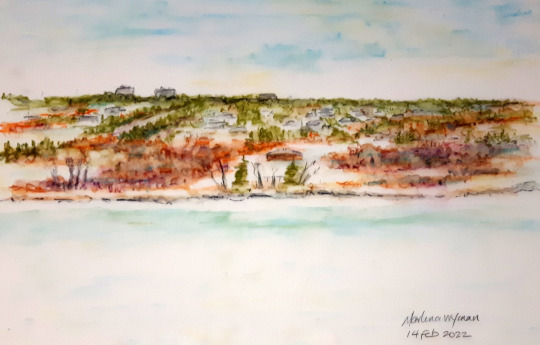
Yorath House and Laurier Heights from across the river - Marlena Wyman – water soluble wax crayon on Mylar.
While so-called “highlands” were the preferred sites for subdivisions for the wealthy and upwardly mobile (think of Ada Boulevard, Saskatchewan Drive, Connaught Drive and Valleyview Drive), areas bordering on parks were similarly desirable. There were enormous opportunities for realtors and property developers, who purchased lands adjacent to city limits to avoid paying taxes, and subdivided them into subdivisions. In 1906, Martin Runnalls established M. Runnalls Real Estate and Insurance Company and began land speculation. The year 1911 sees Runnalls entering into a partnership with Walter Ramsay, owner of greenhouses at Victoria (100th) Avenue and 110 Street and teacher; Dr. Edgar Allin, a medical doctor; Dr. Harry R. Smith, also a doctor; James H. Smith, realtor and land surveyor; and Norman B. Peak of Vancouver. They begin promotion of a new subdivision that Runnalls named Buena Vista (“beautiful view”) in keeping with Frederick Todd’s vision. They acquired land in River Lot 2, the old Stephenson homestead on the banks of the North Saskatchewan. Part of this might be the land purchased by Sam Smith in 1903 (I have been unable to determine whether Smith, the doctor, or Smith the realtor, were relations). A Plan was drawn up and it notes that the subdivision is part of Section 25, Township 52, Range 25, W4 of the Meridian and is described as Capital Hill South. The owner of the land is listed as William Stephenson. An ad in the Bulletin of April 26, 1911 has an image of the subdivision and offers lots for sale. It’s a boilerplate grid design with streets numbered “thirtieth” to “thirty-eighth” and the proposed avenues from north to south named: McMillan, Michigan, Hastings, Spadina and Laurier. The last reflects the nearby park. Lots are priced from $100 to $300 and the ad notes: “One-third Cash. Bal. 1 and 2 years at 7 per cent. Or 6 and 12 Months Without Interest.”
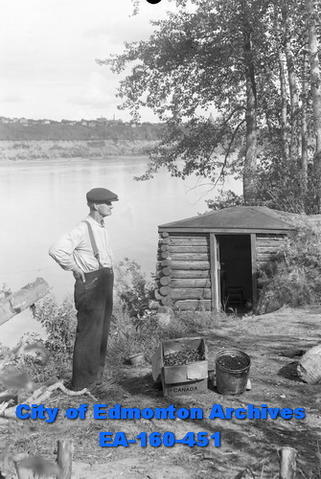
Squatter on the banks of the North Saskatchewan River, 1938. Photographer: Hubert Hollingworth. City of Edmonton Archives EA-160-451.
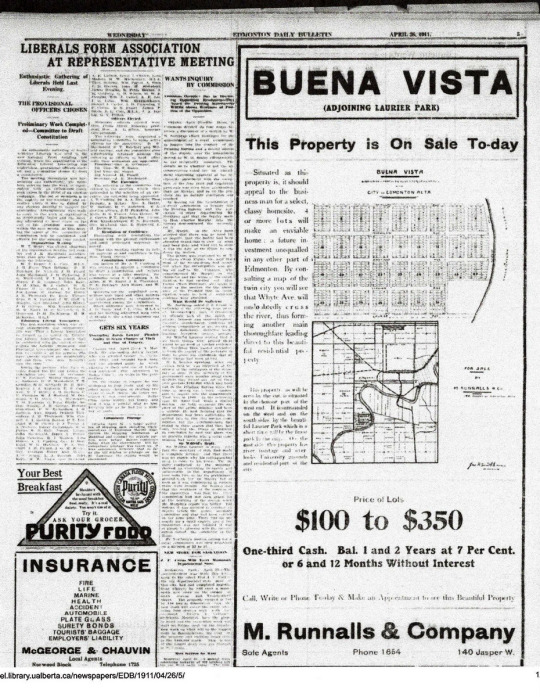
Buena Vista advertisement. Edmonton Bulletin, April 26th, 1911.
Another venture, in 1912, was the erection of a brick and concrete apartment building – the Buena Vista Apartments – with retail on the ground floor at 12327 – 102 Avenue. The building, designed by local architects Herbert Alton Magoon and George Heath MacDonald, cost about $11,000 and, when it opened in 1913, the Bulletin described it as “a most desirable residential property in the west end.” While this venture was a success, the companion subdivision was not completed though some houses were built.10 The recession prior to the First World War ended speculation in property.
The 1912 Driscoll & Knight Map of the City of Edmonton shows the huge land mass of the City (developed and undeveloped). In the left hand bottom corner, Laurier Park and Buena Vista lands are green areas forming an “L” shape. The vertical piece is Laurier Park (the current park is a smaller area because the Storyland Valley Zoo was built on the land in the 1950s) and the horizontal piece, by and large, is the unbuilt Buena Vista subdivision. There is a square piece of land that is unidentified; this is the Stephenson land that Yorath House would be built on.

Driscoll and Knight Map of the City of Edmonton, 1912, City of Edmonton Archives EAM-86.
A review of the City Tax Rolls for selected years beginning in 1907 is very revealing. The degree of land speculation can be clearly seen in the number of properties owned by companies such as McDougall and Secord, the Riverview Land Company, Weber Bros. Realty and other businesses, as well as individual investors. Many did not reside in the City; for example some resided in Vancouver; others in various parts of Ontario and other Canadian provinces; and some even in the UK. As well, city-owned lots for parks and other developments are noted as are those owned by religious denominations (such as the Faithful Companions of Jesus) and designated for use as locations for churches, schools and hospitals. The earlier years in the rolls are listed in no particular order: just dates when property taxes were paid. Later, they are organized according to the name of the subdivision and it is easier to review all of the Buena Vista records.

City of Edmonton Tax Rolls selected years from 1907. City of Edmonton Archives. Photographer: Adriana A. Davies.
The economic recession can be seen in these records and the column of payments with red ink indicating arrears becomes the norm. As individuals and companies defaulted on tax payments, the City seized the property in lieu of payment and then would hold property sales with ads appearing in newspapers. Buena Vista lands owned by the Riverview Land Company, which were likely seized by the City for non-payment of taxes before 1915, appear in a 1918 advertisement for the sale of City-owned land in the Bulletin (Monday, June 10, 1918). It is noted that a number of properties, including Buena Vista (the first on the list), were removed from the sale. This may mean that either Runnalls and his partners paid the arrears, or that someone else purchased the land. The 1920 tax rolls show a number of Runnalls or Riverview Co. properties not only in Buena Vista and Laurier Park areas but also in other parts of the City being in arrears; however, very few have a stamp indicating that they had been/or were to be sold.
I examined Tax Rolls for select years beginning in 1907 and this proved fascinating. All of the noted property developers are there (many of whose names are immortalized in City features including roads, parks and subdivisions) can be seen to own property all over the City. Martin Runnalls from 1911 owns a lot of property not only in River Lot 2 but also in other areas of the City as does the company he created with partners, the Riverview Land Company. The year 1921 is fascinating because of the number of property owners who are in arrears; the status column noting arrears is literally bleeding red. Both Runnalls personally and Riverview Land Company are in arrears in many properties; however, they have not as yet forfeited their properties for non-payment of taxes. Many individual landowners had. The City was in major debt and this faced the new Commissioner for Public Works, C. J. Yorath who was hired in 1921. He had held the same position in Saskatoon from 1913 and had got them out of debt as well as developing the new City Plan based on Garden City models. The Tax Rolls get easier to review once they are set out according to subdivisions/neighbourhoods. Buena Vista had quite a number of residents indicating that Runnalls and the Riverview Land Company had succeeded in selling lots and houses had been built.
From the 1907 Tax Roll onward, it can be seen that as new immigrant groups arrived in the province, they purchased land. This includes not just people from the UK and the US but also Ukrainians and Germans. A number of properties are also owned by women. In Buena Vista, there are about 34 property holders listed in the Tax Rolls including lots 8 to 14 owned by W. L. Wilkin and his wife Hilda Wilkin.
The recession prior to the First World War continued through the war-time years when government funding was focused on the war front, through the 1920s, the Great Depression of the 1930s, and, then into the Second World War. Surprisingly, during these difficult times, the City of Edmonton and province of Alberta did not lose their interest in beautiful communities. In 1928, the Town Planning and Preservation of Natural Beauty Act was passed by the Government of Alberta. While the “natural beauty” in the title suggests that some of Frederick Todd’s tenets are embedded in it, this is not the case. The legislation enabled municipalities to formulate and carry out planning schemes and is as dry-as-dust.
City records in the Archives indicate that just before the Dirty Thirties, Edmonton officials were much preoccupied with town planning as they prepared to host the Town Planning Institute of Canada Convention. The 1930s brought an end to most planning activity in Canada and the Institute was disbanded in 1932 and not revived until some 20 years later. The List of City Parks 1931 is an important document because it shows the progress that the City has made since 1907 when Todd promoted the designation of parks sites. Two land acquisitions in the document are of particular interest because they pertain to the area of the “westerly park”:
Quesnell Heights
All that portion of N.W.¼ of Section 23-53-25 W. 4th, 107 Acres, excepting thereout the areable land, 51.2 Acres more or less.
Date Acquired: 1918.
Purchase Price: no price listed (could this be a property forfeited for non-payment of taxes).
Land Assessment: $3,250.00.
Area: 55.8 Acres.
Laurier Park
Pt. of the N.½ Section 24 & W. ½ of S.W. ½ of Section 25-52-25 W. 4th.
Date Acquired: 1906.
Purchase Price: $25,625.00.
Land Assessment $20,500.00.
Area: 205.0 Acres.
This document also refers to a significant land donation in Groat Estates/Glenora; the wording is as follows: “Donated by Jas. Carruthers in consideration of Bridge over the Ravine being built forty feet wide. The Title is subject to a Caveat filed by Jas. Carruthers.” This would set a precedent for donations of land for park purposes. Carruthers was a Montreal grain merchant and entrepreneur who, in 1905, purchased the Groat homestead from other real estate promoters. His plan was to build a subdivision for individuals who could afford to spend at least $3,500 on a residence; this subdivision became Old Glenora. Carruthers faced the difficulty of getting over the Groat Ravine; as a result of some wheeling and dealing with the City, in 1909, he committed to build a 20-foot wide bridge in exchange for a municipal street car route on 102 Avenue into his subdivision. After further negotiations, Carruthers committed to building a 40-foot wide bridge and donated two parcels of parkland in the adjacent Westmount area in exchange for the City paying the additional bridge building costs. The bridge was built in 1910; however, because of the recession that followed shortly after in 1913, his grand vision was truncated but the city retained the donated property. Eventually, Westmount would be developed as a suburb for young professionals.11 The Edmonton Historical Board entry on the suburb notes:
Thought to be named after the suburb of Montréal, the community of Westmount is bounded by Groat Road, 111 Avenue, 121 Street, and Stony Plain Road. It also includes the Groat Estate area south of Stony Plain Road between Groat Road and 124 Street. A large portion of homes in this neighbourhood were built in the land boom of 1912. Apartments make up about half the living space, but only appeared relatively recently in the 1960s and 1970s along major traffic routes.
A key piece of legislation was passed in 1933 – the 1933 Zoning Bylaw that delineated 12 zoning districts that specified use and building type. It would appear that the City was prepared for orderly development but this would have to wait until the late 1940s.
A rebound in property values and development required the coming in of the Leduc and Redwater oil fields in 1947 and 1948, respectively. This began a boom that would last until about 1980. In this period, the City of Edmonton grew dramatically and infrastructure to support the growth was built. This was the era of the Modern Style epitomized by the architectural firm of Rule, Wynn and Rule. With respect to development in the west end, the realty firm established by L. T. (Timothy) Milton came to the fore. Melton came to Edmonton in 1918 from Winnipeg and learned the business in the offices of Allan, Killam, McKay and Greene where he worked until 1922. The next year, he opened the Stanley Investment Company named for his son, and, in 1932, the company changed its name to L. T. Melton Realty. A 1945 ad in the Journalof May 17, 1945 advertises a subdivision as follows: “River Frontage and Capital Hill South 138 St. and 90th Ave. Acre lots $40 cash, balance $25 per month give you title in 10 months. West End Acreage ‘in a growing city is the best investment on earth’.” The West End Office is located at 14921 Stony Plain Road.
In 1947, his son Stanley, on returning from fighting in the Second World War, took over the firm and filed a subdivision plan for Capital Hill South (N.E.¼ & N.W. ¼ Sec. 25 – Tp. 52, Rg. 25, M 4). It shows a strip of land, named Melton Hill, above what is now the Valley Zoo. This indicates Melton’s interest in the development of the West End communities running across the brow of the north bank of the North Saskatchewan River (Capital Hill, Valleyview, Crestwood, Parkview and Laurier Heights). The company website notes: “Development of the Laurier Heights subdivision residential neighbourhood in west Edmonton begun postwar with approximately six out of every ten residences (58%) being built between 1946 and 1960, and approximately four in ten residences being built between 1961 and 1970.” By 1953 there were 16 Melton branch offices in Edmonton.
The Wilkin and Co. realty and insurance firm was tiny in comparison to the Melton and Weber Bros. firms but, according to Richard Wilkin, his grandfather likely acquired the riverside lands in the Buena Vista subdivision around 1945. That was the year that he purchased land on Connaught Drive to build a home for himself and wife Hilda. The firm, which in the 1950s was run by Wilkin’s son Bill (Richard’s Father) had its offices on the ground floor of the Buena Vista Building on 124th Street and 103 Avenue. When Dennis Yorath, Wilkin’s son-in-law was transferred from Calgary to Edmonton to head Northwestern Utilities, he required a home for wife Bette and daughters Gillian and Jocelyn. Whether Wilkin senior donated the land or sold it to Dennis is unknown; Richard says either option is possible since his Grandfather was a shrewd businessman and his Uncle would have had some type of housing allowance from the company.
There is no question that the house that Dennis and Bette built in 1949 was intended to make a statement: he was part of the elite of Edmonton/Alberta businessmen intending to lead the province into its second half century. The couple chose the architectural firm of Wynn & Rule to design a two-storey home. The house, which was 4,380 square feet, was built near the river edge on a 12-acre lot. The building remains a symbol of design and architecture of the period known as the Modern Style. The house was distant from other subdivisions with few amenities nearby. It seems that Dennis as head of Northwestern Utilities was able to get power there, gas came later as did water (until at least 1959 they used well water). The house had to be reached via 81 Avenue because Buena Vista Road did not exist.
The few houses nearby in what would have been the Buena Vista subdivision were, according to Richard, small cottages or even shacks. Agricultural activities were still taking place in the area and there was a gravel pit in what is now the car park near the house. For a time, there was even a mink farm. Dennis donated a fieldstone chimney, what was left of the original Stephenson log home to the City. A letter in the City Archives dated October 22nd, 1949, thanks him for the gift and notes: “The fireplace is to be rebuilt, according to current plans, at some suitable location and when this is done the descriptive placard to be attached will make note of your thoughtful donation…. As you know, the fireplace was the oldest relic of early Edmonton still in existence. Without your permission for removal, it would have been lost forever.” The City would later inform him that the fireplace could not be rebuilt. There are, however, some fieldstone pillars at the entrance of the property and the family built a cairn near the embankment to honour the Wilkins. The building of the Yorath home would mark a shift in the City’s planning with respect to River lands.
Rebirth of the Garden City
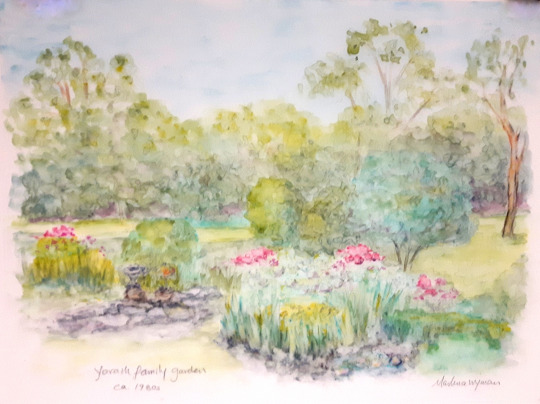
Yorath family flower garden ca. 1980s by Marlena Wyman – water soluble wax crayon on Mylar (based on a family photo of the garden).
The year 1950 saw the City repeal the 1933 Zoning Bylaw on the grounds that it was outdated and passed the Interim Development Bylaw No. 1. This enabled Council to make development decisions based on individual cases. An article in the Edmonton Journal of February 27, 1951 titled “New Subdivision Plan Authorized,” notes:
City council Monday night authorized the filing of a subdivision plan for residential development in Capital Hill south. To this was added a recommendation that the city exchange land it owns for privately owned lands in order to protect riverview land.
Commissioner Menzies estimated it would be at least two years before utilities were brought into the area. He also said there would be restrictions as to the type of residence which could be erected. Ald. Clarke had remarked that this was one of the good residential areas available in the city and asked for assurance there would be restrictions on the type of house constructed.
The upshot of Council deliberations was that further park development would occur in the Laurier Park area and that the City was prepared to use the “first right of refusal” to force property holders to sell to them. A further article in the Journal of April 4, 1957 titled “Buena Vista Park Plan Wins Committee Vote,” notes that the Finance Committee had recommended development of the Buena Vista lands around 142 Street to be developed as a park. There was, of course, opposition and residents who opposed the plan were represented at the Council meeting by Cameron Steer. He is quoted as follows:
Mr. Steer charged that “What the city really seems to be doing is freezing the home-owners’ capital until the city is good and ready to use the land for its own purposes.”
“The city is obligated to buy as soon as the home-owner is ready to sell.” Mayor Hawrelak answered. How is this any different from about 50 other situations in the city?”
“In this case the city doesn’t intend to do anything for years,” Mr. Steer said. He argued that residents moved into the area under the assumption it was residential land “and in June 1954, like a bolt out of the blue, the situation was changed.” That, he said, was when council decided definitely the land would be used for park purposes although as commissioner Menzies pointed out, it was zoned as park in 1933.
Prior to the interim development by-law in 1951, “the private owner could develop the land as a unit.” Mr. Steer said. “In 1951, that protection was taken away.”
The April 1958 Map of the City of Edmonton, according to the legend, shows transit routes, public and separate schools, hospitals and neighbourhoods as well as the City boundaries. It provides an aerial view of Laurier Park and the Buena Vista subdivision spanning 34 lots from 76th Avenue, which is closest to the River, to 8th Avenue, and from 138th Street, which borders on Laurier Park, to 130th Street. It also shows the layout for the Valleyview and Laurier Heights subdivisions. The creation of Buena Vista Park is evident. The area dedicated to Buena Vista Park and Laurier Park comprises 110 hectares, while the residential neighbourhood comprises 132 hectares.
The 1951 tax rolls list the following owners of land in Buena Vista: Hilda R. Wilkin and W. L. Wilkin (owed A78, A79 and A80); City of Edmonton (gravel pit, A81, A82 and A86a); Edward B. Fisk; Margaret Smillie (New York); Arthur S. Cummings; Arthur S. Cummings (Winnipeg); Andrew & Muriel Lucas; Robert F. & Audrey G. Aitchison; Philip Gabel; Frederick M. Wilson; J. Wilbert Wright; Estate of B. S. Muttart; Amy E. Sherman; Ella M. Muttart; Esther Ross Clindinin; Harley G. Nilson; Bertha M. Challis (Altadena, Calif., U.S.A.); City of Edmonton, A22 Lots 12 & 13; Evelyn M. Allen; Cecil B. Atkins; Chas. W. Hosford; Thomas & Mary V. Sinton; Cecil B. Atkins; D. G. Sandilands; Evelyn M. Allen; William A. Dreany; J. R. Washburn; William A. Dreany; Nolan O. Blaylock (owned multiple lots A37, A38, A39 and A40); Christie V. Blaylock; Winnifred Crawford; Charles A. H. Lawford; Florence E. Deltombe; Hollis D. Howard; Arthur S. Cummings; John Welling; Frank H. & Bessie C. Kenwood; Albert F. & May D. Oeming; Wolfred J. & Leona M. Law; Daniel J. & Eva Driscoll; Wilfred J. & Leona M. Law (they owned two lots A59 and A59b); Albert F. & May D. Oeming (owned A60 Lots 16 to 20); City of Edmonton (owns a series of lots A62, A63, A64, A66, A66a (old gravel pit); Alberta & Hattie Lewis; John F. & Winnifred Crawford; Albert & Hattie Lewis (owed A70 and A72); John W. & Winnifred Crawford (owed A72c and A72e); Charles Henry Smith (W. Finchley, London 3, England); Jessie A. Ohlsen; Earl Enger (owns A74 and A75); Merrill H. & Winnifred C. Baker; Maud L. Thomas (New York); Florence Southall; and George M. & Jean Bates (owned A77a and A77b).
There are a number of interesting observations: some of the owners did not live in Edmonton; a number owned multiple properties; and the City already owned property in the subdivision. Richard Wilkin and the Yorath sisters (Gillian and Elizabeth) remember a number of agricultural enterprises there including a stable (the family also kept two horses on the property), a berry farm and a mink farm. Gillian remembers when newly-licensed driving her car through the gravel pit and almost tipping the car over with her baby sister inside. Elizabeth remembers Al Oeming and his fierce cheetah, which he kept on the property. This was in the 1950s.
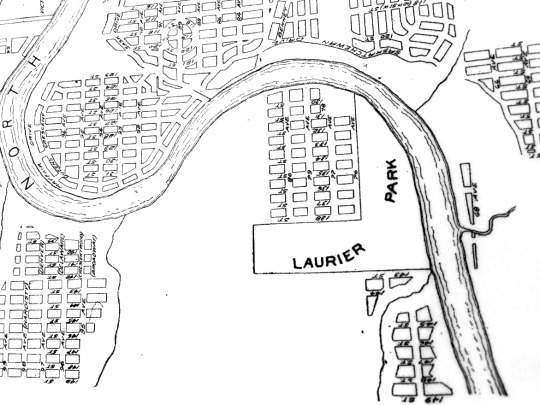
City records in the Archives indicate that some of the property holders chose to enter litigation with the City to preserve their land. There was an immediate impact: after the introduction of the Interim Development Bylaw No. 1, no more building could occur in the area. Richard Wilkin says that his Father Bill had been intending to build a house on one of the lots 8 to 14 held by the Wilkin Co. but could not do so. As owners decided to leave for a variety of reasons, the City took possession of the land that became Buena Vista Park.
The City of Edmonton District Names Advisory Committee Minutes of June 27, 1956 approved the naming of what is described as a driveway: “This will be a view drive overlooking Laurier Park, the zoo area and the Saskatchewan River. Laurier Drive is suggested because of the subdivision and neighborhood unit name which is “Laurier Heights.” The new subdivision of Laurier Heights was bounded by 87 Avenue to the north (west of 142 Street), 149 Street and Highway 2 to the west (later Whitemud freeway), Buena Vista Park and the Edmonton Valley Zoo to the east, and the North Saskatchewan River valley to the south. It was marketed by real estate companies such as Melton as a neighbourhood for young families with means and a range of amenities were built including a school at 8210 – 142 Street and community League located at 14405 - 85 Avenue; the latter comprises a community hall, outdoor rink and tennis courts.
To add to the amenities of the upper-middle-class subdivision, on July 1, 1959 the City opened the Storyland Valley Zoo, which was built on Laurier Park lands.12 The Edmonton Zoological Society, in 1926, had established a zoo in East End Park, created by the City in 1906. The 140-acre park was renamed after a 1914-visit to the city from then PM Robert Borden. This paralleled the earlier naming of the “West End Park” in 1910 for PM Sir Wilfrid Laurier. In 1930, likely for economic reasons, the City took over the operations of the Zoo from the society that had established it.
Borden Park was a popular destination not only because of the zoo but also other amenities that included the City’s first swimming pools, a tearoom, and carnival features including a carousel, roller coaster and tunnel of love. By the 1950s, declining attendance and the need for the Edmonton Exhibition Society to expand its facilities and grounds had the City focused on relocating it and the Laurier Park site seemed ideal: the City was acquiring land to create Buena Vista Park and the new Laurier Heights neighbourhood was focused on attracting upper-middle-class families. Locating a zoo there focused on children seemed ideal. To build public interest, the Names Advisory Committee designed a public naming contest and, on September 3, 1957, Storyland Valley Zoo was chosen. By 1958, plans had been developed to have a five-acre children’s zoo, two lagoons, a bridge, and mini-railway and illustrations that featured storybook characters and animals. The miniature Allen Herschell 5-16 train became so popular that a second train, the Valley Zoo Express, was added in 1965.
As popular opinion turned against zoos and they became viewed as “prisons” for animals, the City embarked on change. The zoo introduced some “natural” habitats and focused on animals native to the region and conservation of wildlife was also promoted. To reflect this change, in 1975, the name was changed to Valley Zoo and the “storyland” element was dropped. The most recent major addition, which was announced in 1910, was a $43 million project resulting in new state-of-the-art facilities.
Adjacent to Yorath House in Buena Vista Park is the home of the Edmonton Rowing Club and the White Water Paddlers. A group of rowing enthusiasts, in 1972, created a rowing club and registered as a not-for-profit society. They initially stored their shells at the Mayfair Golf Club near the foot of Groat Bridge. This was not an ideal location because of the amount of debris that gathered there. The rowers moved their facility to Saunders Lake east of Leduc. Ultimately, the City of Edmonton gifted them land and they were able to build a permanent facility with the White Water Paddlers, who registered a society in 1973 to promote canoe and kayak paddling for recreation and competitive purposes. Both societies fundraised to build the facility.

Edmonton Voyageurs Canoe Club Annual Regatta, North Saskatchewan River, August 1947. City of Edmonton Archives EA-600-333d.
Parks development from the 1950s was largely ad hoc though the locations identified in 1912-1913 documents were surprisingly prescient. This was to change: the City strengthened its efforts to improve land use planning and control by passing the 1977 Planning Act. Efforts to reinforce park development continued and culminated in the City’s 1990 Ribbon of Green: North Saskatchewan River Valley and Ravine System Concept Plan. The introduction harkens back to Frederick Todd’s recommendations made in his 1907 report. Section C is devoted to “Whitemud, Buena Vista and West Central River Valley Area” and spells out the capital costs to accomplish proposed work that was pegged to cost over $30 million. The following projects were planned:
- Whitemud Park to Laurier Park Pedestrian Bridge
- Buena Vista Park to Wm. Hawrelak Park Pedestrian Bridge
- Mayfair to MacKinnon Pedestrian Bridge
- 11.5 km main trail (West end of Ft. Edmonton Park to High Level Bridge
- 2 minor amenity nodes; Buena Vista Park improvements (road, parking and park improvements)
- access trail development
- Fort Edmonton access road relocation
- Fort Edmonton facilities (hotel)
- Valley Zoo infrastructure and
- Muttart Conservatory/Grierson Hill.
A map in the plan indicates through green arrows the area where work would take place. These measures can all be described as intended to improve access and the visitor experience rather than protecting the sites.
The death of Bette Yorath in 1991 triggered the City’s acquisition of Yorath House from her estate in 1992. The cycle of development of a “westerly park,” which began in 1907 when the City acquired the Gibbons lands, was, thus, completed through the consolidation of the Laurier/Buena Vista park lands. In 2015, Yorath House was designated as a Municipal Historic Resource. In 2019, renovations were completed. Projected at about $2 million when the property was designated, costs rose to over $5.7 million because of difficulties encountered. The official opening took place on September 20, 2019. The restorations to the house, while maintaining the look of the original exterior, would not be as respectful of the interior. The house was gutted and few original architectural features were kept other than the huge fieldstone fireplace and brick and wooden detailing. Bringing it up to code became the imperative so that it could serve its new purpose: a multi-use facility for small gatherings. The integrity of its inherent heritage value was by-and-large ignored.
Wise Use
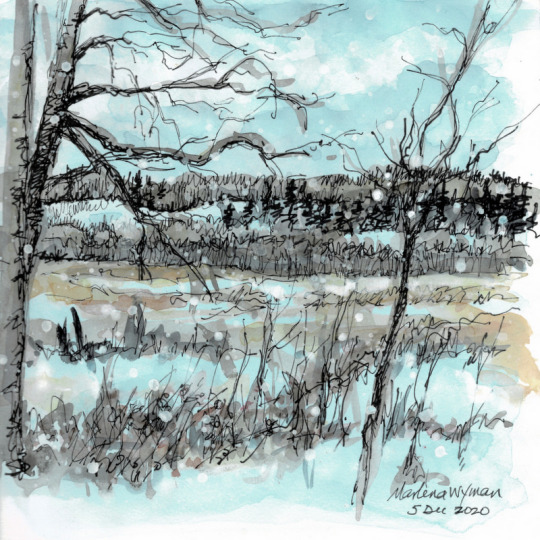
Part of the 51 acre site in the river valley that would lost to the proposed EPCOR solar farm - Marlena Wyman – ink and watercolour on paper (I painted this soon after the solar farm was first proposed).
Jane Jacobs in her 1961 book titled The Death and Life of Great American Cities attacked 1950s urban planning policy with its emphasis on slum clearance and the building of freeways in urban areas. She rejected large-scale urban development projects and insisted on preserving the integrity of old neighbourhoods because of their human scale. She was also an activist who used protests by ordinary citizens to challenge government policies and projects. She did this in her home neighbourhood of Greenwich Village in New York. After her family’s move to Toronto in 1968 to avoid her sons’ being drafted into the American military to fight in the Viet Nam War, she also championed Toronto neighbourhoods and opposed the building of the Spadina Expressway that would have seen the disappearance of swaths of historic neighbourhoods.
A fascinating National Film Board of Canada documentary titled “City Under Pressure,” directed by Theodore Conant in 1965, places Edmonton squarely in the debate between freeways and parkland.13 In 17 minutes, it captures Mayor William Hawrelak talking about development and making the point that once something is lost (by implication through slum clearance or under a paved roadway), the clock cannot be turned back. A number of un-named “talking heads” make their points; these include aldermanic and mayoral candidates, and civic officials and planners as well as engineers. Key players in the 1964 election, besides Hawrelak, were G
(Very belated) day 20: jackal
Jackal pups, more specifically. Had the privilege of seeing three of these little guys up close at the Shamwari Rehabilitation Center. You can’t handle that sort of cuteness.
(Sorry I haven’t been posting much lately. I’m deep in the throes of a major art slump right now. )
Post link
(Very belated) day 19: cape porcupine
We were on a night drive so we didn’t get a very good look at these guys at the time, but we found their quills everywhere. They’re like shedding cats, only more painful.
Post link
I haven’t had this blog for very long, but even in that short time it’s been interesting to see how different art does here compared to other social media platforms. My #2017bestnine for Tumblr vs Instagram are almost complete opposites. Thank you for the support either way though!
Post link


